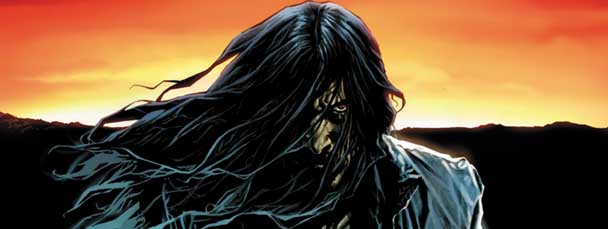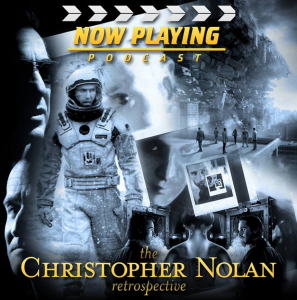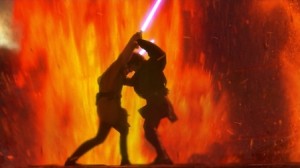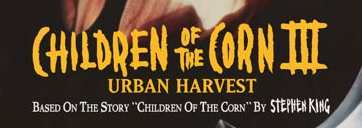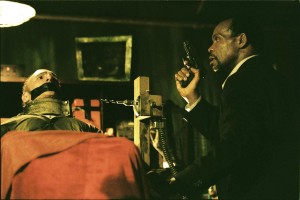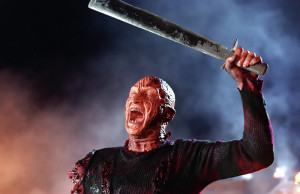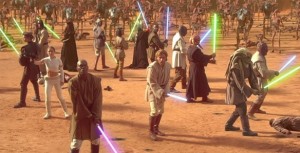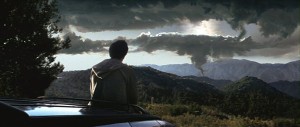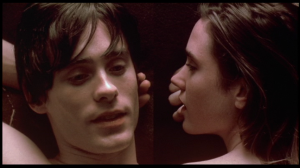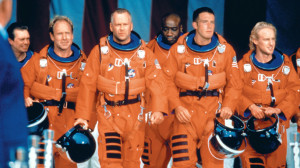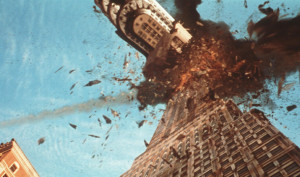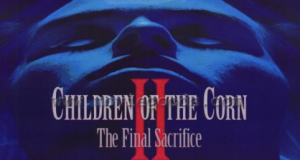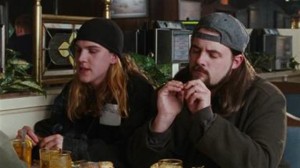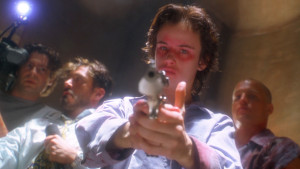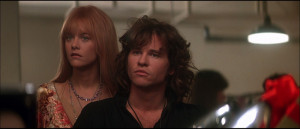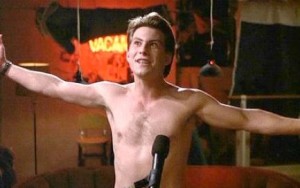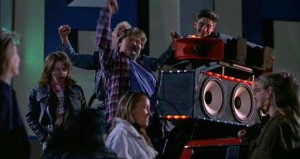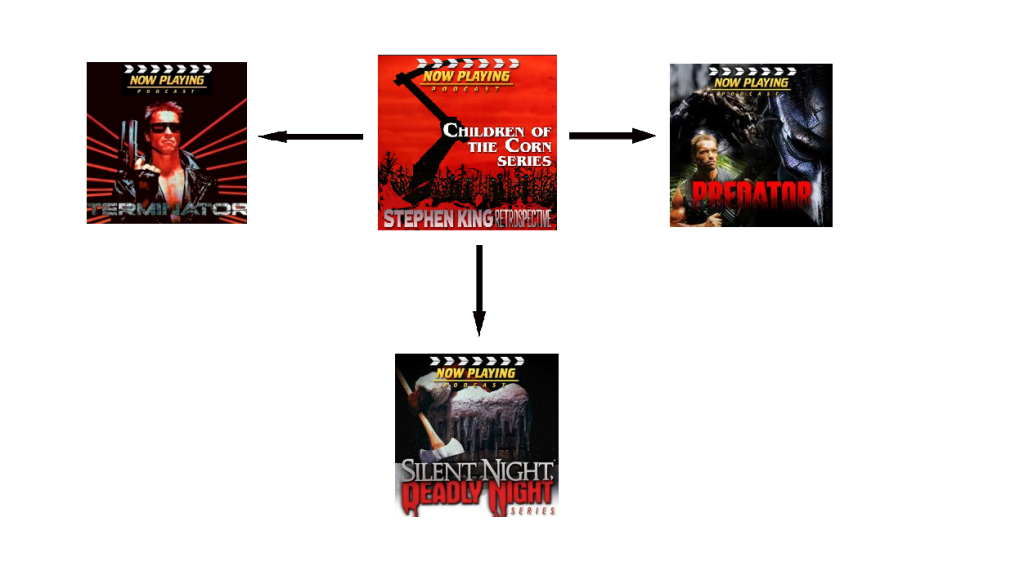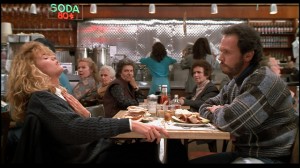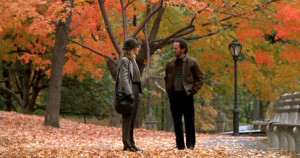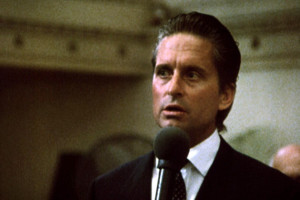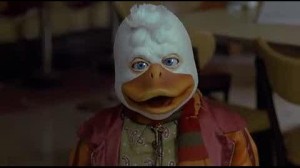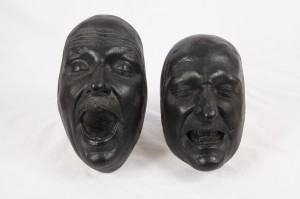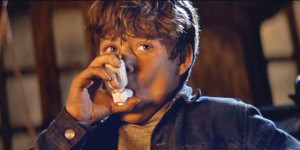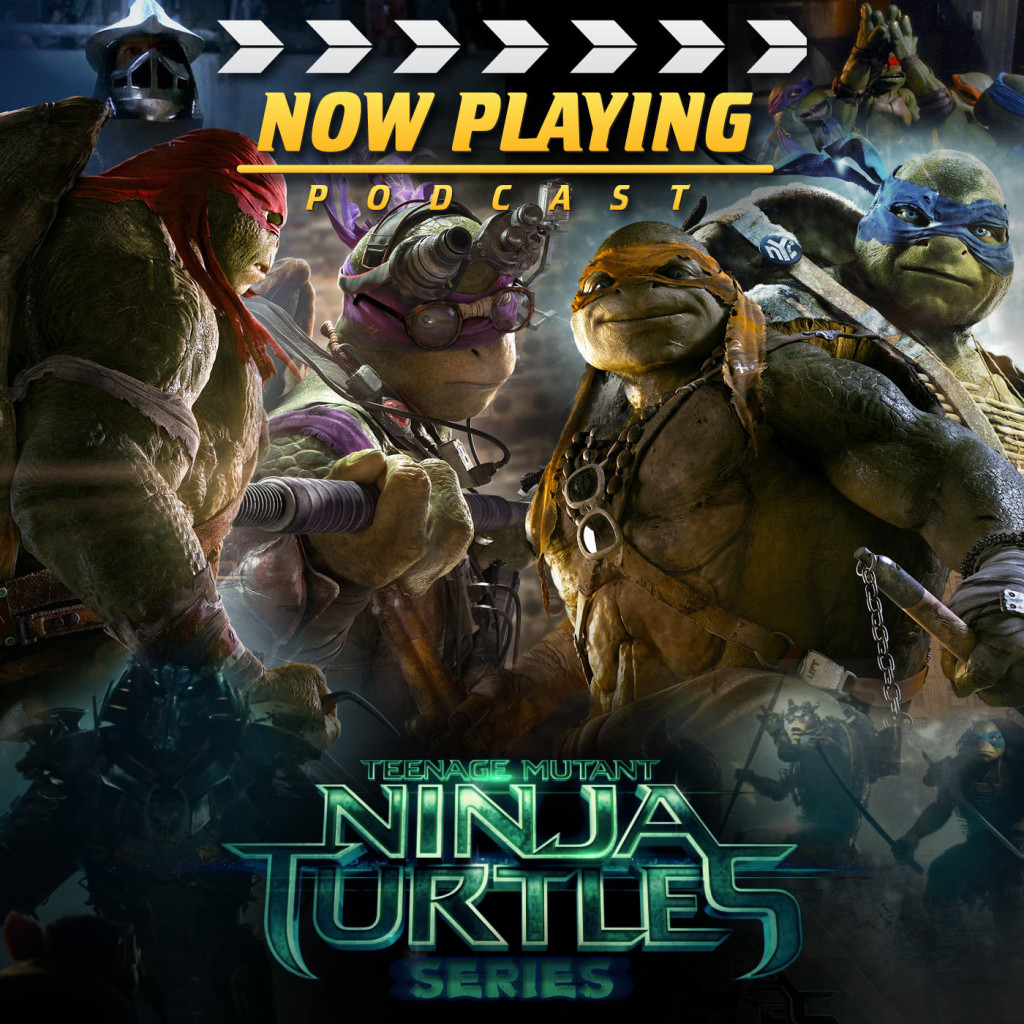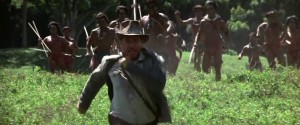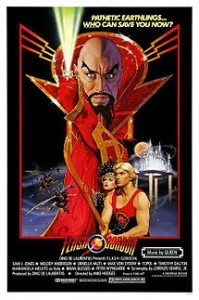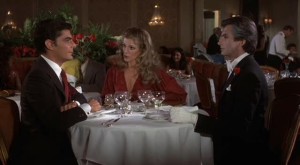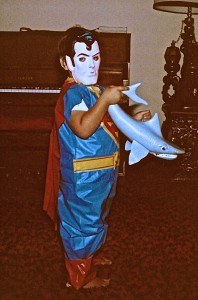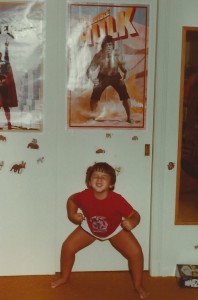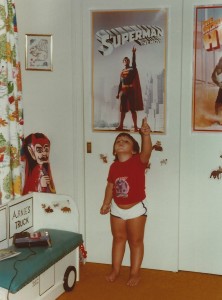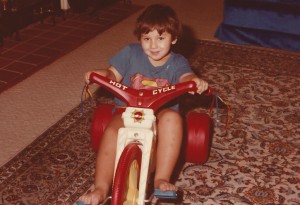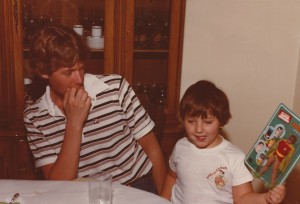The Hobbit – The Battle of the Five Armies – A Podcast Preview
The Battle of the Five Armies may only have been about 50 pages in J.R.R. Tolkien’s novel The Hobbit but it is the focus of Peter Jackson’s third and final Hobbit film. It’s elves and humans versus dwarves and orcs, with a few special surprises thrown in! How does the Battle of Five Armies compare to the Battle for Middle Earth in Return of the King, and were three films warranted to tell the story from one novel? DONATE TO SUPPORT NOW PLAYING and you can listen and find out as Jakob, Stuart, and Arnie complete their Lord of the Rings Bonus Retrospective Series!
: http://www.nowplayingpodcast.com/Podcasts/NPPLOTR06TEASE.MP3
December 26, 2014 Posted by Arnie C | Movies, Now Playing Podcast, Podcasts, Reviews | Enertainment, Film, Movies, Now Playing Podcast, Podcasts, Reviews | Comments Off on The Hobbit – The Battle of the Five Armies – A Podcast Preview
Ocean’s Eleven (2001)
In 2001 it’s doubtful anyone was begging for a remake of the 60’s Rat Pack film Ocean’s 11. It was the cast that grabbed moviegoers’ attention, filled with leading men George Clooney, Matt Damon, and Brad Pitt, plus a strong supporting cast and Julia Roberts as the female lead. But such star-studded films can often be debacles where the fun is had on the set, but not translated on the screen. Can director Steven Soderbergh pull off this intricate heist? Join Now Playing’s Three — Arnie, Stuart, and Jakob — to find out!
Arnie C: http://traffic.libsyn.com/nowplayingpodcast/NPPO1102.mp3
December 23, 2014 Posted by arniec | Movies, Now Playing Podcast, Podcasts, Reviews | Enertainment, Film, Movies, Now Playing Podcast, Podcasts, Reviews | Comments Off on Ocean’s Eleven (2001)
Willow
A young farmer must learn magic and join with a rouge warrior to travel to far away lands and save the world. No, this isn’t a review of Star Wars, but Willow–the 1988 action-fantasy film based on a story by George Lucas. Though this film closely follows the Star Wars formula can it recreate that saga’s excitement? Join Stuart, Arnie, and Jakob to find out in their review of this tale of Leprechaun meets Lord of the Rings!
Arnie C: http://traffic.libsyn.com/nowplayingpodcast/NPP044-Willow.mp3
December 18, 2014 Posted by arniec | Movies, Now Playing Podcast, Podcasts, Reviews | Enertainment, Film, Movies, Now Playing Podcast, Podcasts, Reviews | Comments Off on Willow
Ocean’s 11 (1960)
Before there was Clooney, Pitt, and Damon there was Sinatra, Martin, and Davis starring in Ocean’s 11. This 1960 crime caper was the first film to feature The Rat Pack, with Ol’ Blue Eyes himself playing Danny Ocean. In this original vision Ocean was a former World War II commander once again gathering his troops for one final mission–to rob five Vegas casinos in one night. The film has an impressive cast, but does it hold up over fifty years later? Go all in with Arnie, Jakob, and Stuart to find out!
Arnie C: http://traffic.libsyn.com/nowplayingpodcast/NPPO1101.mp3
December 16, 2014 Posted by arniec | Movies, Now Playing Podcast, Podcasts, Reviews | Enertainment, Film, Movies, Now Playing Podcast, Podcasts, Reviews | Comments Off on Ocean’s 11 (1960)
New Podcast: The Hobbit – The Desolation of Smaug – A Podcast Preview
He is fire…he is death…he is Smaug, the titular dragon in Peter Jackson’s second Hobbit film. How can a halfling and some dwarfs battle such a mighty beast? How much of the movie passes before they get there? And how many characters from the original Lord of the Rings trilogy will appear along the way? If you make a Silver or Platinum donation to Now Playing you can hear Arnie, Jakob, and Stuart discuss all this and more in this review of The Desolation of Smaug as they prepare for next week’s new release — Battle of the Five Armies!
: http://www.nowplayingpodcast.com/Podcasts/NPPLOTR05TEASE.MP3
Category: Movies & Film
December 12, 2014 Posted by Arnie C | Movies, Now Playing Podcast, Podcasts, Reviews | Enertainment, Film, Movies, Now Playing Podcast, Podcasts, Reviews | Comments Off on New Podcast: The Hobbit – The Desolation of Smaug – A Podcast Preview
Maniac (2012)
Horror film remakes have been non-stop for a decade. Of course the big films were redone, including Halloween, The Texas Chainsaw Massacre, Friday the 13th, and A Nightmare on Elm Street. Yet even smaller horror films, such as Black Christmas, I Spit on Your Grave, and Willard have seen updates for the 21st century. In 2012 another cult splatter film was added to that roster–Maniac. Closely based on the 1980 original, but with some daring style choices, this new Maniac did not find wide release but is slowly growing its own cult following. Can Hobbit Elijah Wood compete with Joe Spinell’s personification of serial killer Frank? Listen to find out!
Arnie C: http://traffic.libsyn.com/nowplayingpodcast/NPPMANIAC02.mp3
December 9, 2014 Posted by arniec | Movies, Now Playing Podcast, Podcasts, Reviews | Enertainment, Film, Movies, Now Playing Podcast, Podcasts, Reviews | Comments Off on Maniac (2012)
Books & Nachos THE STAND Review — Update
Stephen King’s writing of The Stand was fraught with delays. He suffered writer’s block, lost his way with the story, and ultimately had to release Night Shift as a stop-gap so his publishers had something to release.
It feels appropriate, then, that my Books & Nachos review seems to be going through the same cycle.
As host of the Books & Nachos podcast I’ve reviewed over 50 novels, short stories, comics, and non-fiction works. I’m aware of the work involved, which includes not only reading the work but researching its history and truly contemplating the meaning of the book. Yet, even with this experience the review of The Stand is unlike anything I’ve undertaken thus far. As my review of The Stand is delayed, I’ve received several e-mails asking about the release and I felt it important to update you, the constant listener, on my progress.
When I look back on 2014 the dominant memory I’ll have is King’s epic novel. I have read this book three times, both the originally published 1978 version, the slightly revised 1980 Signet paperback, and then the 1990 Complete & Uncut Edition. I took copious notes on each. I read several accounts of King’s writing of the novel, both major and trivial. I watched The Stand mini-series (which we reviewed at Now Playing Podcast) and heard King’s commentary, which also added light on his prose work. I’ve even read the Marvel Comics adaptation so I can review it as well.
But trying to take this information and distill it into one podcast has been daunting. I did, for quite some time, suffer from writer’s block–my introduction was written, rewritten, and rewritten again but I couldn’t bring myself to tackle the analysis. I had hoped to have my review of The Stand done by November 1, ready for release around Thanksgiving with our review of the movie. Needless to say, I missed that date due to the writer’s block.
Now, I’m excited to say, the review is written, but due to the Thanksgiving holiday as well as illness I have been unable to record. With a holiday schedule growing ever-more-hectic as we approach Christmas, the time I hoped to record has been taken by other more immediate, personal concerns.
That said, progress is being made! While I cannot provide an exact release date for this review, it will be out before the Christmas holiday (barring more illness).
In the end, my thought is this: those anxious for this review may be frustrated by the delay, but that will be forgotten. This review will be online for people to hear for years, and I’d rather put out a product I can be 100% proud of rather than rush to meet a deadline and have a review that doesn’t satisfy me or you.
Additionally, this delay is not going to impact the reviews coming down the pike. I am well into reading King’s next work The Long Walk and that review will be out in early January, followed quickly by my review of The Dead Zone which will coincide with the Now Playing Podcast review of that movie the week of January 12th.
In the meantime, I hope you’ll join me at Now Playing Podcast for our current series. On the main feed we have reviews of the horror movie Maniac and, coming tomorrow, the review of the 2012 remake. And on our donation feed we have reviews of all Peter Jackson’s Lord of the Rings and The Hobbit films, as well as reviews of all seven Leprechaun movies! Plenty of content to keep you entertained while I record and edit The Stand.
Thank you for your patience, and I will update again when the review is ready for you to hear!
December 8, 2014 Posted by Arnie C | Books, Now Playing Podcast, Podcasts, Reviews | Books & Nachos, Delay, Schedule, Stephen King, The Dead Zone, The Long Walk, The Stand | 2 Comments
Maniac (1980)
1980 saw the release of several memorable slasher films, including Friday the 13th, Silent Scream, New Year’s Evil, and Prom Night. Yet of all the 1980s slashers none may be more controversial than Maniac–a low budget splatter film with its unrated violence and Tom Savini’s gore effects. The film has grown a cult following through home video but maniacal murderer Frank still lacks the name recognition of a Jason or a Michael Myers–yet it did warrant a 2012 remake starring Elijah Wood. Does Joe Spinell’s psycho killer deserve a place in the pantheon of horror icons? Listen to find out!
Arnie C: http://traffic.libsyn.com/nowplayingpodcast/NPPMANIAC01.mp3
December 2, 2014 Posted by arniec | Movies, Now Playing Podcast, Podcasts, Reviews | Enertainment, Film, Movies, Now Playing Podcast, Podcasts, Reviews | Comments Off on Maniac (1980)
New Podcast: Lord of the Rings (1978) – A Podcast Preview
Peter Jackson’s adaptation of Lord of the Rings runs over 9 hours, or 12 hours for the extended cuts. By contrast, in 1978 Ralph Bakshi’s animated adaptation claimed to tell the saga in just over two hours. In truth, this theatrical cartoon adapts half of J.R.R. Tolkien’s bestselling saga, and left audiences anticipating a conclusion that would never come. Can almost two novels be told in two hours? If you make a Platinum donation to Now Playing Podcast you can listen and find out!
: http://www.nowplayingpodcast.com/Podcasts/NPPLOTRANI02TEASE.MP3
Category: Movies & Film
November 30, 2014 Posted by Arnie C | Movies, Now Playing Podcast, Podcasts, Reviews | Enertainment, Film, Movies, Now Playing Podcast, Podcasts, Reviews | Comments Off on New Podcast: Lord of the Rings (1978) – A Podcast Preview
The Stand
It’s considered by many to be Stephen King’s best novel of all time — The Stand. King’s fourth novel told of a superflu that wipes out humanity and sets the stage for an epic battle of good versus evil. In 1994 ABC aired a mammoth, four night mini-series that took the top three spots in the Nielsen ratings. Now it’s time for Arnie, Jakob, and Stuart to take their Stand and review this miniseries. Can the book’s epic quality be captured on a TV budget? Listen and find out!
Arnie C: http://traffic.libsyn.com/nowplayingpodcast/NPP043-TheStand.mp3
November 25, 2014 Posted by arniec | Movies, Now Playing Podcast, Podcasts, Reviews | Enertainment, Film, Movies, Now Playing Podcast, Podcasts, Reviews | Comments Off on The Stand
New Podcast: The Hobbit (1977) — A Podcast Preview
It took forty years for J.R.R. Tolkien’s Middle Earth saga to reach screens. Despite the mass popularity of The Hobbit and Lord of the Rings books, only a short feature had been realized. Finally, in 1977, the animation studio Rankin/Bass brought the story of Bilbo Baggins to TV audiences everywhere with their animated adaptation of The Hobbit. Now Arnie, Stuart, and Jakob watch and review this NBC prime-time special as the first volume in a trilogy of animated Middle Earth films. Make a Platinum level donation to Now Playing and you can hear it now!
: http://www.nowplayingpodcast.com/Podcasts/NPPLOTRANI01TEASE.MP3
Category: Movies & Film
November 24, 2014 Posted by Arnie C | Movies, Now Playing Podcast, Podcasts, Reviews | Enertainment, Film, Movies, Now Playing Podcast, Podcasts, Reviews | Comments Off on New Podcast: The Hobbit (1977) — A Podcast Preview
Big Hero 6
Ever since Disney purchased Marvel Comics a family-friendly superhero cartoon was all but guaranteed. But it’s not the Avengers, the Fantastic Four, or the X-Men who star in Disney’s first Marvel animated feature, it’s the little-known Asian team Big Hero 6. Many changes have happened adapting the team from the page to the screen, but is the result super? Join the Podcast Hero 3 of Arnie, Stuart, and Jakob to find out!
Arnie C: http://traffic.libsyn.com/nowplayingpodcast/NPP042-BigHero6.mp3
November 17, 2014 Posted by arniec | Movies, Now Playing Podcast, Podcasts, Reviews | Enertainment, Film, Movies, Now Playing Podcast, Podcasts, Reviews | Comments Off on Big Hero 6
Plastic Galaxy: The Story of Star Wars Toys
George Lucas’ 1977 space fantasy Star Wars changed the way American audiences consumed films. More, though, it also changed the landscape for movie merchandising, with more money being made on toys, games, and collectibles than on the movies themselves. Now the documentary Plastic Galaxy looks back at the first generation of Star Wars toys, released between 1977 and 1985 from Kenner. Does this film capture the childhood magic of Star Wars figures, and can the documentary appeal to anyone not already obsessed with little plastic Stormtroopers? Find out in this special Now Playing/Star Wars Action News crossover podcast hosted by Marjorie, Arnie, and Jerry!
Arnie C: http://traffic.libsyn.com/nowplayingpodcast/NPP041-PlasticGalaxy.mp3
November 13, 2014 Posted by arniec | Movies, Now Playing Podcast, Podcasts, Reviews | Enertainment, Film, Movies, Now Playing Podcast, Podcasts, Reviews | Comments Off on Plastic Galaxy: The Story of Star Wars Toys
Interstellar
Christopher Nolan’s film Interstellar tells of an Earth that is dying; those who don’t starve to death will suffocate in an atmosphere turning toxic. Our only hope comes in the form of Cooper (Matthew McConaughey), a farmer who crashes NASA’s secret base thanks to mysterious messages from beyond. It’s an ambitious film filled with hard science and lots of discussions of love. Is it a film that has found its place in the stars, or that has crashed to its place in the dirt? Join Arnie, Stuart, and Jakob to find out!
Arnie C: http://traffic.libsyn.com/nowplayingpodcast/NPPNOLAN06.mp3
November 10, 2014 Posted by arniec | Movies, Now Playing Podcast, Podcasts, Reviews | Enertainment, Film, Movies, Now Playing Podcast, Podcasts, Reviews | Comments Off on Interstellar
New look for Now Playing
VENGANZA MEDIA DEBUTS NEW LOOK FOR NOW PLAYING PODCAST
Website redesign gives users access to new content, show release schedule
FOR IMMEDIATE RELEASE
Springfield, Ill – November 5, 2014- Today Venganza Media Inc., the producers of popular collecting podcast Star Wars Action News, unveiled a new website for its flagship program, Now Playing Podcast. The show’s worldwide audience now has easier access to its extensive film review archive and schedule, as well as a redesigned streaming media player and expanded content from show contributors.
“Now that we’re closing in on 500 movie reviews, it seemed a natural step forward to improve the user experience,” said Now Playing Podcast creator and host Arnie Carvalho. “Our listeners keep us on-the-air, they’ve asked for the ability to easily view and search our upcoming review calendar as well as our archives. We want them to know that we listen to them as well.”
The new show calendar can be accessed from the Now Playing Podcast home page, and will include details of weekly film reviews as well as series’ covered during Now Playing’s bi-annual pledge drive.
The website’s revamped archive page includes a drop-down menu — another requested feature — that will allow users to easily search and select their favorite Now Playing Podcast reviews.
In addition to the updated search and schedule features, users will find expanded biographies of the Now Playing Podcast staff, as well as links to news content from the company blog, the Venganza Media Gazette.
About Venganza Media Inc.
Based in Springfield, Ill., Venganza Media Inc. is a privately-owned multimedia production facility and home to the Venganza Media Podcasting Network. Film fans and collectors worldwide know Venganza as the producer of Star Wars Action News, Marvelicious Toys, and the company’s flagship program, Now Playing Podcast. Since its formation in 2005, Venganza has delivered thousands of hours of entertainment to listeners, while its staff and fleet of contributors have established the company as a premier source for film reviews, celebrity interviews, and collecting news for audiences of all ages.
About Now Playing Podcast
From its humble beginnings as a short-form, off-the-cuff movie review show, Now Playing Podcast has grown into one of the most successful and celebrated independent programs online and consistently ranks among iTunes’ Top 10 TV/Film podcasts. Its ability to stand out in a crowded field is largely attributed to Now Playing’s highly-acclaimed retrospective format, keeping listeners engaged week-after-week as its panel of critics chronicle decades of hits-and-misses while maneuvering Hollywood’s hectic release schedule.
Facebook: Now Playing Podcast
Twitter: @NowPlayingPod
November 7, 2014 Posted by Jason Latham | News, Now Playing Podcast, Podcasts | Arnie Carvalho, Marvelicious Toys, Now Playing Podcast, Star Wars Action News, Venganza Media | Comments Off on New look for Now Playing
The Prestige
After bringing respectability back to the Dark Knight with the 2005 film Batman Begins Nolan reteamed with two of that film’s leading actors, Christian Bale and Michael Caine, for The Prestige–an 1899 period piece about two competing illusionists. Does Nolan’s non-chronological storytelling and slight of hand produce a prestigious film? Join Arnie, Stuart, and Jakob to find out!
Arnie C: http://traffic.libsyn.com/nowplayingpodcast/NPPNOLAN05.mp3
November 4, 2014 Posted by arniec | Movies, Now Playing Podcast, Podcasts, Reviews | Enertainment, Film, Movies, Now Playing Podcast, Podcasts, Reviews | Comments Off on The Prestige
New Podcast: Leprechaun: Origins – A Podcast Preview
The Leprechaun is back and he wants his gold, but he’s no longer a rhyming fool but instead a vicious, feral creature in WWE’s reboot and reimagining of the Leprechaun franchise. Can a Lep be truly frightening, or was it just scary that they tried? If you Trick or Treat Now Playing with a pledge then you can listen and find out!
: http://nowplayingpodcast.com/Podcasts/NPPLEP07TEASE.MP3
Category: Movies & Film
October 31, 2014 Posted by Arnie C | Movies, Now Playing Podcast, Podcasts, Reviews | Enertainment, Film, Movies, Now Playing Podcast, Podcasts, Reviews | Comments Off on New Podcast: Leprechaun: Origins – A Podcast Preview
Insomnia
After directing the indie hit Memento director Christopher Nolan was chosen by producer Steven Soderbergh to direct Insomnia–a crime thriller based on the 1997 Norwegian film of the same name. The result was Nolan’s first mainstream studio film starring Al Pacino and Robin Williams. Does a film about a man who can’t sleep live up to a film about a man with no memory? Don’t lose any sleep thinking about it, just join Stuart, Arnie, and Jakob to find out!
Arnie C: http://traffic.libsyn.com/nowplayingpodcast/NPPNOLAN04.mp3
October 28, 2014 Posted by arniec | Movies, Now Playing Podcast, Podcasts, Reviews | Enertainment, Film, Movies, Now Playing Podcast, Podcasts, Reviews | Comments Off on Insomnia
New Podcast: Leprechaun: Back 2 tha Hood – A Podcast Preview
The Leprechaun struck gold when he went to the Hood, but will he find the same returns going Back 2 tha Hood? Stuart, Arnie, and Jakob find out in this week’s gold Donation Series podcast as they watch and review Warwick Davis’ final performance as the greedy green guy. Will their ratings match the color of the Lep’s outfit? If you make a pledge and support Now Playing you can listen and find out!
: http://nowplayingpodcast.com/Podcasts/NPPLEP06TEASE.MP3
Category: Movies & Film
October 27, 2014 Posted by Arnie C | Movies, Now Playing Podcast, Podcasts, Reviews | Enertainment, Film, Movies, Now Playing Podcast, Podcasts, Reviews | Comments Off on New Podcast: Leprechaun: Back 2 tha Hood – A Podcast Preview
New Podcast: Memento – Chronological Review
In 2001 Christopher Nolan broke into mainstream filmmaking with Memento–a noir murder mystery about a man who had no short-term memory trying to find his wife’s killer. With a quirky concept and an editing style specifically used to play with the audience’s own memories the result was an indie hit that launched the director into the public eye. Is this Tarantino-styled film remembered fondly by Arnie, Jakob, and Stuart? Do they remember it at all? Listen to find out!
: http://nowplayingpodcast.com/Podcasts/NPPNOLAN03-Chronological-HQ.MP3
Category: Movies & Film
October 24, 2014 Posted by Arnie C | Movies, Now Playing Podcast, Podcasts, Reviews | Enertainment, Film, Movies, Now Playing Podcast, Podcasts, Reviews | Comments Off on New Podcast: Memento – Chronological Review
New Podcast: Memento
In 2001 Christopher Nolan broke into mainstream filmmaking with Memento–a noir murder mystery about a man who had no short-term memory trying to find his wife’s killer. With a quirky concept and an editing style specifically used to play with the audience’s own memories the result was an indie hit that launched the director into the public eye. Is this Tarantino-styled film remembered fondly by Arnie, Jakob, and Stuart? Do they remember it at all? Listen to find out!
: http://nowplayingpodcast.com/Podcasts/NPPNOLAN03.MP3
Category: Movies & Film
October 21, 2014 Posted by Arnie C | Movies, Now Playing Podcast, Podcasts, Reviews | Enertainment, Film, Movies, Now Playing Podcast, Podcasts, Reviews | Comments Off on New Podcast: Memento
Memento – Chronological Review
In 2001 Christopher Nolan broke into mainstream filmmaking with Memento–a noir murder mystery about a man who had no short-term memory trying to find his wife’s killer. With a quirky concept and an editing style specifically used to play with the audience’s own memories the result was an indie hit that launched the director into the public eye. Is this Tarantino-styled film remembered fondly by Arnie, Jakob, and Stuart? Do they remember it at all? Listen to find out!
Arnie C: http://traffic.libsyn.com/nowplayingpodcast/NPPNOLAN03-Chronological-HQ.mp3
October 21, 2014 Posted by arniec | Movies, Now Playing Podcast, Podcasts, Reviews | Enertainment, Film, Movies, Now Playing Podcast, Podcasts, Reviews | Comments Off on Memento – Chronological Review
Memento – Reversed Review
In 2001 Christopher Nolan broke into mainstream filmmaking with Memento–a noir murder mystery about a man who had no short-term memory trying to find his wife’s killer. With a quirky concept and an editing style specifically used to play with the audience’s own memories the result was an indie hit that launched the director into the public eye. Is this Tarantino-styled film remembered fondly by Arnie, Jakob, and Stuart? Do they remember it at all? Listen to find out!
Arnie C: http://traffic.libsyn.com/nowplayingpodcast/NPPNOLAN03.mp3
October 20, 2014 Posted by arniec | Movies, Now Playing Podcast, Podcasts, Reviews | Enertainment, Film, Movies, Now Playing Podcast, Podcasts, Reviews | Comments Off on Memento – Reversed Review
New Podcast: Leprechaun: In the Hood – A Podcast Preview
The Leprechaun has always had one foot in horror, the other in comedy. With his fifth film, Leprechaun: In the Hood the series focuses far more on the comedic side as the green meanie smokes weed, raps, and becomes south central’s foremost pimp–all while trying to reclaim his magic flute. If it sounds outrageous, that’s because it is. But does this inner-city scene suit the rhyming rascal? A friend with weed is a friend indeed, but a friend who donated Gold is the best I’m told! So make a Platinum or Gold donation to Now Playing, then you can listen to find out!
: http://nowplayingpodcast.com/Podcasts/NPPLEP05TEASE.MP3
Category: Movies & Film
October 17, 2014 Posted by Arnie C | Movies, Now Playing Podcast, Podcasts, Reviews | Enertainment, Film, Movies, Now Playing Podcast, Podcasts, Reviews | Comments Off on New Podcast: Leprechaun: In the Hood – A Podcast Preview
Following
Christopher Nolan is one of the most acclaimed directors currently working in American cinema. His films bend the mind and break the box office–his Batman film The Dark Knight is the fourth highest grossing film in the US. Now Arnie, Jakob, and Stuart flash back to the director’s first film–the micro-budgeted Following. With almost no money did Nolan’s talent shine through, or is this a glorified home movie? Join us to find out! Playing during their Fall, 2014 donation drive you can join Arnie, Stuart, and Jakob and find out!
Arnie C: http://traffic.libsyn.com/nowplayingpodcast/NPPNOLAN02.mp3
October 14, 2014 Posted by arniec | Movies, Now Playing Podcast, Podcasts, Reviews | Enertainment, Film, Movies, Now Playing Podcast, Podcasts, Reviews | Comments Off on Following
After lows of ‘Corn’ series, ‘Now Playing’ looks forward to Nolan films
Now Playing Podcast host Arnie Carvalho once read an email from a listener urging him to review only bad movies because it leads to funnier conversations.
“He said we should just be a comedy show,” the film critic said from his Manhattan hotel room on Saturday, while on a break from covering New York Comic Con.
Did that listener have a point?
“None of us wants that,” Carvalho answered. “We enjoy covering all types of movies, but if we only watched low-rent trash I think our souls would die.”
It’s a marvel he and his Now Playing co-hosts — Stuart Atkinson and Jakob Brewster – even have any life left in them after enduring nine films based on Stephen King’s Children of the Corn.
This week’s review of Children of the Corn: Genesis not only marks the climax of the Corn saga, but also an exhausting exploration of King’s Night Shift collection; more than two dozen reviews of mostly forgettable film adaptations like The Mangler, Graveyard Shift and Trucks.
Few films in the Night Shift series have been worthy of a recommend, but that hasn’t kept hardcore Now Playing listeners from making the show one of the highest rated on iTunes throughout 2014, with seven of the nine Corn reviews appearing in the Top 10 rankings for TV/Film podcasts.
“I really expected listenership to drop off as we got deep in those fields,” Carvalho said. “But our listeners are awesome.”
“I only half-jokingly say more people downloaded our review of Children of the Corn 7 than actually saw Children of the Corn 7.”
With Night Shift in the rear view, Now Playing Podcast launches its next retrospective on Tuesday: A five-episode study of director Christopher Nolan’s filmography, leading up to next month’s Interstellar.
After considering other horror properties to follow Corn — including Hellraiser and The Amityville Horror — Carvalho shifted gears and lobbied hard for a director-focused retrospective, targeting Nolan after Now Playing previously covered his Dark Knight Trilogy and Inception.
“The hosts needed some meatier films to chew on, and I also think listeners want to hear about movies they’ve actually seen,” he joked. “With the good movies we usually can have deeper conversations about filmmaking, themes, and intent.”
“The problem with the Corn series was that by the 9th film there was nothing left to say, it’s like the old joke about the definition of insanity.”
October 11, 2014 Posted by Jason Latham | Now Playing Podcast, Podcasts | Arnie Carvalho, Children of the Corn, christopher nolan, dark knight, graveyard shift, inception, interstellar, jakob brewster, mangler, Now Playing Podcast, Review, Stephen King, stuart atkinson, trucks | 2 Comments
New Podcast: Leprechaun 4: In Space – A Podcast Preview
No woman on Earth would want to marry the Leprechaun, so our Irish imp has gone to space to find his bride! Can Warwick Davis’ Leprechaun bring the fun frights in this Aliens spoof? If you make a pledge and support Now Playing during their Fall, 2014 donation drive you can join Arnie, Stuart, and Jakob and find out!
: http://www.nowplayingpodcast.com/Podcasts/NPPLEP04TEASE.MP3
Category: Movies & Film
October 11, 2014 Posted by Arnie C | Movies, Now Playing Podcast, Podcasts, Reviews | Enertainment, Film, Movies, Now Playing Podcast, Podcasts, Reviews | Comments Off on New Podcast: Leprechaun 4: In Space – A Podcast Preview
Annabelle
Last summer’s supernatural horror film The Conjuring scared up big profits for Warner Bros. Pictures. While ghostly Bathsheba terrorized the house, it was possessed doll Annabelle that stole the show. Now the porcelain poltergeist is back in her own spin-off film! The film scored much green in its opening weekend, but will it get green arrows from the Now Playing hosts? Listen to find out!
Arnie C: http://traffic.libsyn.com/nowplayingpodcast/NPPCONJUR02.mp3
October 10, 2014 Posted by arniec | Movies, Now Playing Podcast, Podcasts, Reviews | Enertainment, Film, Movies, Now Playing Podcast, Podcasts, Reviews | Comments Off on Annabelle
Children of the Corn: Genesis
When Tim and Allie’s car breaks down on the desert streets of California the only help they can find is from nearby farmer Preacher and his Ukrainian wife Oksana. But one night in that house may lead to Tim and Allie’s doom as strange occurrences terrorize the young couple. What is going on, and how in the world is this a Children of the Corn film? Join Arnie, Stuart, and Jakob’s review of Children of the Corn: Genesis for their the final film in this series (for now), and reflect on all the movies adapted from Stephen King’s Night Shift stories.
Arnie C: http://traffic.libsyn.com/nowplayingpodcast/NPPCOTC09.mp3
October 7, 2014 Posted by arniec | Movies, Now Playing Podcast, Podcasts, Reviews | Enertainment, Film, Movies, Now Playing Podcast, Podcasts, Reviews | Comments Off on Children of the Corn: Genesis
The Conjuring
Last summer a low budget horror film surprised box office pundits and horror fans alike. The weekend the big-budget films RED 2 and R.I.P.D. opened, the box office champion was The Conjuring. Directed by Saw co-creator James Wan, Conjuring seemed like a retread of the horror he showcased in 2010’s Insidious, but with a based-on-real-life twist and the film became the top grossing horror film of the year. Now, as the spin-off film Annabelle hits theaters, Marjorie, Stuart, and Arnie go ghost hunting once more. Is this tale of a pesky poltergeist worth watching? Listen and find out!
Arnie C: http://traffic.libsyn.com/nowplayingpodcast/NPPCONJUR01.mp3
October 3, 2014 Posted by arniec | Movies, Now Playing Podcast, Podcasts, Reviews | Enertainment, Film, Movies, Now Playing Podcast, Podcasts, Reviews | Comments Off on The Conjuring
New Podcast: Leprechaun 3 – A Podcast Preview
Las Vegas is a town full of folks hoping to strike gold, and where there is gold the Leprechaun can’t be far behind! Leprechaun 3 takes the titular tiny terror and sets him loose in Sin City as he attempts to reclaim his missing magic shilling. Does the Leprechaun’s magic work on the Vegas strip? What happens on the donation bonus podcast stays on the donation bonus podcast, so donate to Now Playing Podcast and find out!
: http://www.nowplayingpodcast.com/Podcasts/NPPLEP03TEASE.MP3
Category: Movies & Film
October 3, 2014 Posted by Arnie C | Movies, Now Playing Podcast, Podcasts, Reviews | Enertainment, Film, Movies, Now Playing Podcast, Podcasts, Reviews | Comments Off on New Podcast: Leprechaun 3 – A Podcast Preview
Corn Connection: No stars, but good ‘Now Playing’ links in ‘Corn’ remake
Scanning IMDB resumes for this week’s Corn Connection entry really made me feel old. 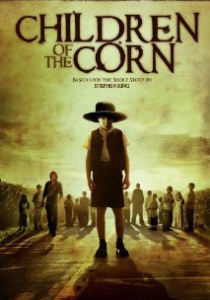
It wasn’t so bad during the first seven films, because I knew most of the “children” in the Corn series had aged by now, and some of them are older than I am. But I got a stark reminder of my age while looking through the credits of the 2009 Children of the Corn remake for this week’s episode of Now Playing Podcast.
But this series is not called “Gettin too old for this #&$%.” So let’s take a look at where you can find the 2009 Corn players in the Now Playing archives.
It wasn’t easy.
Kandyse McClure (Vicky Stanton) – Carrie Retrospective
The biggest “star” with any link to Now Playing Podcast is McClure, who takes over for Linda Hamilton in Corn. If anyone watching the film has that funny feeling she’s been in another poorly-received Stephen King remake, it’s because she also starred as Sue Snell in the 2002 TV movie remake of Carrie.
That film was reviewed in the second entry in Now Playing’s massive Stephen King Retrospective Series. It was only last fall, but since then the show has covered so much King, there should be something to make any fan happy in the archives.
Daniel Newman (Malachai) – Batman Retrospective
The actors in this Corn film are not stars, and they’re not mentioned by name on Now Playing Podcast. But at least the shows are still entertaining.
Newman, who plays Malachai in 2009’s Children of the Corn, played “Thug No. 2 in Basement” in Christopher Nolan’s The Dark Knight Rises. That’s a really good listen in the Now Playing archives, and will help you get ready for the upcoming Christopher Nolan Retrospective Series, which is coming as soon as Arnie, Stuart and Jakob find a way out of the cornfield.
Robert Gerdisch (Preacher Boy) – Superman Retrospective
Gerdisch played Whitney Fordham in 2013’s Man of Steel. I assume that character is similar to the character Whitney Fordman from Smallville, but you never know with Zack Snyder.
Leo Howard (Additional Voices) – G.I. Joe Retrospective
Yes, even doing “additional voices” can count as a connection. And this kid Howard has been on camera, he appeared as “Young Snake-Eyes” in 2009’s G.I. Joe: The Rise of Cobra.
So, for an unimpressive sequel with an unimpressive cast, those are some pretty impressive Now Playing links.
Did we miss anyone? If you spot an actor or actress with a connection to Now Playing Podcast leave a comment and help a fellow listener!
October 1, 2014 Posted by Jason Latham | Now Playing Podcast, Podcasts | Batman, Carrie, children of the corn remake, christopher nolan, g.i. joe, g.i. joe: the rise of cobra, kandyse mcclure, leo howard, man of steel, Now Playing Podcast, robert gerdisch, sue snell, Superman, the dark knight rises | Comments Off on Corn Connection: No stars, but good ‘Now Playing’ links in ‘Corn’ remake
New Podcast: The Lord of the Rings – The Return of the King — A Podcast Preview
After three years Lord of the Rings fans finally had their epic conclude with Peter Jackson’s The Lord of the Rings: The Return of the King. Now Arnie, Stuart, and Jakob conclude their review of Jackson’s original Rings trilogy. With huge battles and Frodo’s personal battle of wills with the ring, this was Jackson’s most ambitious film in the trilogy, and it took home plenty of Oscar gold. But will it also take home recommends from the Now Playing hosts? If you make a pledge in support of our show you can now listen and find out!
: http://www.nowplayingpodcast.com/Podcasts/NPPLOTR03TEASE.MP3
Category: Movies & Film
September 30, 2014 Posted by Arnie C | Movies, Now Playing Podcast, Podcasts, Reviews | Enertainment, Film, Movies, Now Playing Podcast, Podcasts, Reviews | Comments Off on New Podcast: The Lord of the Rings – The Return of the King — A Podcast Preview
Children of the Corn (2009)
Stephen King’s short story “Children of the Corn” ties Carrie for being adapted for screens three times. The first was the “Dollar Baby” Disciples of the Crow, then in 1984 came the well-known film starring Linda Hamilton. Finally in 2009 came a new Children of the Corn, premiering initially on the SciFi channel before getting an unrated home video release. Is the third time the charm for He Who Walks Behind the Rows? Join Arnie, Jakob, and Stuart to find out!
Arnie C: http://traffic.libsyn.com/nowplayingpodcast/NPPCOTC08.mp3
September 29, 2014 Posted by arniec | Movies, Now Playing Podcast, Podcasts, Reviews | Enertainment, Film, Movies, Now Playing Podcast, Podcasts, Reviews | Comments Off on Children of the Corn (2009)
Corn Connection: ‘Revelation’ boasts some of series’ best links
The seventh installment of this Corn Connection series is a step up from the previous one, even if the film we’re talking about, Children of the Corn: Revelation, is every bit as unbearable as Children of the Corn 666: Isaac’s Return.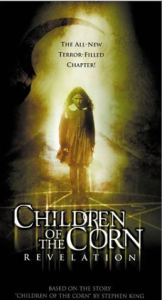
The difference between the two is variety. While 666 featured seemed to find the same connections over and over (Robocop, Corn), the Revelation cast has connections to more than a half-dozen Now Playing Podcast series’ that haven’t been written about in this series.
So, if you’re wrapping up the latest episode in the Now Playing Podcast Children of the Corn Retrospective Series, here’s where you can find some of that film’s stars in the Now Playing universe.
Michael Ironside (Priest) – Philip K. Dick Retrospective, The Karate Kid Retrospective, Terminator Retrospective, X-Men Retrospective
Let’s start with the obvious; Michael Ironside probably can’t walk down the street without someone shouting, “See you at the party Richter!”
It’s one of the actor’s best known roles, and Total Recall was reviewed by Now Playing back during the 2011 Philip K. Dick Retrospective.
Ironside also had roles in The Next Karate Kid and Terminator Salvation, two films reviewed in 2010 and 2009, respectively.
And he also appeared as the captain of a battleship in X-Men First Class, although he wasn’t credited. Why he wasn’t credited is a mystery I haven’t not yet Googled. It’s almost a distraction that he wasn’t credited, like I’m thinking more about that than I am about First Class.
Ron Selmour (uncredited) – Blade Retrospective, Black Christmas Retrospective, Tron Retrospective, Riddick Retrospective
Selmour had bit parts in The Chronicles of Riddick, the Black Christmas remake and Tron Legacy. But as soon as I saw his face on IMDB and his Blade: Trinity credit I said, “I know that dude!”
He’s one of the “Nightstalkers” that teams up with Wesley Snipes for about five minutes before he gets killed. I think he gets one line and then gets taken out alongside Patton Oswalt. And his character is named Dex. And Oswalt’s character is named Hedges. That movie has the worst names.
There’s nothing I can say about Blade: Trinity that hasn’t been said on Now Playing Podcast, so please, if you like to laugh, take a listen to that show.
Crystal Lowe (Tiffany) – Final Destination Retrospective, Fantastic Four Retrospective, Black Christmas Retrospective
This actress has done a few horror films, including Final Destination 3 and the Black Christmas remake; both covered by Now Playing Podcast.
But I wonder if she gets recognized most for her role as “Hot Party Girl No. 3” in Fantastic Four: Rise of the Silver Surfer? It’s been a while since I’ve seen the picture, but I’m sure she’s the best thing about it.
By the way, Lowe will have another Now Playing mention added to her profile when the show covers Insomnia as part of the upcoming Christopher Nolan Retrospective Series.
Troy Yorke (Jerry) – Final Destination Retrospective
Yorke had an uncredited role in the first Final Destination. Nuff said.
Kyle Cassie (Armbrister) – Lost Boys Retrospective
Hey, it’s the first Lost Boys mention in the Corn Connection series! Cassie played the character “Jon” in the direct-to-DVD sequel, Lost Boys: The Tribe.
Claudette Mink (Jamie) – Philip K. Dick Retrospective
This actress had a role in John Woo’s Paycheck, another film featured in the Philip K. Dick retrospective.
So there you have it. A pretty impressive lineup of links to the Now Playing Podcast archives. I’m still excited that I found that guy from Blade 3. Seriously, that’s a show to listen to.
The Corn Connection is winding down, only two more entries left in the film series, which means two more trips to the corn for the Now Playing hosts. Get the next show Tuesday!
Did we miss anyone? If you spot an actor or actress with a connection to Now Playing Podcast leave a comment and help a fellow listener!
September 27, 2014 Posted by Jason Latham | Now Playing Podcast, Podcasts | black christmas, Blade, blade: trinity, Children of the Corn, children of the corn revelation, claudette mink, crystal lowe, Fantastic Four, final destination, final destination 3, john woo, kyle cassie, lost boys, lost boys: the tribe, michael ironside, paycheck, philip k. dick, ron selmour, terminator, the karate kid, the next karate kid, total recall, troy yorke, X-Men | Comments Off on Corn Connection: ‘Revelation’ boasts some of series’ best links
Children of the Corn: Revelation
This week listeners get two servings of Corn as Jakob, Arnie, and Stuart return to review the seventh Children of the Corn film, Revelation. Set not in Gatlin, Nebraska but rather in Omaha, featuring a cult of undead children, and with Michael Ironside getting top billing, can this serving go down easier than some of the earlier direct-to-video installments? Listen to this review to find out!
Arnie C: http://traffic.libsyn.com/nowplayingpodcast/NPPCOTC07.mp3
September 25, 2014 Posted by arniec | Movies, Now Playing Podcast, Podcasts, Reviews | Enertainment, Film, Movies, Now Playing Podcast, Podcasts, Reviews | Comments Off on Children of the Corn: Revelation
Corn Connection: Isaac isn’t only one returning for ‘666’
The sixth installment in the neverending enduring Children of the Corn series sees the return of a star from the original film. It’s not Linda Hamilton.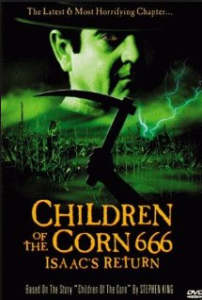
It’s no secret either, as the title gives it away; this is the film that brings back child cult leader Isaac (John Franklin). You can hear the actor introduce this week’s episode of Now Playing Podcast, in which the hosts also explain how Franklin played a critical role in getting the 1999 sequel made.
As it turns out, he’s not the only familiar face (familiar used loosely). Children of the Corn 666: Isaac’s Return features a pair of famous genre stars, along with a few names who are returning to the Corn series as new characters.
That turns out to be great news for this week’s Corn Connection, as you’ll be able to get away from the fields and enjoy some of the better films reviewed in the Now Playing archives.
Nancy Allen (Rachel) – Carrie Retrospective, Robocop Retrospective, Poltergeist Retrospective
Nancy Allen is one of those stars who gets a lot of coverage on Now Playing Podcast. Not only did she make an appearance in last fall’s Carrie retrospective, but her work in the Robocop series was profiled earlier this year, and she showed up in the Poltergeist donation series. The latter was available exclusively to donors.
Stacy Keach (Doc Michaels) – Batman Retrospective
Keach’s resume goes back decades, but the actor only appears one other time in the Now Playing archives; he voiced Carl Beaumont and the murderous Phantasm in Batman: Mask of the Phantasm.
John Franklin (Isaac) – Children of the Corn Retrospective, Child’s Play Retrospective
It’s all about Isaac.
Franklin, as mentioned above, returns to the Corn series more than a decade after he starred in the original film. Franklin also did voice work for the first Child’s Play film, which was reviewed on Now Playing but released exclusively to donors.
Gary Bullock (Zachariah) – Robocop Retrospective, Children of the Corn Retrospective
Bullock just showed up in the previous Corn film, credited as “Farmer.”
This isn’t the first time he’s appeared in a series as two different characters; Bullock also appeared as “Hack Doctor” in Robocop 2 and then as “Gas Station Clerk” in Robocop 3.
William Prael (Jake) – Children of the Corn Retrospective
This is where it gets silly. Prael, like Bullock and Franklin, also has a previous Corn film on his resume. He appeared in Children of the Corn IV, where he is credited as “Concerned Father.”
It’s not over, there are still three Corn films to go. And, as Arnie teases in this week’s episode, there’s a very familiar face to look forward to next week.
Did we miss anyone? If you spot an actor or actress with a connection to Now Playing Podcast leave a comment and help a fellow listener!
September 24, 2014 Posted by Jason Latham | Now Playing Podcast, Podcasts | Batman, batman mask of the phantasm, Carrie, Children of the Corn, children of the corn 666, gary bullock, isaac's return, john franklin, nancy allen, robocop, stacy keach, william prael | Comments Off on Corn Connection: Isaac isn’t only one returning for ‘666’
Children of the Corn 666: Isaac’s Return
The Children of the Corn are all grown up, but original cult leader Isaac is back to lead them! The role of the original corn killer was reprised by John Franklin who not only starred but co-wrote the film with his cousin Tim Sulka. Does this return the franchise to its horror roots? Join Jakob, Arnie, and Stuart to find out!
Arnie C: http://traffic.libsyn.com/nowplayingpodcast/NPPCOTC06.mp3
September 22, 2014 Posted by arniec | Movies, Now Playing Podcast, Podcasts, Reviews | Enertainment, Film, Movies, Now Playing Podcast, Podcasts, Reviews | Comments Off on Children of the Corn 666: Isaac’s Return
New Podcast: Leprechaun 2 – A Podcast Preview
The Leprechaun is back, and now he wants two kinds of booty — his gold and a bride! He’ll kill anyone who gets between him and his desires, including young Cody and his drunk uncle Morty. It doesn’t have the star power of the original, but is it magically malicious? Thanks to your donation to Now Playing you can listen and find out!
: http://www.nowplayingpodcast.com/Podcasts/NPPLEP02TEASE.MP3
Category: Movies & Film
September 19, 2014 Posted by Arnie C | Movies, Now Playing Podcast, Podcasts, Reviews | Enertainment, Film, Movies, Now Playing Podcast, Podcasts, Reviews | Comments Off on New Podcast: Leprechaun 2 – A Podcast Preview
Corn Connection: Familiar faces in ‘Fields’
The Now Playing Podcast review of Children of the Corn V: Fields of Terror went online Tuesday, and while I won’t spoil the review, I will say the film has something going for it; this entry boasts the most recognizable cast in the series.
That doesn’t mean they’re all A-listers. It just means I know who they are. I’ve seen them on TV or film, some in better productions and some in ones less noteworthy than the fourth Children of the Corn sequel.
Still, it’s a welcome relief after desperately scraping the bottom of IMDB to find connections in the previous Corn films.
Check out some of these names: Kane Hodder, Eva Mendes, David Carradine, Fred Williamson, Alexis Arquette, Ahmet Zappa. There are even more; actors and actresses I recognize from Escape from New York and Buffy the Vampire Slayer; and Arquette’s not the only Pulp Fiction alum in the cast.
But as much as I enjoy seeing familiar faces, The Corn Connection doesn’t list their resumes, just their places in the Now Playing Podcast archives.
So let’s get started:
Kane Hodder (Bartender) – Friday the 13th Retrospective Series, Daredevil & Elektra Retrospective, Rob Zombie’s House of 1000 Corpses & Devil’s Rejects Retrospective Series
I thought it best to get Hodder out of the way first, because he’s Jason Voorhees!
Hodder played the iconic screen slasher in four Friday the 13th films, all of them covered during Now Playing’s first retrospective series in 2009.
I didn’t want to get into Hodder’s stunt credits, because I’m focusing on films where he portrayed a character.
You can also catch Hodder in the Now Playing Podcast review of 2003’s Daredevil, part of the Marvel Movie Retrospective. He also had an uncredited role in Rob Zombie’s The Devil’s Rejects, a film reviewed by Now Playing in 2009.
Alexis Arquette (Greg) – Child’s Play Retrospective Series, Sometimes They Come Back Retrospective Series
At the time of Children of the Corn V’s release in 1998, Arquette already had a pretty good-sized resume, with roles in Pulp Fiction and Threesome. He was even the vampire DJ in 1992’s Buffy the Vampire Slayer (something I learned just now).
Arquette’s breakout role would also come in 1998, when he co-starred in Adam Sandler’s The Wedding Singer. But this same year he also had a role as Jennifer Tilly’s doomed neighbor Damien in Bride of Chucky, a film that was covered by Now Playing, but was only available to donors.
The actor popped up again earlier this year when Now Playing covered Sometimes They Come Back… Again as part of the ongoing Stephen King retrospective.
Eva Mendes (Kir) – Ghost Rider Retrospective Series
Fields of Terror was the first film for Mendes, who was just a few years away from becoming a Hollywood star. Despite appearances alongside leading men such as Johnny Depp, Will Smith and Steven Seagal, Mendes only appears once in the Now Playing Podcast archives; when she co-starred with Nicolas Cage in 2007’s Ghost Rider.
Adam Wylie (Ezeekial) – Child’s Play Retrospective Series
Wylie was a child actor in the 90s who many people remember from his role on Picket Fences.
He appeared one other time in a film covered by Now Playing Podcast; 1990’s Child’s Play 2.
Gary Bullock (Farmer) – Robocop Retrospective Series
Bullock has credits in two films covered by Now Playing Podcast, playing separate characters in Robocop 2 and Robocop 3. He’s credited as “Hack Doctor” in the former, and “Gas Station Clerk” in the latter.
Edward Edwards (Lilly’s Father) – Robocop Retrospective Series
Mr. Edwards’ resume include a number of minor television and film credits, including the the role of “Manson” in 1987’s Robocop.
Danny Goldring (Mr. O’Brien) – Batman Retrospective Series
This actor is credited as “Grumpy” in 2008’s The Dark Knight, a film featured in Now Playing’s 2012 Batman Retrospective Series.
I had to research the name Grumpy, and I assumed he was one of the clowns who take part in the bank robbery that opens the film. I was right. Goldring is the one leading the robbery; he’s the one with the most lines, including the memorable, “What bus driver?”
So that’s a pretty good lineup for a Corn sequel. Before sneaking a peek at IMDB for next week’s entry, make sure you listen to this week’s episode of Now Playing Podcast.
Did we miss anyone? If you spot an actor or actress with a connection to Now Playing Podcast leave a comment and help a fellow listener!
September 17, 2014 Posted by Jason Latham | Now Playing Podcast, Podcasts | adam wylie, alexis arquette, bride of chucky, child's play, Children of the Corn, children of the corn V, danny goldring, edward edwards, eva mendes, Friday the 13th, gary bullock, ghost rider, house of 1000 corpses, kane hodder, Pulp Fiction, robocop, the dark knight, The Devil's Rejects | Comments Off on Corn Connection: Familiar faces in ‘Fields’
Children of the Corn V: Fields of Terror
Allison knows her brother has joined a cult of young people who worship He Who Walks Behind the Rows, but she doesn’t know that he’s slated to be sacrificed on the eve of his eighteenth birthday. Can she save her sibling from a corny fate? The answer lies in Children of the Corn V: Fields of Terror. With stars Eva Mendes, Alexis Arquette, and David Carradine, plus Fred Williamson, Kane hodder, and Ahmet Zappa on screen does this Corn greener than its predecessors? Join Arnie, Stuart, and Jakob to find out!
Arnie C: http://traffic.libsyn.com/nowplayingpodcast/NPPCOTC05.mp3
September 15, 2014 Posted by arniec | Movies, Now Playing Podcast, Podcasts, Reviews | Enertainment, Film, Movies, Now Playing Podcast, Podcasts, Reviews | Comments Off on Children of the Corn V: Fields of Terror
New Podcast: The Lord of the Rings – The Two Towers — A Podcast Preview
Though the fellowship is broken the war of Middle Earth continues on in Peter Jackson’s second Lord of the Rings film — The Two Towers. Our heroes separated this film follows three parallel stories of heroism, and introduces new heroes and villains, including Gollum who may be either or both! There is also more action, including the intense battle at Helm’s Deep. How does this middle chapter compare to the first, and does the fellowship of the podcast remain united in their views? If you make a pledge and support Now Playing Podcast you can listen to find out!
: http://www.nowplayingpodcast.com/Podcasts/NPPLOTR02TEASE.MP3
Category: Movies & Film
September 13, 2014 Posted by Arnie C | Movies, Now Playing Podcast, Podcasts, Reviews | Enertainment, Film, Movies, Now Playing Podcast, Podcasts, Reviews | Comments Off on New Podcast: The Lord of the Rings – The Two Towers — A Podcast Preview
Corn Connection: ‘The Gathering’ surprises with actual stars
“This can’t be right, I know these people.” – Arnie C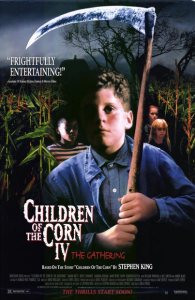
Now Playing Podcast surprised listeners Monday night with the early release of its Children of the Corn IV: The Gathering review, the latest entry in the Stephen King Retrospective Series.
The film was certainly not in award contention when it hit video stores in 1996, but many of its stars may look familiar to viewers, and one member of the cast would go on to greater fame and an Academy Award nomination.
In this week’s Corn Connection, we’re taking that star’s resume, along with the rest of the Corn IV cast, and pointing you toward their places in the Now Playing Podcast archives:
Naomi Watts (Grace Rhodes) – DC Heroes Retrospective Series
Naomi Watts is a household name today, but the 21 Grams and Mulholland Drive actress had just a few indie credits under her belt when she headlined in The Gathering. Her most notable role at the time of the film’s release was alongside Lori Petty in Tank Girl, a poorly-received adaptation of the British comic book.
Tank Girl was reviewed in 2013 as part of Now Playing’s DC Heroes Retrospective Series.
Karen Black (June Rhodes) – Rob Zombie’s House of 1000 Corpses & The Devil’s Rejects Retrospective Series
Karen Black, who passed away last year, had enjoyed a long career before appearing in Children of the Corn IV. Today she is celebrated as a pioneering “Scream Queen” and horror fans may know her best from her role as Mother Firefly in director Rob Zombie’s House of 1000 Corpses.
Now Playing reviewed House and its sequel, The Devil’s Rejects, in 2009.
William Windom (Doc Larson) – Planet of the Apes Retrospective Series
This actor’s IMDB resume lists more than 250 credits, but he wasn’t a star in the Now Playing universe until this past summer, when the hosts reviewed Escape from the Planet of the Apes, a show that was made available during the Spring 2014 Donation Series.
Marietta Marich (Rosa Nock) – The Texas Chain Saw Massacre Retrospective Series
Marich should be recognizable to Now Playing listeners; she played Luda Mae Hewitt, the matriarch of the crazed clan that raised Leatherface in 2003’s The Texas Chainsaw Massacre and its 2006 prequel, The Texas Chainsaw Massacre: The Beginning.
Both films were covered during 2010’s Chainsaw retrospective.
Harrison Young (Drifter) – Rob Zombie’s House of 1000 Corpses & The Devil’s Rejects Retrospective Series
Another actor who went on to work for Rob Zombie, Harrison Young starred as doomed father Don Willis in House of 1000 Corpses. You might also recognize him as the elder Private Ryan in Steven Spielberg’s Saving Private Ryan.
Overall, those are some pretty good connections. Things should pick up next week when Now Playing covers the fifth (of nine!) Corn entries. We won’t spoil it, just go to IMDB if you’re curious.
Did we miss anyone? If you spot an actor or actress with a connection to Now Playing Podcast leave a comment and help a fellow listener!
September 9, 2014 Posted by Jason Latham | News, Now Playing Podcast, Podcasts | Children of the Corn, children of the corn 4, escape from the planet of the apes, harrison young, house of 1000 corpses, karen black, marietta marich, naomi watts, Now Playing Podcast, Podcast, rob zombie, tank girl, Texas Chainsaw Massacre, The Devil's Rejects, the gathering, Venganza Media, william windowm | Comments Off on Corn Connection: ‘The Gathering’ surprises with actual stars
Children of the Corn IV: The Gathering
The ghost of a child evangelist possesses the youth of Grand Island, Nebraska. Can medical student Grace stop this preaching poltergeist before he possesses the body of her daughter? More importantly, can Children of the Corn IV: The Gathering, starring two time Academy Award nominee (and Chainsaw award winner!) Naomi Watts and scream queen Karen Black, improve this film series’ track record? Join Stuart, Arnie, and Jakob to find out!
Arnie C: http://traffic.libsyn.com/nowplayingpodcast/NPPCOTC04.mp3
September 8, 2014 Posted by arniec | Movies, Now Playing Podcast, Podcasts, Reviews | Enertainment, Film, Movies, Now Playing Podcast, Podcasts, Reviews | Comments Off on Children of the Corn IV: The Gathering
New Podcast: Leprechaun — A Podcast Preview
In 1993 evil had a new, shorter face–that of the Leprechaun! Played by Willow star Warwick Davis, this magical meanie would maim and kill anyone who tried to separate him from his gold–including future Friends star Jennifer Aniston! The film spawned a franchise, including the new reboot Leprechaun: Origins, but how does the original hold up? Thanks to your pledge to Now Playing Podcast you can listen and find out!
: http://www.nowplayingpodcast.com/Podcasts/NPPLEP01TEASE.MP3
Category: Movies & Film
September 5, 2014 Posted by Arnie C | Movies, Now Playing Podcast, Podcasts, Reviews | Enertainment, Film, Movies, Now Playing Podcast, Podcasts, Reviews | Comments Off on New Podcast: Leprechaun — A Podcast Preview
The 40 Year-Old-Critic: Snakes on a Plane (2006)
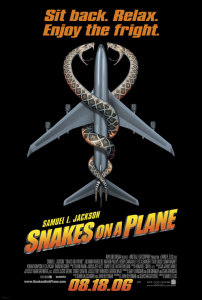 In The 40-Year-Old Critic, Venganza Media creator and host Arnie Carvalho recalls a memorable film for each year of his life. This series appears daily on the Venganza Media Gazette.
In The 40-Year-Old Critic, Venganza Media creator and host Arnie Carvalho recalls a memorable film for each year of his life. This series appears daily on the Venganza Media Gazette.
As I discussed in yesterday’s The 40-Year-Old Critic entry, I began my podcasting career in 2005 with the Star Wars collecting show Star Wars Action News; launched shortly after the release of Star Wars Episode III: Revenge of the Sith.
It had seemed like an easy enough hobby, we just record for 30 minutes each week.
However, the reach exceeded our every expectation, and in February 2006, we realized that recording from home wasn’t enough. All of the new Star Wars action figures and statues that would be released in 2005 had been revealed at Toy Fair International in New York City — and we weren’t there. We had our friends Pete and Chuck from the website Jedi Temple Archives call the show and share the news, but we knew we had missed out.
Pete and Chuck also told about the huge Lucasfilm and Hasbro presence at San Diego Comic-Con. New toys would again be revealed at the summer convention, and we felt Star Wars Action News should be there to cover it.
Marjorie and I had become more experienced con-goers since our first trip to Star Wars Celebration II for the release of Attack of the Clones, but we had never flown to an event. Airline tickets were expensive. Still, we had a show, and we needed the toys. Soon tickets were purchased, press passes obtained, and we were going to SDCC.
Then things got interesting.
As registered press for the convention, Marjorie and I started getting numerous e-mails from various companies seeking exposure. From toymakers to authors to movie studios, we were invited to exclusive events and given opportunities to interview total strangers.
Then came the e-mail that gave us the opportunity to interview Samuel L. Jackson and others for the upcoming film Snakes on a Plane.
I had heard about Snakes on a Plane but paid it little attention. Entertainment Weekly had written several articles about the silly movie with the overly-literal title. From the name alone hundreds of fan websites had sprung up. Despite its premise, the film had a groundswell of good buzz and the film’s producers wanted to capitalize on press coverage at the convention. With Jackson being a vital presence in the Star Wars prequels I thought an interview would certainly be of interest to Star Wars Action News listeners.
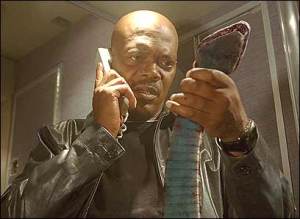
I like to imagine this is Jackson calling his agent wondering how he got on this Plane.
It seemed too good to be true. Jackson was an A-list star; I’d been podcasting for 9 months. I couldn’t believe it would actually happen. I told absolutely no one — after all, if it fell through I didn’t want to be mocked or thought of as a lying braggart. But I prepared: I bought a high-end digital audio recorder and I researched the film to be as informed as possible going in.
Yet the entire event could have been called San Diego Snakes-on-a-Plane Con. On the exhibit floor was a giant booth that was shaped like a snake, yet inside the mouth it had the feeling of a cramped airliner. The music video for Cobra Starship’s “Snakes on a Plane (Bring It)” was omnipresent (and I strained my eye every time it played for a glimpse of Maja Ivarsson’s nipple). We had gone to the convention with some friends who had just discovered the Badger Mushroom song, and so throughout the convention we’d regale each other with the refrain, “Snaaake! It’s a snaaake!” Our friends even brought rubber snakes to the convention as practical jokes.
I was swept up in the utter hype for Snakes on a Plane. I couldn’t wait for them to “Bring it.”
Sure enough, the next thing I knew I was in my first press roundtable interview. Jackson was the biggest star at the event, but it turned out there were four interviews in play. First, we interviewed director David R. Ellis, who I knew from his work on Final Destination 2. The other reporters at the table seemed disinterested and I got to ask a few questions.
Then we talked to the film’s snake wrangler Jules Sylvester. He wore an amazing serpent as he talked about the challenges of dealing with more than 450 snakes on set.
Finally, Sam Jackson visited our table.
Now the other reporters had perked up, and because I was still unaccustomed to the rhythm of the roundtable, I had to work hard to get questions in. I wasn’t entirely new to interviews; I had done many for journalism classes, and interviewed Star Wars collectors and authors on the show. But this was an A-list star. Jackson was there and actually joked with me a bit. It was surreal. He even gave me an autograph on a Star Wars book.
Finally the last interviewee came, Keenan Thompson, who Marjorie knew primarily for his work on Saturday Night Live. I got a couple of questions in there as well.
Leaving the interviews I realized I had far more content than I had thought. While the Jackson interview would be of some interest to Star Wars fans, the rest of the interviews were full of good information, though I knew they had no place on Star Wars Action News. Early feedback from Star Wars listeners was that they did not care for bad language, and so I figured the audience crossover between an R-rated reptile disaster film and Star Wars Action News was minimal.
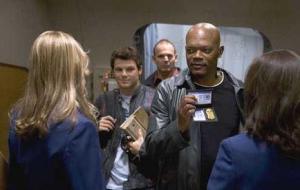
I’m not sure if a movie titled Snakes on a Plane needs more plot than, well, snakes on a plane. Yet this film also gives us a crime story to explain…sort of…how the snakes, and Sam Jackson, got on that plane.
But with four great interviews in the can I decided to start our second podcast, Snakes on a Podcast. It was a limited show, with only five episodes. The first four would lead up to the release of the movie and each would contain one interview. Then, for the fifth show, Marjorie and I would review the movie.
We publicized the show heavily on Star Wars Action News and it got a decent number of downloads. More, anticipation was high for our review; people wanted to know if we thought Snakes on a Plane was worth seeing.
Marjorie and I went to see Snakes opening night in August 2006. We had pre-purchased tickets, the Internet and Comic-Con hype convincing us it would be a sold-out show. It wasn’t.
More, the movie itself wasn’t very good, and we knew it in the theater. It wasn’t terrible, we had seen far worse that year, yet we had hoped for a pulpy B-movie full of laughs and fun. This was long before there was a Sharknado or Piranha 3D, but it was those films’ campy vibe that we hoped Snakes on a Plane would capture. There were moments of that in the film, but they were few and far between. The studio had initially made a PG-13 movie, then went back and added in scenes for the R-rating based off Internet fan demand for the line, “I want these motherfucking snakes off this motherfucking plane.” Those added scenes were what we wanted, that line was legendary, but in between moments of fun were long stretches of stupidity.
You can hear our thoughts, recorded minutes after leaving the theater, in the archived Snakes on a Podcast show. It is the first movie Marjorie and I ever reviewed in podcast form, and is the precursor to Now Playing Podcast, a show we started nine months later.
While the movie failed to meet our expectations, the theatrical viewing didn’t. It was an experience akin to The Rocky Horror Picture Show. While the theater wasn’t packed, everyone there was a built-in fan and the energy of the audience made for a good time. I have watched Snakes once since that theatrical viewing and it is clear that without the fans surrounding us there was little fun to be had.
Snakes on a Plane will always hold a special place in my heart. Not only was it the first time I ever felt like a real reporter for a podcast, it also is one of the last movies to consume San Diego Comic-Con. In the 2000s the complaints were that SDCC was no longer about comics; the fans had come for the movies. That was certainly true in my case. Hollywood studios saw SDCC as an opportunity to push genre movies to greater success, and spent hundreds of thousands, sometimes millions, of dollars at the convention trying to do so.
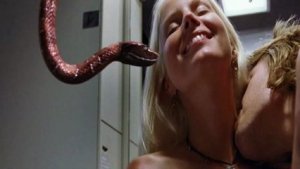
One of the films better, funnier scenes–added later to ensure an R-rating.
Despite the impressive imprint the movie had on the convention floor, Snakes on a Plane fizzled at the box office. Since 2006 a single film has always been pushed at the convention, from Hamlet 2 to Balls of Fury to Scott Pilgrim vs. the World, and they all failed to meet heightened studio expectations. Now it seems film studios have all but abandoned Comic-Con. The giant, custom booths that used to grace the floor are mostly gone. While stars still fly in to host one-hour panels, the convention has morphed into a showcase of genre television shows like Doctor Who, Game of Thrones and Arrow.
Yet each year I hope for another Snakes on a Plane-type experience, another extreme booth attempting to immerse fans in the world of their movie. It may not happen again, but at least I got these motherfucking snakes on this motherfucking Plane.
Tomorrow — 2007!
Arnie is a movie critic for Now Playing Podcast, a book reviewer for the Books & Nachos podcast, and co-host of the collecting podcasts Star Wars Action News and Marvelicious Toys. You can follow him on Twitter @thearniec
September 5, 2014 Posted by Arnie C | 40-Year-Old Critic, Conventions, Movies, Now Playing Podcast, Podcasts, Reviews | 2000s, Cobra Starship, Comedy, Enertainment, Film, horror, Movie, Movies, Now Playing, Now Playing Podcast, Podcasts, Review, Reviews, Samuel L Jackson, San Diego Comic-Con, SDCC, Snakes on a Plane | 1 Comment
The 40 Year-Old-Critic: Revenge of the Sith (2005)
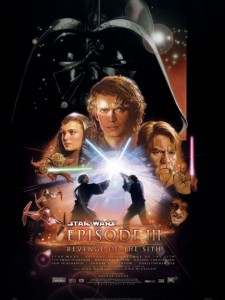 In The 40-Year-Old Critic, Venganza Media creator and host Arnie Carvalho recalls a memorable film for each year of his life. This series appears daily on the Venganza Media Gazette.
In The 40-Year-Old Critic, Venganza Media creator and host Arnie Carvalho recalls a memorable film for each year of his life. This series appears daily on the Venganza Media Gazette.
Star Wars’ greatest legacy may not be the (now endless) sequels, or the billions of dollars in box office revenue, or even the tens of billions of ancillary revenue the franchise has generated for Lucasfilm (now Disney). No, the longest lasting impact of Star Wars may be the people inspired by that film saga to go on and create themselves.
Filmmakers as varied as Jon Favreau, Damon Lindelof, and Eli Roth have all cited Star Wars as an important inspiration to their works, as have numerous authors, artists, game designers, and more.
In 2005 Star Wars inspired me as well… to become a podcaster.
By the time Star Wars Episode III: Revenge of the Sith was released I was pretty far-gone in terms of my fandom. Any lull I had experienced from 2000 to 2002 was long gone. My 2-bedroom townhouse had become a virtual Star Wars shrine with toys, prop replicas, and other various bric-a-brac on display in every room. As much due to my collection as it was a desire to build equity, Marjorie and I eventually left the rental property behind and moved into a home specifically selected for its ability to handle and display my Star Wars collection.
I had gotten three Star Wars tattoos since Attack of the Clones was released, including a Yoda that was based on the art in Genndy Tartakovsky’s Clone Wars micro TV series that bridged the story between Episode II and III. I was the ultimate Star Wars consumer — if it had a Star Wars logo I either bought it or put it on a long list to buy. I even, much to the amusement of the Target clerk and the embarrassment of my wife, bought a pair of Star Wars underwear intended for small children. To outsiders it was an undergarment, but to me it was a collectible.
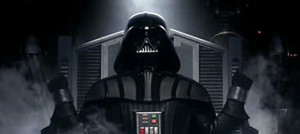
The birth of Darth Vader was the moment fans had waited 28 years for.
The excitement grew as we drew close to Revenge of the Sith’s May 2005 release date. The premiere was May 19 at 12 a.m., and I took the day off of work to sit outside the theater trying to get the best seats. Though I arrived at 10 a.m., I was not the first in line.
Coming off the high of the Star Wars Celebration III convention we attended in April, Marjorie and I had prepared line party events, including trivia, prizes, and music. I rolled up in my convertible with two 12-inch subwoofers in the trunk and blasted dance mixes of Star Wars themes. It was a party, and a blast.
I did have to leave the party for a couple hours to teach class — which I did wearing a Darth Maul tie.
What about the movie? It was far from an afterthought in all the festivities, it was the main event. The conventions, the toys, the party, they were all ways to express our fandom and excitement for the upcoming release. But when I sat in that theater the early morning hours of May 19 I was enthralled. Instantly I knew this was the best of the Star Wars prequels, by a long shot. It was the first of the new trilogy to have emotional weight. Plus it had great action, exciting new characters, and even succeeded in besting The Phantom Menace by having the best lightsaber fight of the entire series. I had high expectations for Episode III and the film lived up to them.
I lived on a euphoric high for weeks after seeing Revenge of the Sith. I went several times in local theaters, not out of a sense of obligation as I did with Phantom Menace but because I wanted to enjoy the film again. Then Marjorie and I drove to Chicago to see the film digitally with Stuart, my Now Playing Podcast co-host and longtime friend.
My Star Wars collecting went to even greater heights. Every day during our lunch hour Marjorie and I would go on a toy run, visiting one or more stores looking for new Star Wars toys.
Weeks passed, though, and while my fandom never wavered the anticipation turned into a feeling of melancholia. I had been looking forward to the Star Wars prequels since they were first officially announced in 1993 (in, of all things, a Star Wars screensaver). For twelve years I’d always had the next Star Wars film to which I could look forward. With the prequels done I wondered if I would ever again experience that level of anticipation.
To continue to experience fandom in new ways I read more Star Wars novels and comics, and visited websites and online forums. There I saw repeated mentions of something called a “podcast.”
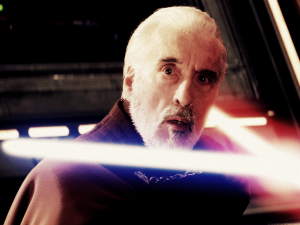
Still a better ending than Christopher Lee got in the Lord of the Rings series.
Being a tech head and, at that time, a college professor of Computer Science, I had heard of podcasting. I never understood the appeal; I was no fan of talk radio. More, I didn’t have an iPod, preferring the Creative Labs Nomad player. Yet now I saw there were podcasts discussing Star Wars, so I listened, and was excited. In my daily life I knew no Star Wars fans other than Marjorie, but on these shows were fans just like me, and they spent hours each week talking about nothing except Star Wars! Even more impressive, the Canadian podcast Star Wars En Direct even had Star Wars authors on the show to discuss their books.
I not only listened to the new podcasts, I went back and consumed the archives of many of these shows. Yet one thing frustrated me; while there were podcasts about Star Wars books, movies, and comics, none existed to talk about Star Wars collecting. Slowly the idea dawned on me… I should do my own.
I had a background in audio production. My desire to entertain, inspired by Pump Up the Volume, had sent me to study Mass Media Communications as an undergraduate. I was a radio DJ, and in my spare time experimented with digital audio, including rudimentary audio editing. As time went on I experimented in other computer multimedia, including video editing. I had the basic skills to do it, and just a few hours of research showed me all the technologies I would need to make it happen.
I also had my own website. My career goal had been to become a video game designer, and to build my resume I created a site reviewing PC games new and old.
So on Sunday, August 28, 2005, a little more than three months since Revenge of the Sith had visited theaters, I was inspired to create my own Star Wars podcast. I will never forget the conversation I had with Marjorie that Sunday morning.
“What plans do we have today?” I asked.
“Nothing,” she replied. It was a rare day that we had no obligations.
“Do you want to help me make a podcast?”
“Sure.” Then, after a moment, she asked “What’s a podcast?”
Within a few hours I had dug some old microphones out of a tote in my closet, installed the necessary audio editing software, and we were off. I didn’t know if anyone would listen, though I hoped they would. No matter what, though, I knew we’d always have the designation of having done it first.
That day Star Wars Action News was born.
I eventually learned that people did listen. I had reached out to several of the Star Wars websites and podcasts I’d read as a fan, and they actually posted about our show. I received immediate feedback, and that first week we had more than 50 downloads. The very next weekend I was at Best Buy to purchase better microphones and take some of that feedback to improve the show.
Tens of listeners became hundreds. Hundreds became thousands. Our show was a success. And while it was not earning money, I had finally found an outlet for my dream of entertaining people. Sure, I worked days at a bank, nights at a college, but on weekends I was a Star Wars commentator and collector.
That one podcast led to another… and another… and another. Marjorie and I have since traveled the country as invited Star Wars experts to speak at conventions. We have taken the mentality of throwing a Star Wars line party and grown it — at the last Star Wars Celebration we threw a party for almost 500 listeners and friends. Plus every year at San Diego Comic-Con we host the Star Wars Fan Breakfast for a sold-out crowd.
Most importantly, though, new friendships were formed. Marjorie and I met people near and far thanks to the reach of our Star Wars podcast. Now I had friends with whom I could chat about the saga, in addition to the regular show discussing my collecting.
And, of course, you’re probably reading this specifically because of Star Wars Action News. After all, without Star Wars Action News there’d be no Now Playing Podcast, the movie review show Marjorie and I started in 2007 and, with years of nurturing and attention, has grown to have an audience that even exceeds that of our cardinal show.

Darth Maul take note: lightsaber fights mean more when there’s a background between the characters.
These days it’s common for me to say “My life is weird.” I think this when I attend press events to interview the stars and directors of Leprechaun: Origins. The thought crosses my mind when I’m having a normal day at work and a piece of fan mail appears on my phone. I say it out loud when I see lines of people anxiously waiting to get into an event I’m hosting, just as I was anxious to see Star Wars in theaters. I’ve had the tremendous fortune to do things, meet people, and go places that many only dream of. I don’t take any of that for granted, but I always acknowledge that it’s a path I was inspired to take because of Star Wars Episode III: Revenge of the Sith.
Tomorrow — 2006!
Arnie is a movie critic for Now Playing Podcast, a book reviewer for the Books & Nachos podcast, and co-host of the collecting podcasts Star Wars Action News and Marvelicious Toys. You can follow him on Twitter @thearniec
September 4, 2014 Posted by Arnie C | 40-Year-Old Critic, Movies, Now Playing Podcast, Podcasts, Reviews, Star Wars, Star Wars Action News | 2000s, 2005, 40-Year-Old Critic, Anakin Skywalker, Collecting, Enertainment, Film, George Lucas, Movie, Movies, Now Playing, Now Playing Podcast, Obi-Wan Kenobi, Podcasting, Podcasts, Revenge of the Sith, Review, Reviews, sci-fi, Star Wars, Star Wars Action News, Star Wars Celebration, Toys, Yoda | 1 Comment
‘Corn Connection’ finds A-lister among ‘Harvest’ players
Every actor has to start somewhere, and somewhere is often low-budget horror.
There are plenty of examples; Leonardo DiCaprio in Critters 3, Seinfeld’s Jason Alexander in The Burning, and Jennifer Aniston in a film Now Playing Podcast donors can hear about very soon.
As for this week’s Now Playing Podcast review of Children of the Corn III: Urban Harvest, we managed to find some famous faces among the cast. Okay, make that one star, some genre actors and a couple of extras you might recognize if you watch a lot of bad flicks.
But I’m not here to reprint IMDB resumes; the Corn Connection shows you where to find the actors and actresses within the Now Playing archives. So let’s get going.
Charlize Theron (Young Woman/uncredited) – Alien Retrospective Series
Harvest was Theron’s first film, before she went on to become a superstar in movies like Mighty Joe Young, The Legend of Bagger Vance and Aeon Flux. Also Monster.
It’s crazy to think that an actress like Theron was only referenced on Now Playing Podcast once, but it’s true; back during the 2012 donation drive, when the hosts covered Prometheus as part of the Alien Retrospective Series. Unfortunately, that series is no longer available.
Michael Ensign (Father Frank Nolan) – Superman Retrospective Series
Ensign is an actor you’ll recognize, although maybe not for his role as a newscaster in 1978’s Superman. I’m sure he gets more looks from fans who loved him as the snooty hotel manager in Ghostbusters, or in his role as the evil bus driver in License to Drive.
Ed Grady (Dr. Richard Appleby) – Children of the Corn Retrospective Series
Does it count if your Now Playing moments came twice in the same retrospective series? Because that’s the case with the late Mr. Grady, who played the same character in the second installment, Children of the Corn II: The Final Sacrifice. Maybe someday the hosts will cover Grady’s role in The Notebook.
Rance Howard (Employer) – Psycho Retrospective Series
Howard, like Theron, has had roles in major blockbusters (his son is Splash director Ron Howard). Howard, like Theron, only appears once in the entire history of Now Playing Podcast (1998’s Psycho). And Howard, like Theron, appeared in a donation series that’s no longer available on the main feed (bummer).
Rif Hutton (Arnold) – Star Trek Retrospective Series
Hutton’s resume includes a long list of television and film credits, but only one of those movies was featured on Now Playing Podcast. So look for his role as a Klingon guard the next time you sit down to watch Star Trek: Generations.
Anthony Hickox (Hans, also executive producer) – Return of the Living Dead Retrospective Series
Hickox appeared as Dr. Hickox in Return of the Living Dead 3, another film that’s currently locked in the Now Playing Podcast archives. But he’s also a director, with a resume that includes Waxwork, Waxwork 2: Lost In Time and Hellraiser III: Hell on Earth.
Brian Peck (Jake Witman) – X-Men Retrospective Series, Return of the Living Dead Retrospective Series
Peck’s resume lists a number of genre films, but his role as Hot Dog Stand Patron in X-Men and News Reporter in X2: X-Men United made him part of the Now Playing universe. He also appeared in the first three Return of the Living Dead films as the characters of Scuz, Special Zombie and Ballistic Technician, respectively. Unfortunately, those Living Dead shows are locked away in the vault.
So there you have it. A few more recognizable actors than the previous Corn film, but many who only have connections to Now Playing donation series’. Wondering how you can become a donor? This way.
Did we miss anyone? If you spot an actor or actress with a connection to Now Playing Podcast leave a comment and help a fellow listener!
September 3, 2014 Posted by Jason Latham | News, Now Playing Podcast | aeon flux, Alien, anthony hickox, brian peck, charlize theron, Children of the Corn, children of the corn III, critters 3, ed grady, Ghostbusters, hellraiser 3, jason alexander, jennifer aniston, legend of bagger vance, leonardo dicaprio, leprechaun, license to drive, michael ensign, mighty joe young, monster, Now Playing Podcast, prometheus, psycho, rance howard, return of the living dead, rif hutton, seinfeld, star trek, Stephen King, Superman, the burning, the final sacrifice, the notebook, urban harvest, waxwork, X-Men, x-men 2 | Comments Off on ‘Corn Connection’ finds A-lister among ‘Harvest’ players
The 40 Year-Old-Critic: Saw (2004)
![saw-poster[1]](https://venganzamedia.com/Gazette/wp-content/uploads/2014/09/saw-poster1-210x300.jpg) In The 40-Year-Old Critic, Venganza Media creator and host Arnie Carvalho recalls a memorable film for each year of his life. This series appears daily on the Venganza Media Gazette.
In The 40-Year-Old Critic, Venganza Media creator and host Arnie Carvalho recalls a memorable film for each year of his life. This series appears daily on the Venganza Media Gazette.
During the last decade, much of our national conversation was centered on torture, both in current events and entertainment.
We’d read headlines about waterboarding and rectally-inserted broom handles, leaving us questioning the purpose and moral justification for torturing prisoners of war. Then, when we turned the page to the Entertainment section we’d read about reality show contestants undergoing some form of painful humiliation for fame; while at the multiplex, a new sub-genre of film was emerging: torture porn.
The term was coined by New York Magazine writer David Edelstein in 2007, but his christening of the brand name came after the release of Saw, the film that put torture porn in front of the masses and defined the horror experience of the first decade of the 21st century.
With torture surrounding us in real life why would audiences pay money to see make-believe torment on screen? I think Americans are comfortable taking horrible scenarios and making them “safe” through fiction. During the September 11 attacks we heard stories about people so panicked by the oncoming fire that they jumped from the high windows of the Twin Towers. Their terrible choice was a nightmare for our nation, that thought of having to either burn or leap to your death. Yet with films like Saw writers and directors took that same life-or-death choice and, because it was a movie, made it safe.
With these films we in the audience could both sympathize with the tortured, while also desensitizing ourselves to the acts on screen.
Perhaps we needed fictional torture to help us accept what the nation was experiencing?
Or perhaps we just wanted to push the boundaries of experience a little further through film?
I know I was looking for something new in horror. After 1999’s successful The Blair Witch Project it seemed Hollywood was smitten with low-budget ghost stories. Recycled J-Horror found success, praised by audiences and critics. I saw those films, but I continued to seek something more; something that was more dangerous than a PG-13 rating would allow, a movie that would push my boundaries the way Hellbound: Hellraiser II had in the 1980s. I wanted more than a bit of spooky suspense found in films like The Ring and The Grudge. I wanted a visceral feeling of life stretched to its most extreme limit.
I had no idea that’s what I would find when I watched Saw.
The film was low-budget — barely more than $1 million — and made by filmmakers who were inspired by the scares Blair Witch delivered, despite that film’s smaller cast and even smaller cost. Saw creators James Wan and Leigh Whannell started by making a 30 minute proof-of-concept film. Its effectiveness helped them raise the money they needed to hire a cast of accomplished actors, including Danny Glover and Cary Elwes.
The story seems simple enough — two men are chained up together in a room, and a dead body separates them. They must uncover clues, or saw off their own feet, to escape. Yet, while keeping a small scope, Whannell’s script created the first iconic horror villain of the 21st Century: “Jigsaw” John Kramer. Played by Tobin Bell, Kramer was a man dying of cancer. With little time remaining he begins to set intricate traps for people to help them live the rest of their life to the fullest — or die trying to escape.
As Jakob, Marjorie, and I mentioned in our 2009 Saw Retrospective Series, the concept of Jigsaw was not terribly original. This mastermind is merely an iteration of John Doe from Seven, but with a dash of the self-fulfillment agenda of Fight Club’s Tyler Durden. After all, Jigsaw’s trap of making a suicidal man cut himself is not that different than John Doe’s punishment for “Lust”; death by intercourse with a bladed phallus.
Yet, despite the similarities, there is one key difference: in Seven we found almost all of John Doe’s victims after the fact. When Seven‘s main characters, two police detectives, discover “Sloth” he’s already wasted away, and “Pride” is already dead. In Saw the cast has expanded; our main characters are the victims of the trap and we get to watch them faced with their tests.
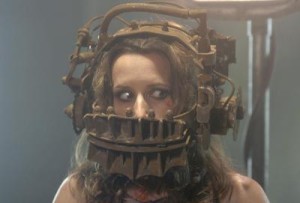
Shawnee Smith’s character Amanda escaped this trap to appear in five more Saw films.
More than just the two men in the room, the story grows to include more victims. Even for those introduced after an encounter with Jigsaw we still get to witness their torment in flashback. These scenes are myriad, from a woman in an iron collar that will tear her skull apart to a man, covered in napalm, having to hold a candle to read writing on a wall.
It’s not just that these victims were going to die in brutal ways (that was de rigueur for horror films since The Texas Chain Saw Massacre), but Saw upped the stakes by combining the suspense of impending horror. It was no longer just a killer behind the door, now there is a ticking clock and when it reaches zero someone will die, and in their last seconds they will harm themselves or others trying to escape.
These types of torment made waterboarding actually seem safe!
Though the creators of Saw would later claim the film was not torture porn, it was clearly the template for the dominant horror movement of the mid-2000s. Saw progressed through the scenes with characters put in increasingly more complex and convoluted traps, and I had the visceral reaction I’d sought. This movie did not scare me as Blair Witch did, but it repulsed me. I would flinch every time the next test came, knowing that the pain inflicted on the characters was fictional, but yet it hit home just the same.
The best part of it was that I was repeatedly asking the question: what would I do in those situations? Would I be able to cut off my own foot to escape a room? Could I kill a man in cold blood if the result was saving my own life? Could I take the pain of the razor cuts and escape the other side? And the absolute worst: could I shove both my hands in a shit-filled toilet to try and find a key?
Yet, a decade later I look back and wonder if subconsciously I made the connection between Elwes’ character, chained in a dirty shit-filled room, with those held in Guantanamo Bay. Neither the fictional character nor the real prisoner know if they will ever see daylight again, and both undergo horrible experiences before it ends… however it ends.
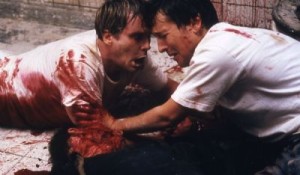
Dr. Lawrence Gordon (Elwes) and Adam Stanheight (Whannell) become brothers in blood on Saw’s dingy bathroom floor.
I can understand why Wan and Whannell would blanch at their hit being called torture porn. Porn usually indicates gratuitous sex (or sometimes action or gore) with no plot. Indeed, Saw has a plot as convoluted and twisted as any of Jigsaw’s traps. It’s clear to me that the two went through a lot of effort to create an involving story. Yet the fact remains that on my first watching I had trouble paying attention to the story for all that was thrown at me. It was a story that would become even more stretched and tangled as sequel after sequel followed, and for its labyrinthine complexity I actually grew to appreciate the franchise more.
Leaving that theater in 2004 I thought Saw wasn’t actually very good, but that’s because I was focusing on the plot (and the various holes it contained). Yet the images of the people in their torment stuck with me for quite some time.
More, as I previously stated, this film’s success created a new horror sub-genre, combining elements of the classic splatter film with the tropes of the slasher horror, yet drawing out the kill scenes in new and inventive ways. From the six Saw sequels to the Hostel films to The Collector to Turistas; each provided a new type of terrible vicarious experience. Truly the most extreme example in this sub-genre must be The Human Centipede — a film that I rejected in concept, but once its torture porn roots came through in the trailer I knew I was in for a treat.
But the genre burned out quickly. By 2009 Saw was clearly over, the sixth installment in the franchise losing a box office battle with the micro-budget found footage film Paranormal Activity. While a few more films, such as Saw: The Final Chapter and Human Centipede II were still to come, the election of President Barack Obama brought with it a shift in media attention away from Guantanamo Bay. That could be coincidence, but it seems more a causation — by the end of the decade humans were tired of facing torture, real or imagined, and preferred supernatural scares on screen. Their votes for political office matched their dollars spent at the box office.
As such, it seems torture porn will remain a symbol of early 21st century American movie-making. Yet out of that sprung some wildly inventive and visceral pictures that may yet inspire a future generation of filmmakers.
Tomorrow — 2005!
Arnie is a movie critic for Now Playing Podcast, a book reviewer for the Books & Nachos podcast, and co-host of the collecting podcasts Star Wars Action News and Marvelicious Toys. You can follow him on Twitter @thearniec
September 3, 2014 Posted by Arnie C | 40-Year-Old Critic, Movies, Now Playing Podcast, Podcasts, Reviews | 2000s, 40-Year-Old Critic, 9/11, Bush, Carey Elwes, Danny Glover, Enertainment, Film, horror, Jigsaw, Movie, Movies, News, Now Playing, Now Playing Podcast, Obama, Podcasts, Review, Reviews, Saw, Shawnee Smith, Terrorist, Tobin Bell, Torture, Torture Porn | Comments Off on The 40 Year-Old-Critic: Saw (2004)
The 40 Year-Old-Critic: Freddy vs. Jason (2003)
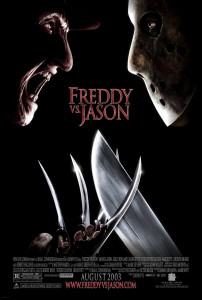 In The 40-Year-Old Critic, Venganza Media creator and host Arnie Carvalho recalls a memorable film for each year of his life. This series appears daily on the Venganza Media Gazette.
In The 40-Year-Old Critic, Venganza Media creator and host Arnie Carvalho recalls a memorable film for each year of his life. This series appears daily on the Venganza Media Gazette.
How many times will I review Freddy vs. Jason? It was one of Now Playing Podcast’s earliest reviews as part of our first retrospective series covering the Friday the 13th franchise leading up to the 2009 remake. Even then we planned to revisit the film and look at it from Freddy’s point of view, which we did the following year during the review series leading up to 2010’s A Nightmare on Elm Street.
By now this should be well-trod ground, and what more could I have to say?
Yet the fact that this is the only movie to be covered twice in Now Playing Podcast retrospectives is indicative of its importance — to film in general and to me personally.
Since our 2010 review I’ve spent a lot more time thinking about the crossover. What is it about two franchises coming together that creates such excitement, especially in the “geek” community? I don’t ask this hypothetically. I personally get swept up in the frenzy when two franchises come together, and it doesn’t even matter necessarily if I like them both! The thought of two universes colliding seems to have a geometric, not additive, increase in interest.
I think to some degree it is fan rivalry at its best. For reasons I don’t understand it seems some fans feel the only way to feel good about their fandom is by putting down others. For example, when Firefly was at its zenith a parade of “Joss Whedon Is My Master Now” shirts filled Star Wars conventions, as if to say, “Star Wars used to be cool.” As such, the “my dad can beat up your dad” mentality started to apply to fan groups; “My stormtrooper can beat up your browncoat.”
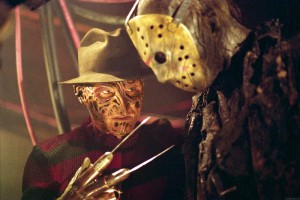
Freddy vs. Jason — whoever loses, the fans win.
That question of who would win in a fight certainly applies to superheroes. In real life, on screen, and online I’ve heard endless debates about which hero is faster, The Flash or Superman. Who would win in a fight, Superman or The Hulk? It is a curiosity, but the chosen winner usually aligns with the speaker’s fan allegiances.
Certainly, speaking of superheroes, comic books have benefited greatly from the crossover. DC Comics had a major hit with its Justice League in 1961, prompting Marvel Comics to respond with its own super team, The Fantastic Four, a move that inadvertently launched the entire Marvel Universe.
Yet, to me, the crossover seemed relegated to just that medium — the comic book. It seemed comics were pulp enough that you could do anything.
Aliens vs. Predator? Sure.
Robocop vs. Terminator? Why not.
Star Trek and X-Men together, you say? Absolutely.
Even rivals Marvel and DC had several crossover series’ that, for instance, led to Superman meeting Spider-Man or Batman fighting the Hulk.
Despite the success and excitement generated by these crossover comics, the concept was rarely conceptualized on film. Universal Studios had done it in the 1940s, when horror icons Dracula, Frankenstein and the Wolf Man came together for the studio’s “Monster Mash” pictures. But Universal owned each property, and when that series ended, crossovers on screen were scarce.
I can recall two that made an impact on me.
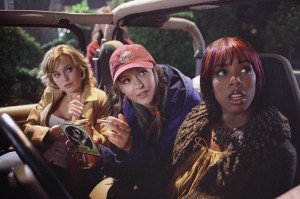
Freddy and Jason aren’t the only names in this cast. Monica Keena (Dawson’s Creek), Katharine Isabelle (Ginger Snaps), and Destiny Child’s Kelly Rowland play teens caught in the middle of the battle royale.
I remember being a young child on vacation with my parents when I saw a trailer for King Kong vs. Godzilla. I had seen numerous Godzilla films, and the 1976 King Kong several times. So the thought of them fighting broke my fragile little mind. I demanded we stay in the hotel room that night so I could watch.
Then, in 1988, Who Framed Roger Rabbit brought together animated characters from Warner Bros., Disney, Turner Entertainment, and more. As I was a teenager, and never really into these characters at my youngest age, the impact was totally lost on me. I saw the film in theaters, thought it was mediocre, and haven’t seen it since.
Beyond those two I can’t think of any groundbreaking crossovers. Some minor ones occurred; such as Star Trek: Generations bringing together cast members from two Trek television series’ (something that had already been done numerous times on Star Trek: The Next Generation, thus lessening the film’s impact). Also, The Monster Squad reassembled the classic Universal Monsters for a kiddie comedy.
But fans wanted more.
So many ideas were teased. Studios knew what we liked, so 1997’s Batman and Robin made sly references to Superman, and 20th Century Fox put an Alien xenomorph skull on a Predator ship in Predator 2. The latter seemed most likely to happen again on film — both franchises were Fox properties in need of a boost. Yet, outside of the Dark Horse comics, nothing materialized for years.
For me, though, more than Aliens and Predators, more than Superman and Batman, Freddy and Jason were the two I wanted to see. Long had the rumor brewed about Hollywood’s (then) top-grossing slashers, Jason Voorhees and Freddy Krueger, going toe-to-toe. I read about it in multiple Fangoria articles in the late 80s and early 90s.
I first saw A Nightmare on Elm Street during a party in 1987, around the time of A Nightmare on Elm Street 3: The Dream Warriors’ release. I found the films so inventive and fun that I rewatched them endlessly, and anxiously awaited each new installment in the series. As detailed during the Now Playing Podcast review, I even cosplayed for the release of Freddy’s Dead: The Final Nightmare. By 2003 I was happy for any new Nightmare, let alone one that pitted villain Freddy against Friday the 13th icon Jason.
I was never as big a fan of the Crystal Lake zombie as I was Freddy, but I did also enjoy the Friday the 13th series. Some of the first R-rated horror I ever saw was Friday the 13th when I came home to find older kids in my house watching it. I tried to join them but the carnage, specifically the decapitation at the end of the 1980 original film, had me fleeing the room. When I finally became a full-fledged horror hound in my early teen years I returned to the franchise when Jason Takes Manhattan was released. While the films lacked the visual panache of the Nightmare series I still enjoyed the films as a guilty pleasure. Over time the series grew in my esteem to be another favorite.

Freddy was killed by fire, but flames don’t slow down Jason.
As such, having both serialized slashers come together would be a dream come true. Or, if done wrong, perhaps a nightmare.
Yet despite the rumors in the horror press and the anticipation by fans such as myself, the killer crossover took 15 years to materialize. Full credit for finally bringing the crossover to screen in the 21st Century must be given to New Line Cinema.
The biggest problem in the 1980s and 1990s was the rights: Jason was owned by Paramount, Freddy was New Line Cinema’s cash cow. The studios tried to work together during the slasher heyday but each wanted to earn 100 percent of the profits by licensing the other’s character. Obviously, that never happened.
Eventually, though, profits started to dry up. Paramount had run Friday the 13th into the ground with crazy concepts like Jason fighting a telekinetic or taking Manhattan. When original Friday creator Sean S. Cunningham wanted to see the franchise continue, specifically with a Freddy crossover, Paramount had no interest. This gave New Line an opportunity. They licensed Jason from Paramount and went to work on Freddy vs. Jason.
While Jason’s creator wanted the crossover, Freddy creator Wes Craven had other ideas. The Springwood Slasher had been given what New Line considered a proper sendoff with 1991’s Freddy’s Dead: The Final Nightmare. But the sequel proved profitable and Craven started planning a return to his iconic franchise. As such, Freddy vs. Jason was put on hold and, instead, Wes Craven’s New Nightmare was made.
Cunningham bided his time, though. In 1993 Jason Goes to Hell: The Final Friday was released and ended with a fan-baiting stinger; Freddy’s glove comes out of the ground and pulls down Jason’s mask. The game was afoot!
We would still have to wait more than a decade for Freddy and Jason to properly share the screen. New Line executives knew the importance of finding the perfect balance between the two famous killers, and so more than a dozen pitches were drafted and subsequently rejected.
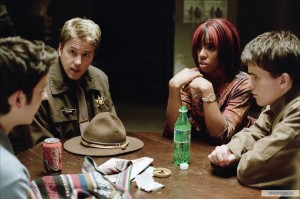
More victims caught in the middle of the killer clash.
Eventually I gave up all hope on Freddy vs. Jason. Nightmare star Robert Englund had not put on the makeup in almost 10 years and I thought Freddy would never grace the screen again. Jason, meanwhile, had gone to space with Jason X (which sat on a shelf for 2 years before its release). Finally, in the early part of the last decade, news — real news — started to come out that the movie was being made.
I honestly believe my excitement for Freddy vs. Jason was on par with my feelings about 1999’s Star Wars Episode I. A countdown clock sat on my computer desktop for 4 months, and when the day finally came I took an afternoon off work to see the first showing.
It met my every expectation.
Directed by Bride of Chucky’s Ronny Yu, the film was outrageous, gory, and over-the-top fun. Both characters got their due (even if Jason inexplicably was suddenly afraid of water) and I couldn’t have asked for more. You can hear a blow-by-blow analysis and both of my reviews at the Now Playing Podcast website, but in short I gave it a strong recommend both times.
Yet loving a movie isn’t enough to garner inclusion in this 40-Year-Old Critic series, there has to be a long-lasting impact. For Freddy vs. Jason, there were two.
First, this film gave Robert Englund a proper Freddy sendoff. It was the best film starring the dream stalker since 1988’s The Dream Master. It cemented a positive feeling for the Nightmare franchise that remains unsullied to this day. Just two weeks ago I had my photo taken with Englund, who was dressed in the full Freddy make-up. I even have ideas for a Nightmare inspired tattoo–the dream killer’s glove slicing into my skin.
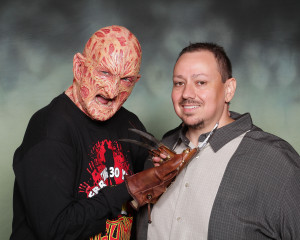
Freddy vs. Arnie — Robert Englund and Arnie pose for a photo at Flashback Weekends in Aug. 2014
Second, though, Freddy vs. Jason’s success launched more than a decade of franchise crossovers. The next year finally saw the release of Alien vs. Predator, which I anticipated every bit as much as Freddy vs. Jason — and which was an utter letdown.
Other pictures released that year include the low-rent, made-for-television crossover Puppet Master vs. Demonic Toys (co-written by Blade and The Dark Knight scribe David Goyer), as well as a return to the “Monster Mash” formula with Universal’s Van Helsing.
Yes, the track record for crossovers wasn’t stellar, but that was honestly my secondary concern — the primary concern was that they were happening. Finally, after decades of teasing, universes were being shared and the world of movies suddenly felt as open as the page of a comic book. But, after 2007’s Aliens vs. Predator: Requiem a shot of adrenaline was needed. I do think the crossover was starting to be seen as desperate, until Marvel Studios took it to the next level.
In 2008 Marvel released its first movie produced in-house: Iron Man. The film stood alone, introducing wide audiences to a superhero that was considered B-list at best. Yet Marvel took a page from New Line Cinema’s book: at the very end Nick Fury showed up to discuss “The Avengers Initiative.” This was the comic book equivalent of Freddy’s hand bursting up from the ground, and Marvel kept its momentum building toward the third-highest-grossing film of all time: The Avengers.
There is a direct lineage from Jason Goes to Hell to Iron Man, from Freddy vs. Jason to The Avengers.
So next spring when you buy your ticket for The Avengers: Age of Ultron (and then download the Now Playing Podcast review) think about the trailblazer that pioneered the modern crossover film: Freddy vs. Jason.
Tomorrow — 2004!
Arnie is a movie critic for Now Playing Podcast, a book reviewer for the Books & Nachos podcast, and co-host of the collecting podcasts Star Wars Action News and Marvelicious Toys. You can follow him on Twitter @thearniec
September 2, 2014 Posted by Arnie C | 40-Year-Old Critic, Comic Books, Conventions, Movies, Now Playing Podcast, Podcasts, Reviews | 1980s, 1990s, 2000s, 40-Year-Old Critic, Avengers, Comic Books, Comics, Crossover, Enertainment, Film, Freddy, Friday the 13th, horror, Iron Man, Jason, Movie, Movies, Nightmare on Elm Street, Now Playing, Now Playing Podcast, Podcasts, Review, Reviews, Ronnie Yu, Sean S. Cunningham, Slasher, Wes Craven | Comments Off on The 40 Year-Old-Critic: Freddy vs. Jason (2003)
Children of the Corn III: Urban Harvest
It’s not unusual for the children of Gatlin to kill their parents. What is unusual is for those children to then move to a foster home in Chicago. But that is what happens in Children of the Corn III: Urban Harvest. Can this franchise grow roots in the city? Listen to Jakob, Arnie, and Stuart’s review to find out!
Arnie C: http://traffic.libsyn.com/nowplayingpodcast/NPPCOTC03.mp3
September 1, 2014 Posted by arniec | Movies, Now Playing Podcast, Podcasts, Reviews | Enertainment, Film, Movies, Now Playing Podcast, Podcasts, Reviews | Comments Off on Children of the Corn III: Urban Harvest
The 40 Year-Old-Critic: Attack of the Clones (2002)
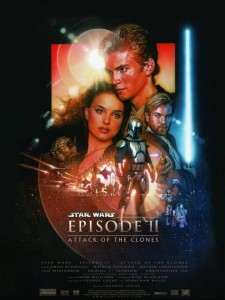 In The 40-Year-Old Critic, Venganza Media creator and host Arnie Carvalho recalls a memorable film for each year of his life. This series appears daily on the Venganza Media Gazette.
In The 40-Year-Old Critic, Venganza Media creator and host Arnie Carvalho recalls a memorable film for each year of his life. This series appears daily on the Venganza Media Gazette.
A week ago, while attending Wizard World Chicago, I had a debate with a Now Playing Podcast listener who claimed Star Wars Episode II: Attack of the Clones was the worst movie in the Star Wars saga. I strongly disagreed.
Not to say I think any of the Star Wars films are bad, per se. I have three tattoos taken from the series. I host Star Wars Action News, a biweekly podcast about Star Wars collecting. I am a devoted Star Wars fan — but I’m also a discerning Star Wars fan that can recognize that those Ewok TV movies are horrible and also distinguish differences in quality among the six films in the saga.
To me, Attack of the Clones was a much needed course correction for the Star Wars prequel trilogy.
To say Episode I: The Phantom Menace left me cold would be a literal truth, as I sat out one night in the freezing rain to get tickets. But it’s also metaphorically true. Perhaps it was how I binged on that first prequel film, seeing it seven times in three days. More, though, I think it was the movie itself. While it boasted the most exciting lightsaber fight in the series, the overall story was somewhat incomprehensible — I had to read various “expanded universe” novels to understand what the Trade Federation was trying to do, and I still think it was stretching. More, the film was completely devoid of humor. The first three Star Wars films had all been fun, with the cocky attitude of Han Solo (Harrison Ford) a centerpiece. Here that sardonic fun was replaced with a walking CGI fish creature stepping in crap.
After The Phantom Menace I slowly found myself drifting away from Star Wars — a major lifestyle change. I had been reading Star Wars novels since 1993, played the video games constantly on my PC, and collected the toys obsessively since 1995. That all peaked with Phantom Menace’s release, when the Toys ‘R’ Us employees informed me that I’d spent the most money of anyone during their midnight toy release, and when I traveled 60 miles every Thursday to get the latest Kentucky Fried Chicken basket topper.
But in the summer of 1999 the glut of Episode I toys clogged shelves. With no new figures found, just the same ones that had been available for months, the thrill of collecting waned and I stopped bothering to look for the next wave of toys. More, I was let down by The Phantom Menace and didn’t wish to dwell on it. I pursued other interests, and stopped buying Star Wars books, toys, and games altogether. It was not a conscious break; when Phantom Menace was re-released in theaters in November of that same year — this time with proceeds going to charity — I saw it again. But that viewing solidified my feeling that my childhood was dead, it was time to move past Star Wars.
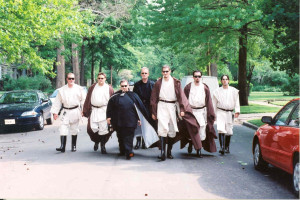
Reservoir Jedi
That stance lasted for a couple years. I even tried to sell my Star Wars collection, only to find that I wasn’t alone. A toy store in Chicago offered me 5 cents for brand new, mint figures — 1 percent of the retail price. He told me no one wanted Star Wars toys, new or old, and that he had a warehouse full of them that he couldn’t sell.
Also during that time my life changed a lot. I met Marjorie, we dated, and eventually moved in together. I also quit my low-paying job and returned to school full-time. We were living off her income and what savings I had put together. Times were tough, bills went unpaid, and there was no extra income to spend on toys. What movies we saw were mostly from the $1 rental bin, not full price theatrical fare.
Despite all this, when the first teaser trailer for Attack of the Clones was released I started to get excited. The trailer was attached to Harry Potter, and so Marjorie and I bought tickets just to see it in the theater. When it played… I was not thrilled. It looked like more of the same that we got in 1999 with Phantom Menace. We were so disappointed we actually left the theater without staying for Potter.
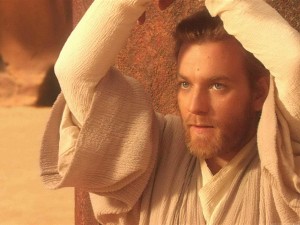
McGregor showed us Star Wars could be fun again.
For me, Star Wars was in a nosedive. But it did pull out, and I remember the moment perfectly. A secret trailer for Attack of the Clones named “Mystery” was released online. A friend came over and he, Marjorie, and I all gathered around my laptop to watch. Another tease, this one focused on an assassin out to get Padme Amidala (Natalie Portman). It showed action, it showed suspense, but best of all it showed humor! It seemed Lucas had realized how dull every character in Phantom Menace had been, and now the sarcastic wit was back courtesy of Obi-Wan Kenobi (Ewan McGregor).
I watched that trailer repeatedly. By the time the third trailer came, my break from Star Wars was over.
But there’s more than that — this film changed my entire life forever.
As mentioned, Marjorie and I were engaged. We knew we were going to get married, but I was hesitating because I was an unemployed graduate student. I had no money, and neither of our parents’ would pay for a wedding. As such, the engagement had no end date, and I hadn’t even scraped the money together for a proper ring. Instead I gave her a placeholder ring that took the last of my cash: $25.
Our excitement for Attack of the Clones grew together; she was as excited for the film as I (and she was nowhere near as hard on Phantom Menace). As such, Marjorie suggested, “What if we have a Star Wars wedding?”
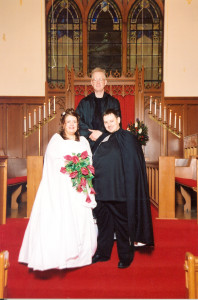
Marjorie, Arnie, and their minister pose for a photo at the wedding.
The thought had occurred to me; I’m not very traditional to begin with, and I considered all weddings to be pomp and circumstance. A tuxedo means nothing to me, nor does a wedding dress to Marjorie. All wedding garb is a costume, so why not make it a Star Wars costume? Plus there was no better time to do it than surrounding the release of a new movie, so a date was set and the Carvalho Star Wars wedding was on.
Her parents were excited. My parents were mortified. We kept certain things traditional — we were married in a church and there were no full-on costumes (I had never heard of the 501st costuming club, if I had I surely would have invited them). As I was the unemployed one I did much of the planning, and I did borrow some money — since repaid — from my godparents to get Marjorie a proper diamond engagement ring; smaller than she deserved but what I could give.
But she had another crazy idea.
The Star Wars Celebration II convention was the weekend before our wedding. As planning had left us stressed, we decided to max out our last credit card and go. I was hesitant; I had gone to a couple conventions in the past but didn’t see the appeal. That said, I had gone only for a couple hours, never an entire weekend. This was a totally new experience, and when we arrived we were immersed in Star Wars. Men in realistic-looking Stormtrooper armor worked security, triggering a latent fear of the men in white. On top of that, celebrities were everywhere; we even had Carrie Fisher (Princess Leia), Billy Dee Williams (Lando Calrissian) and other stars sign our wedding invitation!
Plus, there was new Attack of the Clones footage screened exclusively for convention attendees. We got to see a trailer that parodied Sam Raimi’s Spider-Man, ending with Yoda, lightsaber lit, jumping around like a crazy frog.
I had been excited for Episode II, but now I was practically vibrating with anticipation. I wanted to see Yoda kick ass!
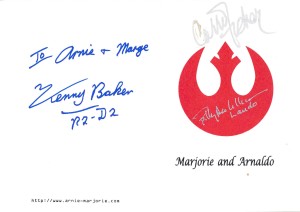
Marjorie and Arnie’s wedding invitation, signed by Star Wars celebrities.
Star Wars Celebration II was a magical weekend bested only by the next one, when Marjorie and I were married. Because of the Star Wars connection local media showed up, and once it hit the AP wire we were known around the country. Our honeymoon in New Orleans felt like a press tour as we woke up every morning at 5 a.m. to talk about our wedding on radio shows, and we were even taken to the local NBC affiliate to appear on MSNBC.
On that honeymoon we went to a midnight screening of Attack of the Clones, which turned out to be one of the worst theatrical experiences in my life. As it was told to me, the theater was showing the film on 16 screens, but had only 4 prints. They were trying to daisy chain the prints from projector to projector, and it didn’t work; the film simply ripped. They had to show the prints to 4 theaters, and the other 12 waited. Finally at 2:30 a.m. the movie started.
I was nervous, what if it was terrible? We were booked to go on MSNBC the next morning, and Marjorie and I had already rehearsed saying, “Loved it!” in unison — lest we look like fools, going on national television about a wedding to tie into a sucky film. The trailers looked good, but after The Phantom Menace I knew there was a risk.
I needn’t have worried. That next morning, when asked by Natalie Morales what we thought of the film, we were honest in expressing excitement. It truly was a return to the Star Wars I’d loved as a child.

The sheer enormity of the clone army excited me.
I’ve seen the movie dozens of times since 2002. Removed from the excitement of the release and the sentiment of our wedding I can clearly see it’s not a perfect film. If ranking the 6 live-action theatrical releases it would be second to last, Phantom Menace at the bottom. I felt the inclusion of Boba Fett as a child was unnecessary to the plot and some of the mysteries never made sense (though at the time I trusted, falsely, that Episode III would answer these questions). Still, the acting was far improved — Portman decided to use her skill this time, and McGregor was a joy throughout. The CGI effects were also better, with the huge battle at the end truly impressing and enthralling me. The lightsaber fight was exciting, and Yoda lived up to my expectations. It has flaws, but was certainly a step in the right direction.
Best of all, it ended with a wedding. Marjorie and I had both gone in spoiler-free and had no idea that we would be married only four days before Anakin Skywalker (Hayden Christensen) and Padme would also tie the knot. To have a Star Wars wedding tying into a new Star Wars film release was one thing, but to be that close to one that also involved a wedding seemed like kismet.

The wedding in Star Wars seemed perfectly timed for our Star Wars wedding.
Though I couldn’t buy Marjorie the ring she deserved, and though the wedding had to be done on a very tight budget, marrying her was the best decision in my life. We have not only shared a life, but we share Star Wars, both through our wedding and now through our podcasts. It would have happened anyway but, to quote Billy Crystal in When Harry Met Sally, “When you realize you want to spend the rest of your life with somebody, you want the rest of your life to start as soon as possible.” Thanks to this movie, it started earlier and has given me more great days than I’d have had otherwise.
More, Attack of the Clones brought me back into the Star Wars fold. I saw it multiple times in theaters, including a trip to Chicago to see it on IMAX — my first IMAX viewing experience. It righted much of what The Phantom Menace wronged.
It brought me back into collecting, as well. New figures were on shelves, but I couldn’t afford them. I finally gave up looking for a dream job and, to pay the bills (and buy a few figures), I took another low-paying temp job. In another unexpected twist, that temp job grew quickly into the career I have today.
And, yes, for our 10th anniversary I finally gave her the ring I wish I could have given her in 2002.
My wife, my work, and my continued love of Star Wars can all be traced back to Attack of the Clones. For that I can forgive its few cinematic flaws and appreciate it for the fun space fantasy that it is.
Tomorrow — 2003!
Arnie is a movie critic for Now Playing Podcast, a book reviewer for the Books & Nachos podcast, and co-host of the collecting podcasts Star Wars Action News and Marvelicious Toys. You can follow him on Twitter @thearniec
September 1, 2014 Posted by Arnie C | 40-Year-Old Critic, Conventions, Now Playing Podcast, Podcasts, Reviews, Star Wars, Star Wars Action News | 2000s, 40-Year-Old Critic, Action, Arnie, Attack of the Clones, Clones, Enertainment, Film, George Lucas, Hasbro, Marjorie, Marriage, Movie, Movies, Natalie Portman, Now Playing, Now Playing Podcast, Podcasts, Prequels, Review, Reviews, sci-fi, Space Fantasy, Space Opera, Star Wars, Star Wars Action News, Toys, Yoda | Comments Off on The 40 Year-Old-Critic: Attack of the Clones (2002)
The 40 Year-Old-Critic: Donnie Darko (2001)
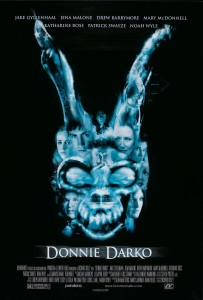 In The 40-Year-Old Critic, Venganza Media creator and host Arnie Carvalho recalls a memorable film for each year of his life. This series appears daily on the Venganza Media Gazette.
In The 40-Year-Old Critic, Venganza Media creator and host Arnie Carvalho recalls a memorable film for each year of his life. This series appears daily on the Venganza Media Gazette.
“You have to watch this movie!” Marjorie exclaimed.
I had just returned home from a very late night at work. I was exhausted and had no idea what she was talking about.
“Donnie Darko. You have to see it,” she told me. “It was on TV tonight. It’s great, but I have no idea what the hell it’s about.”
That, in 2003, was my introduction to Richard Kelly’s directorial debut, Donnie Darko.
I had heard about Donnie, but only in passing. I never knew of its release in 2001; a movie that featured a plane engine crashing into a house was a tough sell just a few weeks after the September 11 attacks on New York City.
The film did catch my eye the following year after it was released on DVD. The title repeatedly popped up at Bloody-Disgusting.com, one of my favorite horror movie websites. Wedged between news articles about Jason X and Bubba Ho-Tep, films for which I had built-in interest, it took several mentions of Darko for me to click the links and read the articles. When I finally did I was confused and slightly put off by the descriptions of a man in a giant bunny suit — I envisioned very low budget, low rent horror from a film with a ghostly bunny.
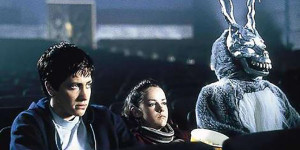
Three’s a crowd when Frank the Bunny comes on your date.
Marjorie’s enthusiasm that night and the online buzz I continued to read convinced me to rent the DVD immediately. I expected straight-up horror, perhaps with a guy in a rabbit suit killing random people.
That was not what I got. Not by a long shot.
First, I wasn’t sure why a website devoted to slasher and horror features spent so much time covering Donnie Darko, which I view as a dramatic sci-fi film. The story invokes concepts of time travel, parallel universes, and psychic phenomena; all delivered in an oblique, theoretical fashion.
When credits rolled I shared my wife’s enthusiastic reaction, but I understood it no better than she did. We talked for hours that night, debating the possible meanings of what we just saw.
What I knew, I knew for a solid fact, was that Donnie Darko was a period-piece teen film. Set in 1988 the story revolves around troubled teen Donnie Darko (Jake Gyllenhaal). On the surface his life looked perfect; he lived in a big house in Virginia, his parents were still together, his older sister was about to enroll in Harvard, and his younger sister was part of the successful dance troupe Sparkle Motion. Yet Donnie is a misfit, full of angst and despair, fighting with all of his family members. He also has weekly therapy sessions where he discusses his sexual fantasies and his fear of being alone.
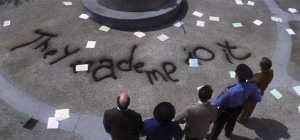
…but who are “they”?
Donnie is smart, his test scores are described as “intimidating”, but at school he has only a small group of friends that discuss nothing more important than the sexual preferences of Smurfs. Early in the film Donnie starts dating the new girl in school, Gretchen Ross (Jena Malone), his first real connection with anyone.
There are some teachers with whom Donnie gets along very well, including science teacher Dr. Monnitoff (Noah Wyle) and English Literature teacher Miss Pomeroy (Drew Barrymore, who also served as executive producer). Both are younger and freer to have open dialogue with their students.
Then there is older health teacher Mrs. Farmer (Beth Grant), an activist who rails against Pomeroy’s teaching of Graham Greene’s short story “The Destructors.” Farmer pushes the school to teach morality based upon the works of motivational speaker Jim Cunningham (Patrick Swayze), who believes everything in life is a choice between love and fear.
Donnie rails against this reductive philosophy, increasing his parents’ view of him as a troubled child.
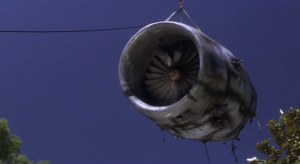
Deus ex machina…a literal God machine.
Taken just as the above, this movie feels like a throwback to classic John Hughes teen fare like The Breakfast Club or Pretty In Pink. It’s the standard tale of a high school student on the precipice of adulthood struggling for free thought in an environment that doesn’t foster such expression. The period-piece setting augments this feeling; the Bush/Dukakis election is referenced, Donnie’s mother reads Stephen King’s It, and the soundtrack features music by Tears for Fears and Duran Duran. There is a large aspect of Donnie Darko that plays just like one of those teen films, and could be taken as such.
But then there’s the jet engine, and Frank the Bunny.
Donnie is a sleepwalker; in the first scene in the film we find him waking up on a hill and riding his bike home. He appears to have been crying.
The next night he is called from his bed by a strange voice. Following it, he finds a man in a strange, dirty rabbit costume, wearing a twisted, frightening, metal bunny mask. This man is Frank, and he tells Donnie that the world will end in 28 days, six hours, 42 minutes, and 12 seconds. We’re not sure if Frank is real or a vision, but it saved Donnie’s life, as that was the night a jet engine crashed into the boy’s bedroom. Had Donnie been there he’d have been killed.
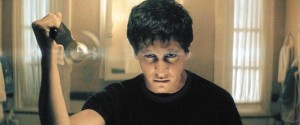
He has a knife in the bathroom. Is Donnie going Psycho?
Every time the film starts to settle into a predictable teen movie routine, something strange happens; Frank appears and gives Donnie destructive orders such as to flood the school or to burn down Cunningham’s house.
Donnie follows the orders, but the audience is left wondering what’s truly happening. Is Donnie a bad kid? Is he having a psychotic break? Is Frank a manifestation of Donnie’s insanity? If the latter is true, then what is with all the talk of time travel and parallel dimensions?
More, each of these bad acts lead to good ends. Flooding the school causes class to be cancelled, and in that free time Donnie first asks out Gretchen. Then, in the ashes of Cunningham’s home, a dungeon full of child pornography is discovered. It’s implied that Swayze’s character may be the head of a kiddie porn distribution ring, and Donnie’s arson helped put an end to it.
Slowly, Donnie becomes convinced that Frank is from the future and that Donnie himself can see future events. He discusses this with Dr. Monnitoff and is given a book, The Philosophy of Time Travel, which precisely details the strange things occurring in Donnie’s life.
Is this the case? Is Donnie insane? Is this all a dream in the character’s head? Is Donnie a stand-in for Jesus?
Simply put, the movie was a mind-fuck. When credits rolled I had no idea what I’d seen, but I knew I enjoyed it.
On Now Playing Podcast I’m often referred to as the critic who places the most importance on story, so it may be unexpected that many of my favorite movies are ones with incomprehensible plots. But I’ve also made it clear on the show that I often love to discuss films more than I love the films themselves. To me, the best movies are conversation starters — films that, as mentioned in True Romance, after watching you can go talk about over a slice of pie.
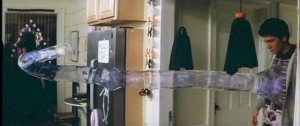
Is this telling Donnie where he will go, or determining his path? If Donnie hadn’t seen this vision would he still have walked this way?
The films need to have a hook; I don’t enjoy every overly dense, incomprehensible, artsy films. There must be some semblance of story, even if the story is not entirely clear. The film also needs relatable characters and circumstances. Having an awesome soundtrack or score, a fun vibe, helps as well.
More often than not this type of film just pisses me off and I never think of it again. But on the rare occasion, when the aforementioned elements come together, the result can be magic. Some other films that embody this include David Lynch’s Lost Highway, Oliver Stone’s Natural Born Killers, and Adrian Lyne’s Jacob’s Ladder. These are movies that stick with me long after the credits roll.
One key to make this type of film come together is the cast. Talented actors, especially familiar faces, can help me feel comfortable when undertaking a strange journey.
I only knew Gyllenhaal as the lead character in the horrible 2001 “comedy” Bubble Boy, and I wrote him off as someone who would never work again. After seeing Donnie Darko, his second lead role, I knew this was an actor with talent and range. This entire film rides on Gyllenhaal’s performance; the character is not only the focus of almost every scene, he’s also going to do illegal and destructive acts. Gyllenhaal gives Donnie a sweetness and vulnerability that makes him sympathetic and genuine. He may be dangerous, to himself or to others, but we want to see him happy.
While I barely knew Gyllenhaal, I was very familiar with his impressive supporting cast. When reading about the film’s low budget, I never expected to see actors I recognized. Yet this cast is full of them. Swayze’s inclusion really helped with the late 80’s vibe, as he was a star at that time with Red Dawn and Dirty Dancing. Mary McDonnell had two Oscar nominations in the 1990s, and soon after Donnie Darko she would rise to prominence again in the rebooted Battlestar Galactica series.
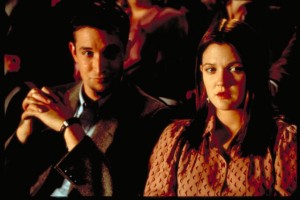
An impressive roster of known stars take bit parts in Donnie Darko.
While those supporting actors were having a lull in their careers at the time Darko was filmed, two stars were at their zenith. Noah Wyle was an actor hot on TV’s ER, and Drew Barrymore was riding high off her career resurgence in Scream.
Credit for this cast, and the film’s own creation, must be given more to Barrymore than Kelly. After Scream, Barrymore had begun a successful producing career with back-to-back hits Never Been Kissed and Charlie’s Angels. Kelly had no luck getting his film produced until Barrymore took on the project, and her involvement helped raise the $4.5 million budget and draw named talent to the project.
All of these elements combined to create an enjoyable movie viewing experience. But what was it about? I felt like I almost got it on my first viewing. Hours of reflection with Marjorie made us each realize a point, a line, which the other had missed.
We watched the film again the very next day, and I got a little more. My impression upon second viewing was that Donnie, a depressed and lonely boy, got to experience one month of happiness and reconnect with his family before he was destined to travel through time and die. I believe it was his destiny to die, but, thanks to unexpected time travel, his death is less tragic than it might have been.
I then spent the entire following day on the computer visiting the Donnie Darko website (no longer online but partially available via archive). Following the example set two years earlier by The Blair Witch Project; the Donnie Darko site was completely in-universe. I could read police reports about Donnie’s 1986 arrest for arson (briefly mentioned in the film), or the newspaper article about pedophile Cunningham’s suicide in the days after the film ends.
The site itself was as dense as the picture, with no obvious navigation. Animations played out on the screen and strange phrases appeared. As a gamer and web designer, the site sucked me in as much as the movie. It was designed perfectly from a psychological standpoint — I would click enough obscure links to get just a drip of information. Like a rat awaiting a treat I repeatedly pushed buttons. I sat at that computer all day, and I remember it well. I didn’t eat, I didn’t move, I just looked for more and more meaning.
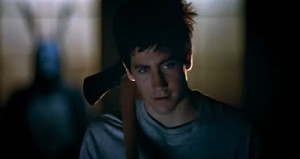
Donnie getting ready for school…
The site was filled with excerpts from the fictional book The Philosophy of Time Travel, written years ago by an old lady Donnie and his friends call “Grandma Death” (Patience Cleveland). The text talked about tangent universes, living receivers, the manipulated living, the manipulated dead, ensurance traps, and more dense terms. No, the site wasn’t here to give me clear answers, but it did aid in my interpretation.
Obsessed, I watched the movie again and this time I thought I had it. I could map the information in the site to the characters on screen. I had an explanation. I didn’t waver from my thought about Donnie experiencing happiness in his final days, but I did start to understand a little more about the mechanics of time travel in this movie, and how Frank the Bunny came to be.
Some may be right to say that films shouldn’t require hours of research to understand. To that I say it wasn’t required, it was desired. The film hooked me enough that I wanted to know more; I had my theories but for me it’s often more interesting to know the director’s vision and intent. Sometimes the intent is ambiguity, but other times they have many ideas but one “truth.”
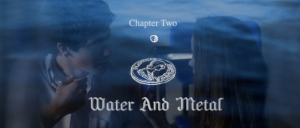
This is not a DVD menu or bonus feature. In the Donnie Darko director’s cut text is put on the screen to try and explain the film to the audience.
Finally, in 2004 I had the chance I missed in 2001 — to see Donnie Darko in theaters. Marjorie and I both drove to Chicago to see the limited release, joined by my Now Playing co-host Stuart, who had not yet seen the film.
The movie had been heavily edited between its Sundance premiere and its wide release. The director’s cut restored 20 minutes of footage, but made even more changes. In what I’m guessing was an attempt to be more accessible for mainstream audiences, Kelly added text to the screen — text taken straight from the Donnie Darko website.
There were other changes, including dialogue and music, but I felt adding the text was going a bit too far. In an effort to be less dense the director had created a weird movie experience that was akin to looking at an appendix while watching. I was happy with some of the scenes put back in the film, ecstatic to see it on the big screen, but in the end I prefer the original cut without the text. I liked the mental challenge of trying to piece this movie together on my own (Similarly, Lost Highway lost some of its appeal when the director went on record stating that film’s “truth”).
Having said that, I’m not certain that even with the text Donnie Darko is so clear-cut. For this review I re-watched the film for the first time in several years. I am a different person in 2014 than I was in 2012; as this review series indicates, I’m becoming more reflective about issues of life and mortality. In this viewing I saw a totally new interpretation of Donnie Darko, one that does involve time travel but also fate, destiny, and the will of God. When I took this as solely a sci-fi drama I missed the spiritual themes that permeate the movie.
In my original thesis, I believed that Donnie needed to connect and feel happiness before his death. But now I see the subtext about “God’s channel” — that Donnie had free will, he didn’t have to die, but to do so was to deny God. Donnie was having an existential crisis; his loneliness came in part because he didn’t want to die and he found no way to believe in anything more than this world. Through the experiences of this movie Donnie not only realizes his role is to die, but he knows it’s his choice to die. He could deny his fate, but in doing so he would deny God’s will. If God has will then there must be a God, and so, reassured and finally finding proof in divinity, Donnie laughs as he takes that next step into the afterlife.
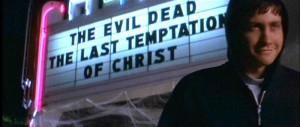
The viewer gets to pick which movie they see through various interpretations of Donnie Darko.
Yet, the more I ruminate on this movie, I would not say my interpretation is the only one. While I think it is what Kelly was going for, so many other interpretations are possible. I would be hard pressed to argue against a reading that Donnie is schizophrenic and having a psychotic episode, as his psychiatrist suggests. I read a theory online that Frank is like The Ghost of Christmas Future and no time travel actually happens, Frank just shows Donnie a vision of what could be. You could say this film is just a take on the theme of the Final Destination films — Donnie was supposed to die and, since he didn’t, Death surrounds him.
The alternate theory, though, that I think Kelly teases most is that there is no such thing as time travel, and this entire move is Donnie’s dream in the moments before his death, in the spirit of An Occurrence at Owl Creek Bridge. This is very clearly given as an option when Donnie and Gretchen go to a two-screen movie house. Do they choose The Evil Dead or The Last Temptation of Christ (which depicts such a dream-in-the-moment-before-death scenario)?
The film’s very final scenes, though, seem to indicate that others in town have a lingering memory, like an almost-forgotten dream in the night, of what Donnie experienced. That realization, that something happened to people other than Donnie, always returns me to my original theory: Donnie had to die, but he got to die after experiencing joy.
Even with this seemingly uplifting message, the movie is horribly sad. I well up every time during the film’s denouement. It’s set to a slow, somber cover of Tears for Fears’ “Mad World” sung by Gary Jules. I had never given that song’s bubble-gum pop lyrics much thought, but this version, mournful and soft, gave the words meaning I’d never considered. It’s the rare cover that makes all earlier versions of the song obsolete (though never, ever listen to the second version on the soundtrack where they added drums and other instrumentation. It is virtually ruinous to the perfect, minimalist recording).
A sequel to this film was released, S. Darko, telling an equally strange and surreal story about Donnie’s younger sister Samantha (Daveigh Chase). That film may contain more answers, but I refuse to see it. It was a studio made product with original creator Kelly having absolutely no involvement, insight, or approval. The director even took to social media to clarify that this was done without him. As such, I will never, ever watch this sequel, for my fear is that S. Darko won’t merely be terrible but, like the previously mentioned remix of “Mad World,” it will permeate my thoughts when I return to the original and ruin my enjoyment.
Donnie Darko changes every time I see it, or perhaps I change every time it sees me. It’s a film that has long moments of Donnie looking into a mirror, and perhaps that’s what I’m doing. In a film this impenetrable it’s easy to project your own thoughts and desires. What I do know is this is an absolute masterpiece of a film that everyone should watch.
When you do, share with me your theories. I’d love to hear them.
Tomorrow — 2002!
Arnie is a movie critic for Now Playing Podcast, a book reviewer for the Books & Nachos podcast, and co-host of the collecting podcasts Star Wars Action News and Marvelicious Toys. You can follow him on Twitter @thearniec
August 31, 2014 Posted by Arnie C | 40-Year-Old Critic, Movies, Now Playing Podcast, Podcasts, Reviews | 1980s, 2000s, 40-Year-Old Critic, Donnie Darko, Enertainment, Film, Mad World, Movie, Movies, Now Playing, Now Playing Podcast, Podcasts, Review, Reviews | 2 Comments
The 40 Year-Old-Critic: Requiem for a Dream (2000)
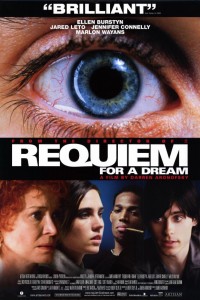 In The 40-Year-Old Critic, Venganza Media creator and host Arnie Carvalho recalls a memorable film for each year of his life. This series appears daily on the Venganza Media Gazette.
In The 40-Year-Old Critic, Venganza Media creator and host Arnie Carvalho recalls a memorable film for each year of his life. This series appears daily on the Venganza Media Gazette.
Have you ever seen a film that you instantly loved, but never wanted to see again? That was my reaction to seeing Requiem for a Dream in 2000.
I was drawn in by director Darren Aronofsky. I had seen his first film, the black-and-white techno thriller Pi, and was enthralled. The use of music, the sophisticated themes, the weird camera angles, the ideas of patterns in everything in life, the repeated sequences that formed a pattern in a movie itself about patterns; all of it left me entranced. I instantly knew Aronofsky was a talent to watch.
I anxiously awaited Requiem’s release, my excitement growing as I read high praise coming out of its screening at the Cannes Film Festival. Being a small film ($4.5M budget) with a very non-commercial NC-17 rating, I knew Requiem would not get a wide release. Sure enough, the picture opened on just 93 screens.
Like a character in an Aronofsky film, I was obsessed with seeing this movie. As such I made plans to visit my Now Playing Podcast co-host Stuart in Chicago, and there we would go see Requiem together.
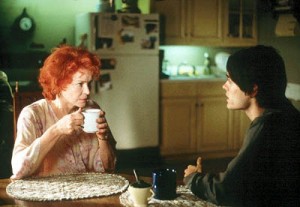
Burstyn and Leto share a rare scene together in Requiem for a Dream.
Based on the novel of the same name by Hubert Selby, Jr., the film follows nine months in the lives of Harry Goldfarb (Jared Leto) and his mother Sara (Ellen Burstyn). Despite the familial relation, the two characters rarely interact; their stories run parallel as we follow their hopes and falls. Starting in “Summer” and ending in “Winter”, the falling temperatures also represent the decline in the characters’ fortunes.
Harry is a heroin addict. He and his friend Tyrone (Marlon Wayans) have hit bottom so many times that stealing Sara’s television to pawn for drug money has become routine. After one theft, followed by a good high at the beginning of the film, Tyrone starts to show ambition –rather than just shooting up, the friends decide to resell some of their drugs to double their money. They have career aspirations of someday dealing a full pound of pure heroin that would set them up for a long time and allow Tyrone to move out of his bad neighborhood.
They start their plan — taking regular pauses to shoot up — and things start to go well. Harry even earns enough money to try to make amends with his mother, and buys her a new, modern television.
In addition to Harry’s burgeoning career as a drug dealer, he is madly in love with girlfriend and fellow junkie, Marion (Jennifer Connelly). The two dream of using their drug money to open a clothing store, allowing Marion to escape her controlling parents. With his money and his girl, things look great for Harry.
Sara, meanwhile, is also finding success. When the film begins she is an elderly widow living alone in an apartment, with little to do but watch self-help television shows. One day her fortune changes with a single phone call: she has been selected to be on her favorite game show. Sara is beyond excited, but also nervous about appearing on national television. A neighbor helps her dye her hair, with unfortunate results. She’s even more distressed after finding out the red dress she wants to wear on the show — one her late husband loved — no longer fits.

Sara starts popping the pills faster and faster to fit in that red dress.
After attempts at crash dieting prove unsuccessful, Sara visits a doctor and begins taking a heavy dose of diet pills. The amphetamines have severe side effects — Sara starts to grind her teeth and can’t sit still — but she loses 25 pounds and feels great. Her looming television appearance has made her the superstar among the retirees in her apartment building and she’s soaking it up.
When Harry brings his mother the new television he instantly knows Sara is tweaking on uppers. He tries to get her to stop, but she is too excited for the game show; even though her obsessive checking the mail for information about her appearance has yielded no results.
If you haven’t seen Requiem for a Dream, if you’ve only read the description above, you might think this is an ugly movie about despicable people. A heroin addict who steals from his own mother? A lonely old woman obsessed with television? A junkie aspiring to become a dealer? In so many movies these characters would be the villains, or at least the antagonists. But Aronofsky is a deft storyteller, and slowly he makes us care for each person on the screen.
Every character is given a touching moment. For Harry and Marion, it’s them lying in bed expressing their affection for each other. They don’t just say “I love you” — rather Harry uses the trite expression, “You’re the most beautiful girl I’ve ever seen.” She responds, telling him she’s heard that a lot, but adds that when Harry tells her it truly has meaning.
More than words, we see that scene through the points of view of both characters via split-screen, allowing for close-ups of Leto and Connelly. This unique approach drives home multiple points: a) they’re together, yet not, b) it’s the first sign that something will come between them, and c) the close-up shots convey intimacy, not isolation.
Then the shots get more inventive. We see Harry talk on one side of the screen, and on the other we see his hand caressing Marion, his thumb brushing over her lips, her palm. Then we see her close-up, and her hands on him. It’s not a sex scene, but this communion between two characters shows their relationship in a much more intimate setting. After only two minutes you want these kids to make it, yet their addiction hangs like a storm cloud.
The same goes for Harry and his mother. While he starts by stealing her television, causing Sara to lock herself in a closet away from her son, he still tries to assure her that everything will be okay. Later in “Summer” we see Harry and Marion on the beach, the man verbalizing how much he loves and cares for his mother and how, now that he has money, he wants to make right every wrong he’s done. It’s a deft turn, but thanks to Leto’s performance and earnest language, Aronofsky has made this thieving drug abuser actually seem noble and good.
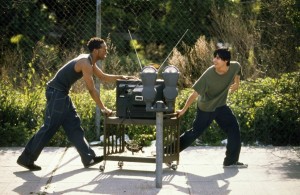
Harry and Tyrone take in some TV.
Tyrone is given the least background of the four, an odd choice considering he is the lead drug dealer. His girlfriend is never named, and his backstory is limited to a bit about honoring his dead mother. Still, Wayans gives a career-best performance in a rare, non-comedic role for the Scary Movie actor. Much of this is due to Aronofsky’s editing — one needs only to watch the deleted scenes on the DVD to realize Wayans tried multiple approaches to Tyrone, including a full-on Jar Jar Binks impersonation.
As shown on screen, Tyrone is the least developed character, yet still a likable personality thanks to the heart Wayans puts into the role.
It’s actually astounding that Requiem makes drug dealing seem like a bright, hopeful career path.
As for Sara, this character may not be one you hate, but one you pity. A virtual shut-in with a television obsession, it is again the script and the actress that makes Sara sympathetic instead of just pathetic. When Harry comes to tell his mother about the new television he asks why she cares so much about the game show appearance.
She responds at first by pointing out to Harry the reverential treatment she has been getting from the other biddies in her building:
“I’m somebody now, Harry. Everybody likes me. Soon, millions of people will see me and they’ll all like me. I’ll tell them about you, and your father, how good he was to us. Remember?”
Then after a pause, an even sadder truth comes out — this television show is all she has to live for.
“It’s a reason to get up in the morning. It’s a reason to lose weight, to fit in the red dress. It’s a reason to smile. It makes tomorrow all right. What have I got, Harry? Why should I even make the bed or wash the dishes? I do them, but why should I? I’m alone. Your father’s gone. You’re gone. I’ve got no one to care for. What have I got, Harry? I’m lonely. I’m old.”
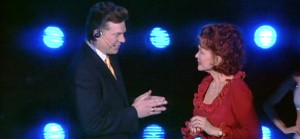
Sara hallucinates a visit to her favorite TV show, hosted by Tappy Tibbons (Christopher McDonald in a memorable minor role).
The obvious answer is right there: Harry could pay more attention to his mother. What she really needs isn’t another television, it’s human connection. But while Harry is desperately trying to be a good son he’s exacerbating his mother’s issue by allowing her to submerge deeper into television, versus helping her to escape it. Despite seeing his mother’s obvious bad reaction to the uppers, this is the last time Harry sees her.
Even with the obvious, unspoken truth of the scene, the monologue could have fallen flat if not for Burstyn’s amazing performance. She jitters while she plays the scene, expressing her agitation from the pills, with a nervousness at being so honest with anyone. She says the lines with a smile, but the sadness comes through in the delivery. Burstyn deserves every accolade she was given for this performance.
Finally, the mood is lightened with humor. When Harry and Tyrone steal the television it’s a joy watching them wheel it past all of Sara’s neighbors, who are more concerned with soaking up the afternoon sun than they are the obvious and strange theft. The characters laugh, joke, and keep the film from becoming too morose.
The combination of the amazing director, actors, and screenplay prevent this story from feeling trite or ugly. When “Summer” ends I was rooting for all four characters to achieve their dreams.
But if that was the summer, soon must come the fall, literally and metaphorically.
For Sara, this comes from her body building up a resistance to the amphetamines. She no longer gets her high from the pills, and though her red dress nearly fits, she needs to continue losing weight. When the doctor won’t up the dosage she self-medicates, taking multiple pills at once.
For Harry, Marion, and Tyrone, their downfall begins when a drug war breaks out in the city. Supplies of heroin have dried up — they can’t get any more to sell, and they can’t get any more to take. Their relationships are stressed, especially by Marion, who seems to suffer the worst withdrawal and blames Harry for her inability to shoot up.
By the time the film gets to “Winter” the movie is no longer a dark comedy. Each character becomes more desperate, and their ends are each so awful that Requiem for a Dream practically becomes a horror film. Yet none of it would work had we not cared for the characters — we would have applauded horrible people getting their just desserts. That I love these people and don’t want to see their ruination is the result of successful, manipulative storytelling of the best possible sort. Aronofsky made me like them, then pulled the rug out from under them — he did the same to us in the audience.

When I left the theater I was shaken and sad. The ending was depressing, but it was just; and I realized that. I felt as mournful as I would for a friend who’d gone down a bad road. This movie was hard — hard to watch, hard on its characters, and hard on the audience. I left the theater knowing I loved every frame of this film but also thinking it was such an emotional trial that I never wanted to watch it again.
I did though, many times. Beyond just great storytelling, Requiem for a Dream is a visual masterpiece that I — after some time passed — wanted to revisit to fully take in.
Aronofsky’s second feature brought back so many of the things I’d enjoyed in Pi, especially the inventive, experimental camerawork. Now, more than a decade later in a time when GoPro cameras are strapped to everyone’s heads, you see the genius in Aronofsky’s self-proclamed “Schnoz cam” — strapping the camera to an actor so the person always stays in the center of the frame while the background and scenery move around them. First used in Pi and then in Requiem, this gave the feeling of a character surrounded by a world out of control — a sign of madness, or a visual representation of vertigo. When sped up film footage is added to the effect, you see that Aronofsky created an entirely new way to deliver the same emotion as the old Hitchcockian “push and pull” change of depth.
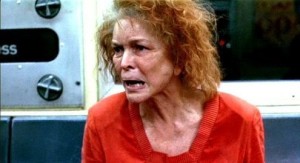
Sara finally fit in her red dress, but at what cost?
One of the things that impressed me about Pi was its unique visual style. Despite being very low budget, the use of superimposed images, quick cutting, and repetition was hypnotic. That is also on full display in Requiem. Every time the characters get high, be it by snorting, shooting up, or popping pills, a ritual is performed. The film cuts to a montage that lasts only seconds but shows the actions, and the characters. A lighter is lit, drugs boil, a syringe fills, blood courses through veins, pupils dilate. It all happens so fast that it’s virtually subliminal, yet it tells us everything we need to know. As the film becomes more desperate the montages are even faster, showing us people stuck in a cycle of self-destruction.
Aronofsky also isn’t afraid to get surreal. In the depths of psychosis Sara sees cupcakes floating in the air, her favorite self-help TV personality appears in her living room, interlaced at her television’s 480 lines of resolution. At one point her refrigerator even opens a gaping maw to eat her. These types of shots could undermine the mood but, as done here, they just enhance it.
In addition to the camerawork, enough credit simply cannot be given to composer Clint Mansell. I had the CD from Pi, his first film score, on an endless loop in my car; the electronic techno score was perfect for that film about a computer programmer, but I never would have thought the composer could hit the emotional resonance he did when he reteamed with Aronofsky for Requiem.
As this was a low-budget film, the score was performed by just four people: The Kronos Quartet. Still, with just violins, a viola, and a cello this score permeates nearly every frame of the movie. The low, sonorous tones of the cello dominate and make even the happy scenes foreboding. It’s a gorgeous composition that feels so classical it’s impossible to believe it was written in the 21st century; it feels like the work of Edvard Grieg, or one of Beethoven’s darker works.
The score has such an emotional resonance that it has been the breakout star of Requiem for a Dream; even if you’ve not seen this film I guarantee you’ve heard the score’s climactic movement, “Lux Aeterna.” Just two years later, in 2002, my jaw hit the floor when the trailer for Peter Jackson’s The Lord of the Rings: The Two Towers was scored to an orchestral version of “Lux Aeterna” — the assemblage of instruments and a faster tempo giving the song a more epic feel than the Quartet did alone (This orchestral version is available for digital purchase at Amazon).
In the years since, “Lux Aeterna” has been a go-to track for movie trailers, including Zathura, I Am Legend, Sunshine, The Da Vinci Code and, unlikely as it may seem, it was even used in Barbie doll ads!
Combined, every element of this film comes together as smoothly as one of Harry’s heroin montages. More, the performances, cinematography, and soundtrack all underscore the film’s thesis — summed up in the title — about the lengths to which people go to try and achieve their dreams. No matter what your dream, be it to be a TV star, a clothing shop owner, a screenwriter, or a podcaster, it’s a plight to which everyone can relate.
Aronofsky finally achieved mainstream success and acclaim with 2008’s The Wrestler, and then went on to even greater success with 2010’s Black Swan. I consider that unfortunate. While I like both of those films, the director has never achieved a more perfect theatrical representation of obsession than he did with Requiem for a Dream. And though I’ve yet to see this year’s Noah, my feeling is Requiem is Aronofsky’s best film to date.
Even if I do have to steel myself every time I rewatch it.
Tomorrow — 2001!
Arnie is a movie critic for Now Playing Podcast, a book reviewer for the Books & Nachos podcast, and co-host of the collecting podcasts Star Wars Action News and Marvelicious Toys. You can follow him on Twitter @thearniec
August 30, 2014 Posted by Arnie C | 40-Year-Old Critic, Movies, Music, Now Playing Podcast, Podcasts, Reviews | 2000s, 40-Year-Old Critic, addiction, Barbie, Darren Aronofsky, dealing, Drama, drugs, Ellen Burstyn, Enertainment, Film, Heroin, horror, Jared Leto, Jennifer Connelly, Lord of the Rings, Lux Aeterna, Marlon Wayans, Movie, Movies, NC-17, Now Playing, Now Playing Podcast, Podcasts, Requiem for a Dream, Review, Reviews, The Two Towers | 2 Comments
New Podcast: The Lord of the Rings – The Fellowship of the Ring — A Podcast Preview
It was considered a risky move. New Line Cinemas put up the money for not just one, but three Lord of the Rings movies. All three were filmed simultaneously in a single fourteen month shoot in New Zealand, directed by Peter Jackson, a proven director but not one with a blockbuster history. If the films had not been successful it was likely New Line would have gone under. Yet the gamble paid off! The first film The Lord of the Rings: The Fellowship of the Ring was a massive hit that not only minted that first trilogy but would also lead to a second Middle Earth film trilogy adapting J.R.R. Tolkien’s earlier novel The Hobbit. Is that first Lord of the Rings film as good as its reputation, and can any movie do justice to Tolkien’s original prose? Make a pledge and support Now Playing to listen and find out!
: http://www.nowplayingpodcast.com/Podcasts/NPPLOTR01TEASE.MP3
Category: Movies & Film
August 29, 2014 Posted by Arnie C | Movies, Now Playing Podcast, Podcasts, Reviews | Enertainment, Film, Movies, Now Playing Podcast, Podcasts, Reviews | Comments Off on New Podcast: The Lord of the Rings – The Fellowship of the Ring — A Podcast Preview
The 40 Year-Old-Critic: The Blair Witch Project (1999)
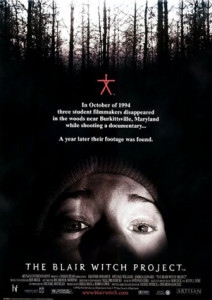 In The 40-Year-Old Critic, Venganza Media creator and host Arnie Carvalho recalls a memorable film for each year of his life. This series appears daily on the Venganza Media Gazette.
In The 40-Year-Old Critic, Venganza Media creator and host Arnie Carvalho recalls a memorable film for each year of his life. This series appears daily on the Venganza Media Gazette.
As I did with my 1980 review of Popeye, I do feel the need to address the elephant in the room: how can my pick for 1999 be anything other than Star Wars Episode I: The Phantom Menace?
It seems the likely choice. After 16 years a new, original Star Wars film was about to hit theaters, Lucas was directing for the first time in 22 years, and it was the top-grossing film of ’99.
Those who know me know how hyped I was for that film. I spent hundreds of dollars on toys and sat outside overnight in excessive rain, and later tremendous heat — third in line to get my ticket.
The Phantom Menace came and went, and when the year ended I realized the film had left me strangely unfulfilled. It defied expectations by actually making a Star Wars film boring. I have neither glowing nor damning things to say about Lucas’ return to directing. I’ll say this: It is certainly not a film that has impacted my life.
Instead, the film that stuck with me most from 1999 is not a big-budget Hollywood production, it is the smallest of films which became the year’s most profitable: The Blair Witch Project. I had never seen a movie like it before, and I’ll likely never experience one that way again.
The Blair Witch Project was more than a movie in 1999, it was a movement, and one that began months before it hit theaters.
I discovered The Blair Witch Project early in the year after reading about the film’s website, which was unlike any site I’d visited before. Odd and confusing, it told of Blair, MD, a town surrounded by superstition and mystery. I recall a timeline of events and some very low-res video. I also recall spending hours on this site, mostly waiting for the videos (which in today’s world would be tiny) to download to my 56kbps dial-up modem. The clips included news reports that seemed real enough, and introduced a mystery of three missing young people and rumors of the supernatural.
What the site didn’t mention was that it was all fictitious.
Have you ever wondered what it would be like to live in 1938, when an unsophisticated radio audience went into a panic over Orson Welles’ War of the Worlds? Or to be in 1974 and think there really was a chainsaw-wielding cannibal in Texas, instead of a story inspired by Ed Gein? The closest I will ever come to that is The Blair Witch Project. I found the site knowing of the film, but thousands didn’t — including some of my friends whose intellect I respected. They should have known better, but the age of the Internet hoax was not yet upon us.
This type of viral marketing is common now and thousands of movies have tried to replicate what Blair Witch innovated; but years before “viral video” was in our lexicon the Blair Witch website spread like wildfire via e-mails sent from person to person.
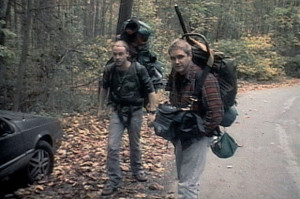
Josh and Mike begin their investigation.
From the presentation on the website, to the documentary-style filmmaking, it was very easy to be sucked into the “reality” of The Blair Witch Project. I watched as friend after friend fell for the ruse. Even as trailers for the film ran in theaters and on television, audiences weren’t sure if this was real.
“Don’t tell anyone,” I remember one friend confiding, “but I don’t think The Blair Witch Project is true.” I laughed and said, “Probably not, as I saw the lead actress on Jay Leno last night.”
Yes, even with a huge publicity push that involved multiple television appearances by the cast, audiences didn’t know what to make of The Blair Witch Project. That thousands of people could be so swept up in a shared fantasy, let alone one made by a few indie filmmakers and not Hollywood’s marketing machine, is phenomenal in the most literal sense of the word.
I went to see Blair Witch the weekend it opened. It had received so much acclaim in the media that I was excited to see the next evolution of horror. Plus I was curious; the website’s videos had asked many questions and I wanted to know the answers.
Initially I was put off by the filming technique. The early scenes introduce the three documentarians — Heather Donahue, Mike Williams, and Josh Leonard (all actors, but using their given names for the film) — as they set out to make a film about the myth of the Blair Witch. The early scenes have some comedic value and a bit of an eerie feel, but overall I wondered if I’d made a mistake. The shots seemed so amateurish and shaky. I knew this was low-budget filmmaking, but even in movies like Clerks and El Mariachi I’d never seen camera work like this — it felt like something I would shoot with my parents’ video camera and no tripod.
More, the characters seemed petty and dull. I knew they were actors, but they didn’t seem like very good ones. The bickering about a map, the various spats, I wondered when the horror would start.
But slowly the film sucked me in. Perhaps it was the first-person views, or maybe it was something instinctive — Heather’s constant cries for help breaking me down and stirring something primal inside me that is agitated by a female shriek. No matter, halfway through the movie, when Josh disappears, I was really invested in these characters and their plight. When Heather finds a small tied bundle and unwraps it I strained my eyes to see what was inside. There was blood and… were those teeth? Hair? It wasn’t gore like I was used to seeing; it was even more unnerving.
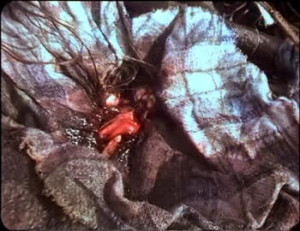
What… is… that?
By the time Heather, snot dripping from her nose, delivers her famous monologue to the camera I was totally taken. The Blair Witch Project did something no film had done since I was a child: it made me afraid. The tension of the scenes and the way it all felt so real; I had an uneasy feeling that I couldn’t just write off. The movie had gotten to me.
When the climax comes with Mike and Heather running through a house, then seeing Mike’s camera fall, I was dying to see more, to know more. Then, when Heather screams and her camera hits the ground and we see — is that Mike? Standing in the corner? I was enthralled, and frustrated. The film had provided no clear answers; what we saw could have been taken many different ways. But I had undergone the most exhilarating movie experience of 1999.
Among my audience I seemed to be the only one with that feeling. As credits rolled I witnessed something else I’d not seen before or since: a man around 50 stood up and shouted, “They must be pretty hard up for movies to put crap like that on the screen.” He left, disgusted.
That did not dampen my excitement. This was a movie unlike any I’d ever seen before, one that intentionally blurred the lines between fiction and reality (actors using their real names, regular citizens interviewed about a fictitious witch, etc.). More, the first-person filming technique had made me feel a part of the film.
According to Wiki, The Blair Witch Project was not the first “found footage” movie, but it was close, and it was the first that I had seen. Going in I had thought it unlikely I could find it believable that, in the midst of utter terror, these characters chose to keep the cameras rolling. Keep in mind this was before cell-phone cameras, YouTube, and the learned instinct of pulling out a camera every time tragedy occurs. Yet the way Heather, Josh, and Mike acted; their need for the security found through the camera lens, made me a believer.
That said, I thought it was a one-trick pony. Surely no film could pull this off again. How wrong I was. Blair Witch inspired a generation of filmmakers to try and replicate this formula. There were only seven “found footage” films released before Blair Witch; there have been more than 100 in the years since. Think about that.
Directors Daniel Myrick and Eduardo Sanchez were not trying to invent a new film style, they simply didn’t have the money for a full crew and improvised with actors, untrained in camerawork, filming each other. Yet now it seems impossible to escape this overused horror trope. I have seen so many “found footage” films, from Cloverfield to Chronicle to V/H/S to Diary of the Dead, and none have done it as well, or as believably, as Myrick and Sanchez did in 1999.
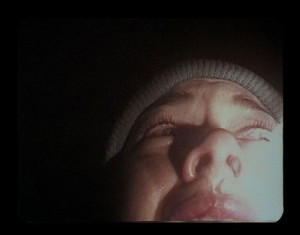
The scene you’ll never forget, and neither will Heather Donahue.
Initially I was drawn to Hollywood’s “found footage” trend, hoping to recapture that Blair Witch feeling. Now I avoid them at all costs, realizing the first was the best. In the end I like my movies to be cinematic. Blair Witch was a novelty but the constant output of more “found footage” movies has become a massive turnoff for me.
With Blair Witch as my first “found footage” experience I was shocked that my second wasn’t Book of Shadows: Blair Witch 2.
Released the following year, I remember taking Marjorie to see it opening weekend. While nowhere near as inventive, original, or tense as the first film, there were aspects of that sequel I enjoyed. The post-modern idea of “The first film was a movie in this second film!” was novel, and the hard rock soundtrack was fun.
My love of Blair Witch continued, though the property continued to be watered down. I bought all three videogames, and even the Blair Witch action figure. Yes, McFarlane Toys made two figures of a character never seen on-screen.
I have since escaped the Witch’s spell. I sold the figures, and the games were a dull mess. I haven’t seen the sequel since its DVD release in 2001. Yet the Blair Witch Project is a film I still hold in high regard.
Tomorrow — 2000!
Arnie is a movie critic for Now Playing Podcast, a book reviewer for the Books & Nachos podcast, and co-host of the collecting podcasts Star Wars Action News and Marvelicious Toys. You can follow him on Twitter @thearniec
August 29, 2014 Posted by Arnie C | 40-Year-Old Critic, Movies, Now Playing Podcast, Podcasts, Reviews | 2000s, 40-Year-Old Critic, Blair Witch Project, Enertainment, Film, Found Footage, horror, Indie Film, Movie, Movies, Now Playing Podcast, Podcasts, Toys | Comments Off on The 40 Year-Old-Critic: The Blair Witch Project (1999)
The 40 Year-Old-Critic: Armageddon (1998)
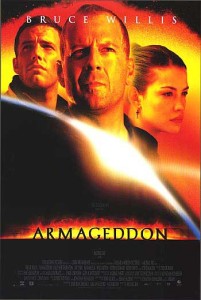 In The 40-Year-Old Critic, Venganza Media creator and host Arnie Carvalho recalls a memorable film for each year of his life. This series appears daily on the Venganza Media Gazette.
In The 40-Year-Old Critic, Venganza Media creator and host Arnie Carvalho recalls a memorable film for each year of his life. This series appears daily on the Venganza Media Gazette.
How Arnie Learned to Stop Worrying and Love the Asteroid
I’ve often referenced Armageddon on Now Playing Podcast, and, shockingly, those comparisons are usually favorable. This has led to many a raised eyebrow and gentle mocking — even from co-hosts who have never seen Michael Bay’s 1998 blockbuster (you know who you are).
So, though 1998 contained many movies that influenced me, from Bride of Chucky to Pi to Your Friends and Neighbors to Very Bad Things, I think I must take the opportunity to discuss Armageddon and explain how Bay changed my perception of action films.
If it helps you to relate to my position at all, I’ll admit that I was skeptical about the movie going in.
First, it was the second giant-rock-destroys-Earth movie of 1998 (it was a comet in Deep Impact). Believe it or not, this idea had been one that petrified me for nearly a decade.
In 1990 I read an article in the newspaper entitled “The Doomsday Rock” which described the likelihood that, eventually, a giant asteroid would collide with Earth and cause the extinction of the human race.
I had grown up with the fear of nuclear Armageddon ending our species, but by 1990 the Cold War was over and I could finally stop worrying. Now came an even bigger fear — at least nuclear war required two human beings to consciously kill everyone, but no one could control or stop a giant asteroid.
I kid you not; I didn’t sleep for days after reading that article. It became my biggest fear: death by asteroid. It’s a terror I’ve learned to live with, but every day I hope that NASA receives the funding it needs to track more of these objects in space; as even NASA’s chief Charles Bolden has said our only current hope is to “pray.”
While the concept was one that scared me, seeing two similar movies came out in the summer of 1998 seemed excessive. Deep Impact beat Armageddon to theaters by more than two months, and it was a deeply moving and touching film. By the time of Armageddon’s debut I thought we’d already seen all the giant rock movies we needed.
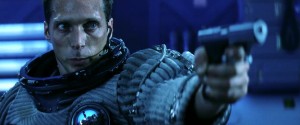
Before seeing Armageddon I could not imagine why an astronaut would need a gun. It’s one of the many improbable plot twists that I ended up going with.
Even more than that, Armageddon‘s pre-release press made the film sound absurd. While ostensibly a disaster film about a big asteroid, I read articles which mentioned scenes showcasing astronauts with handguns. In what world would a gun become instrumental when a giant rock is about to kill all life on Earth? Despite having Bruce Willis as the star, this wasn’t Die Hard; what role would guns play? The astronauts in Deep Impact didn’t need them.
Despite those reservations I still found myself in a packed theater during the film’s Fourth of July opening weekend.
I was drawn in by several factors, starting with director Michael Bay.
Bay had impressed me with Bad Boys, which I thought was the best buddy-cop film since Lethal Weapon, and it marked the first time I saw Will Smith as a movie star. Bay’s follow-up, The Rock, was loud and heavy on explosions, but had some great action scenes for Sean Connery and Nicolas Cage.
And, for the longest time, I thought Bay also directed Cage in Con Air, which was dumb fun. I was likely confused by the fact that Jerry Bruckheimer produced both films. So, despite Bay having no involvement in Con Air, it was still a factor in my seeing Armageddon.
A larger factor pulling me to the theater was the cast. I had been a devout fan of Willis since Moonlighting. I loved seeing him in film; it didn’t matter if it was Color of Night, North, Pulp Fiction, Nobody’s Fool, or even Hudson Hawk.
Next was Ben Affleck, an actor I knew from his work with Kevin Smith, plus his Oscar-winning screenplay for Good Will Hunting. This was his first big-budget epic, and as he was a friend of Smith’s I was rooting for his success.
The rest of the cast — the ragtag group of asteroid drillers — was made up of some of Hollywood’s best 90s character actors, including Billy Bob Thornton, Steve Buscemi, Michael Clarke Duncan, Owen Wilson, and Keith David. I was even happy to see Ken Hudson Campbell, an actor I fondly remembered from his role as the “Animal” emotion in Herman’s Head.
While many of those stars would be launched to greater fame by Armageddon, even in 1998 I thought of this as a “dream team” of performers.
It was very lucky that I did know this cast, as I quickly realized that in Armageddon they were not characters, they were “types.” Affleck was the young hotshot, Buscemi the sardonic genius, Wilson the funny one, Duncan was the big guy who was soft on the inside, and Willis was the tough-as-nails, no-nonsense leader of the pack.
The baggage I brought with me from previous films helped me tremendously, as Armageddon wasn’t going to spend a lot of time developing new relationships or exploring character emotions. This movie was going to put the pedal to the metal and go, go, go.
It opens with a meteor shower demolishing New York City, and from that moment NASA is racing the clock to save humanity. The pace is so fast, Bay never stops the film to let the audience catch its collective breath.
Initially I was put-off by this; here was a movie exploring my deepest fear, yet the characters on screen never worried. They’re laughing, drinking, going to strip clubs and spending money like there’s no tomorrow — because there might not be. What a tonal shift from the dour Deep Impact. Even when we weren’t dealing with the asteroid directly, there were few scenes that didn’t involve a fight or a chase.
When we are introduced to Willis’ Harry Stamper he’s chasing Affleck through an oil-drilling platform, the older man shooting at the younger one. The reason for this homicidal rage? Affleck’s character, A.J., was caught sleeping with Harry’s daughter, Grace (Liv Tyler), and Harry hoped she would do better than a roughneck like her father.
It’s silly. It’s outrageous. It’s over-the-top. I wasn’t sure if I was going with it at all. My consternation only increased as the movie continued through the training montage and other silliness.
It wasn’t the concept of “only the best oil drillers in the world can save us” that put me off. That was standard fish-out-of-water storytelling. Think back to The Last Starfighter, where only a teenage video game player can win an interstellar war. Or in 48 Hours, where a cop needs a convict to catch a killer. Even in The Terminator a waitress had to fight alongside a warrior. This “you’re the only one, even though you’re unqualified” trope was one I’d grown up with, though never witnessed to this extreme.
My problem was I had no idea who these characters were. In a rare slow scene A.J. and Grace enjoy a final picnic, and some erotic animal cracker play, before his spaceflight. When asked if he thinks anyone else is doing that same thing at that time, A.J. responds, “I hope so. Otherwise, what the hell are we trying to save?”
It was a question that resonated with me — in a film full of cardboard characters, why did I care if everyone died?
It started to click, though, in another pre-spaceflight scene. Driller Chick (Will Patton) goes to see his ex and their son. The son doesn’t know his daddy, and a dropped line about a court order implies Chick hasn’t been the best father. But in this moment, at the end of the world, Chick wants to give his son a toy space shuttle. This was a character with very little screen time and no distinguishing characteristics, yet, out of the blue, suddenly he has a backstory: a son, and his own regret.
This is when I had my “eureka” moment. How many times have I seen this story of the estranged father who, just before a moment of heroism, reconnects with his child? Or vice versa? It’s a moment intended to endear us to the character and show an emotional connection, a reason for them to live, or motivation for them to sacrifice themselves.
Be it Nancy saying goodnight to her mother in A Nightmare on Elm Street, Arnold Schwarzenegger’s tender reconnection with Alyssa Milano in Commando, or even Willis’ own Die Hard where he leaves a message of regret for his wife and children, we’ve seen this time and time again. (We’d see an echo of it later in Armageddon between Harry and Grace as well).
The difference is that in those other films the moment is the climax of an emotional relationship, recognition of clarity and regret. But for Chick this is the first sign of characterization he’s given. Did we know he was a bad dad before this second? Did we care?
Through Chick’s sudden storyline I realized this wasn’t a film in the classic sense, it was a two-and-a-half hour music video. The vibe is the same — rollicking rock music (mostly classic rock by ZZ Top and Aerosmith) blared through the theater’s sound system while the characters underwent mental health evaluations and simulated spacewalks.
There were so many Aerosmith songs I wondered if the band (fronted by Liv Tyler’s father Steven) was chosen because Liv was in the movie, or if Liv was in the movie in exchange for Bay being able to raid Aerosmith’s catalog.
Even when the characters go to space and the rock music stops, the bombastic score takes over and keeps the vibe going. But more than just being driven by music, the storytelling methods in a short video and Armageddon are identical.![]()
In a five-minute song there is little time to create a unique character, so tropes and types must be utilized to tell a story.
In Michael Jackson’s “Beat It” I don’t need to know the gang members have families and loved ones, I can bring that to the story myself. In Aerosmith’s “Cryin’” video I don’t need to hear a word to understand Alicia Silverstone is a rebellious teen. I didn’t need to see the kid picked on in school to know he’s a geek in the video for The Offspring’s “Pretty Fly for a White Guy.”
Bay came from music videos, and he trusts the audience to be used to this shorthand storytelling and rapid cutting. This movie was aimed directly at those weaned on MTV. If we have already seen scads of movies that embody a trope, why recreate it?
That’s when it hit me; Bay wasn’t lazy, he was efficient! He trusts his audience to have seen movies with these characters in them before, and thus he can actually get away with just putting tropes in a scene and letting them have their action. Characters can be types instead of people, in a movie that isn’t really about the people anyway.
I already hear, in my own head, the counter of that — that movies should be about people, and that if we don’t care about the characters how can we be excited by the action. It’s an argument I’ve used myself when discussing some of Bay’s later Transformers films.
Yet, I do believe that there should be balance. If all movies were the same, a cinema would be a mighty dull place to visit. There should be room for different types of stories. While two 1998 films told the story of a calamitous collision that ends life on Earth, the way the stories were told make those films as different as night and day.
But, and I cannot stress this enough, what Bay is doing is a tightrope walk. It is a dangerous game to rely solely on hackneyed plots and character tropes. Here, he pulls it off, in large part due to an extraordinarily likable, talented cast that brings more to the screen than they were given on the page.
The director must be given credit here as well. The editing, camerawork, and special effects were all top-notch. Bay knew how to film a scene for maximum adrenaline, and the music made it feel like a party.
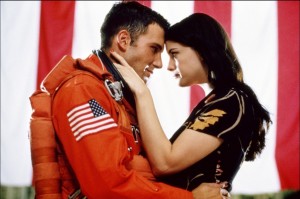
Bay’s go-to image for pride is a giant American flag. It’s not subtle, but there’s no denying it plays in the heartland.
Who knew the end of the world could be so fun?
The film does overstay its welcome, especially in the longer Criterion Collection Director’s Cut where Chick’s same story beat is repeated with Harry visiting his father in a nursing home. Yet, for all the crazy twists and turns the plot takes — and the obvious heartstring-tugging climax — Armageddon is a fun ride. I walked out of it knowing I enjoyed the movie, though I didn’t respect it very much.
As Bay has continued to make movies Armageddon has become harder to defend. With three abysmal Transformers films, plus Pearl Harbor, he’s too easy a target for us critics to hit. Transformers especially took the storytelling methods of Armageddon to their worst extreme, invoking tropes in ways that I didn’t give a damn about.
You can hear my detailed thoughts on those three awful films, plus the fourth not-too-bad one, in the Now Playing Podcast archives.
I may be mostly drawn to films that do provide insights into characters and comment on everyday life though on-screen events. But sometimes I just want escapist entertainment. Armageddon delivers that in spades.
Tomorrow — 1999!
Arnie is a movie critic for Now Playing Podcast, a book reviewer for the Books & Nachos podcast, and co-host of the collecting podcasts Star Wars Action News and Marvelicious Toys. You can follow him on Twitter @thearniec
August 28, 2014 Posted by Arnie C | 40-Year-Old Critic, Movies, Now Playing Podcast, Podcasts, Reviews | 1990s, Action, adventure, Aerosmith, Armageddon, Ben Affleck, Bruce Willis, Enertainment, Film, Michael Bay, Movie, Movies, Now Playing, Now Playing Podcast, Podcasts, Review, Reviews, sci-fi | Comments Off on The 40 Year-Old-Critic: Armageddon (1998)
Corn Connection: Thinnest threads in ‘Final Sacrifice’
In The Corn Connection, Venganza Media searches the Now Playing Podcast archives for films featuring the cast of The Children of the Corn series
Children of the Corn II: The Final Sacrifice exists in that very odd place for low-rent horror sequels: It’s not good enough to bring back actors from the first film, and not quite bad enough to draw genre stars willing to sign on for ironic reasons, or for the chance to have their names above the title.
Even Pumpkinhead II had Punky Brewster, and those Prophecy sequels had Christopher Walken.
The Final Sacrifice has… no one.
An exhaustive search through the annals of IMDB turned up only the thinnest threads connecting the “stars” to the Now Playing Podcast archives. But, that doesn’t mean you shouldn’t indulge, and perhaps take a listen to some shows you might have missed along the way.
So, for your listening pleasure, here’s where you can find the cast of Children of the Corn II and the films they’ve appeared in:
Christie Clark (Lacey Hellerstat) – A Nightmare on Elm Street Retrospective Series
Clark was a child when she played Jesse’s sister Angela in Freddy’s Revenge. And you probably thought you could rewind to see her in the pool party scene. Shame on you.
Wallace Merck (Sheriff Blaine) – Friday the 13th Retrospective Series, Robocop Retrospective Series
Mr. Merck was one of the unfortunate paintball players that stumbled upon a resurrected Jason Voorhees in Jason Lives. Spoiler: He didn’t make it.
He also played “Gun Shop Owner” in Robocop 2, which Now Playing covered earlier this year.
Joe Inscoe (David Simpson) – Teenage Mutant Ninja Turtles Retrospective Series
This actor appeared as “Police Officer No. 2” in the first TMNT film. Again, we’re grasping at straws here.
Marty Terry (Mrs. Burke/Mrs. West) – Philip K. Dick Retrospective Series
Terry appeared in a “Pre-Crime PSA” in Steven Spielberg’s Minority Report. You can go back and try to spot her, or you can go listen to the Now Playing hosts talk about the picture.
Robert C. Treveiler (Wayde McKenzie) – Carrie Retrospective Series
This actor appeared in another sequel to a King film that the author wanted nothing to do with: The Rage: Carrie 2. He played a “patient.” One can only assume it’s during the mental hospital scenes. Do we really have to go back and verify?
Bonus! Treveiler does have a role in Frank Darabont’s The Mist, which Now Playing Podcast will get to (eventually) as part of its Stephen King retrospective.
So there you have it. Not too much in The Final Sacrifice to link back to the archives. Perhaps that’s a good thing. Perhaps we should simply thank the actors for their participation, and part ways.
Maybe we’ll have better luck next week with Children of the Corn III: Urban Harvest.
Did we miss anyone? If you spot an actor or actress with a connection to Now Playing Podcast leave a comment and help a fellow listener!
August 27, 2014 Posted by Jason Latham | News, Now Playing Podcast | A Nightmare on Elm Street, Carrie, Children of the Corn, children of the corn 2, christie clark, frank darabont, joe inscoe, marty terry, minority report, Now Playing Podcast, philip k. dick, robert treveiler, robocop, Stephen King, Steven Spielberg, Teenage Mutant Ninja Turtles, the final sacrifice, the mist, the rage: carrie 2, tmnt, wallace merck | Comments Off on Corn Connection: Thinnest threads in ‘Final Sacrifice’
40 Year-Old-Critic: Chasing Amy (1997)
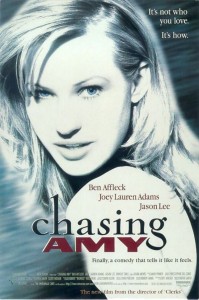 In The 40-Year-Old Critic, Venganza Media creator and host Arnie Carvalho recalls a memorable film for each year of his life. This series appears daily on the Venganza Media Gazette.
In The 40-Year-Old Critic, Venganza Media creator and host Arnie Carvalho recalls a memorable film for each year of his life. This series appears daily on the Venganza Media Gazette.
Kevin Smith is a polarizing figure in cinema. The director certainly has his legion of fans, and having attended several conventions with Smith as a featured guest, it seems those fans are mostly male, mostly under 30, and very willing to connect with his characters; lovable losers such as Clerks’ Randall and Dante (Brian O’Halloran and Jeff Anderson, respectively).
I am not in Smith’s camp, and on Now Playing Podcast I have repeatedly expressed my disdain for his body of work.
Yet allow me in this entry of The 40-Year-Old Critic to praise Smith’s best film, 1997’s Chasing Amy.
Amy (as some fans refer to it) was Smith’s third picture. The director was a Sundance phenom with his black-and-white debut (the aforementioned Clerks) in 1994. It did well in theaters and truly found its audience on video — an audience that included me. Thanks to Quentin Tarantino and Reservoir Dogs, I was paying more attention to indie films, especially those heavily promoted by Miramax. As such, I saw Clerks on VHS and enjoyed it.
As I mentioned in my review of Leaving Las Vegas, around this time in my life I was underemployed and frustrated with my lack of career options, so I related heavily to Dante in Clerks. Plus, I was enraptured by the raunchy jokes. Smith raised the bar on profanity with language that originally earned his film an NC-17 rating. As I did with Beverly Hills Cop before it, I laughed loud and hard at Clerks’ envelope-pushing comedy.
Smith parlayed that success into a studio picture, 1995’s Mallrats. The director spent $6 million of Universal Studios’ money on a movie that barely made one-third that amount. Even as a fan of Clerks I thought Mallrats was too cartoonish, too broad. With new lead duo Brodie Bruce and T.S. Quint (Jason Lee and Jeremy London, respectively), Mallrats tried to replicate the bromance of Clerks in a way that felt forced. More, it seemed Smith’s signature characters of Jay (Jason Mewes) and Silent Bob (Smith himself) would not work in color.
Mallrats would not be Smith’s last failure, but it may be his most fortuitous. First, it established his relationship with Ben Affleck, who had a minor role. Second, after Mallrats Smith returned to his “comfort zone” of small, indie filmmaking. On a $250,000 budget — extraordinarily low but still 10 times that of Clerks — Smith wrote and directed Chasing Amy.
By 1997 I was fully indoctrinated into the Cult of Kevin — as rabid a fanboy as any he’s had. I participated in his online message boards and I watched his first two films regularly (and convinced myself Mallrats wasn’t that bad… it is). Whatever Smith made next I would see. Yet the plot of Chasing Amy I found particularly interesting.
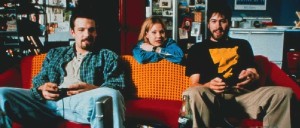
Alyssa (Adams) literally comes between Holden and Banky in this scene.
The film centers around two young independent comic book creators, Holden McNeil (Affleck) and Banky Edwards (Mallrats’ Jason Lee). The best friends find their relationship strained when Holden begins a romance with lesbian comic creator Alyssa Jones (Joey Lauren Adams; Smith’s then-girlfriend), spurring jealousy in Banky.
To me, the film seemed to be jumping on the bandwagon of “queer cinema” which had started to gain steam in the mid 90s. While mainstream Hollywood acknowledged gay characters in movies like Philadelphia and The Birdcage, it was really indie films that brought them to the fore, with such groundbreaking fare as My Own Private Idaho, The Crying Game, and Kiss Me, Guido.
Specifically, I saw in Chasing Amy echoes of Guinevere Turner’s Go Fish — a film Smith acknowledges as inspiration. Sexual preference felt like an exciting new frontier for films to tackle and, having seen all the ones I just mentioned, I likely would have seen Amy even with a complete unknown behind the camera.
I was actually a bit nervous to see Smith tackling LGBT topics. This was a straight man with a penchant for raunchy humor. In Clerks, for example, lead character Dante slut-shamed and dumped his girlfriend after finding out her sexual history. I wondered if Smith would use Alyssa’s sexuality as a source of humor, or to titillate his built-in male audience.
I was happily wrong. Chasing Amy is an exquisite balance of comedy and drama. The start of the film is right in line with Clerks’ humor, as militant black comic creator Hooper X (Dwight Ewell) dissects the racist undertones of the Star Wars trilogy. It was great fun, like a geeky twist on Tarantino’s Like a Virgin deconstruction in Reservoir Dogs. But the humor is nuanced. It’s quickly revealed that not only is Hooper’s rage an act to sell his comics, but he is also a closeted gay male and close friend of Banky and Holden.
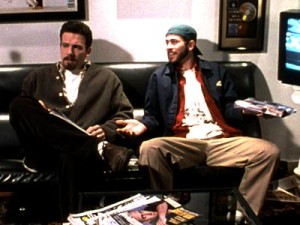
As Holden and Banky, Affleck and Lee created a genuine on-screen friendship. It was one my friends and I related to…until the final twist.
The latter two characters would be familiar to Smith, and not just because both Affleck and Lee appeared in Mallrats. In Clerks, Mallrats, and again here, Smith features the same central duo: immature twenty-something white males with potty mouths. The primary character is more serious, contemplative, semi-neurotic, and dealing with relationship issues. The sidekick is wacky, always given the movie’s funniest lines, but given short shrift in the plot. Here, Holden was our Dante/Quint, and Banky was our Randall/Brodie. The jokes were raunchy and familiar, and the laughs hit hard.
More, Smith seems to know his audience. Any homophobes in the theater get their say through Lee, who spouts gay slurs and stereotypes throughout the film. Featuring gay characters in a positive light, and having Banky spout ignorance, was a subtle way of Smith attempting to educate a more narrow-minded contingent of fans.
Chasing Amy slowly changes tone, though. While all of Smith’s films had dealt with romantic relationships, none had been a romance film. Amy becomes that as Holden befriends unobtainable Alyssa. Their friendship is tinged with longing, and not just on Holden’s side — Alyssa’s feelings for a man make her question her own sexual identity. The scene where Holden confesses his feelings, followed by a rain-soaked argument, is moving and engrossing. There is barely a laugh to be had, and shows a maturity not before seen in a Kevin Smith film.
The film takes continued twists and turns, and jokes keep coming, but Smith had sharpened his humor into a blade, using it to cut the tension of many tense, dramatic scenes. The audience, engrossed in this tumultuous relationship full of self-doubt, would find their laughter a welcome release — the film allowing us to breathe again.
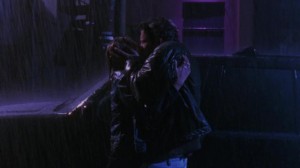
This kiss in the rain was Alyssa finally giving into her feelings for Holden. In most films that would be the end, but here it’s only the beginning of a journey full of self-doubt and jealousy.
While the romantic comedy fan in me was enjoying the Holden/Alyssa relationship, I was also empathizing greatly with Lee’s Banky. I was in my mid-20s and I had lost many friends to their girlfriends. I was all-too-familiar with the pattern of friends who hang out when they’re single, and then don’t return your calls when in a relationship. I saw Banky losing his lifelong friend to a new relationship, and, for the first time ever in a Smith film, I felt bad for the sidekick. Smith had finally created a supporting character with his own arc.
Holden and Alyssa’s relationship eventually hits the rocks when Holden finds out Alyssa was not always gay. The climax (so to speak) comes when Holden, desperate to save his friendship and his relationship, proposes a three-way to both Alyssa and Banky.
That was where the film took things too far. Until that point I felt Smith’s film had portrayed characters acting in ways that felt honest. This twist seemed to be the writer/director choosing to go with a wacky ending over a heartfelt one, or maybe he just wrote himself into a corner and couldn’t find a more earnest resolution.
The group sex idea felt totally outside the realm of Holden’s character. More, that Banky agreed, seemed to me a full character betrayal. I had completely understood Banky’s disappointment with a friend ditching him for a new relationship — it’s a real, common occurrence among single male friends. That Smith chose to write that entire emotion as based in latent homosexuality felt like a missed opportunity — an honest look at friendship was undermined by turning one character into a stereotypical gay male predator.
The film does recover from that moment, with an ambiguous ending that reminded me of The Graduate. Despite my disappointment with the final twist, the movie overall remained an on-screen romance that came across as honest and real. I left the theater entertained and believing Smith would be the next great voice of cinema.
He tried. His follow-up film, Dogma, attempted to analyze religion the way Amy deconstructed relationships, but to lesser effect. While amusing, the picture is scattered and scatological.
But it was with his next effort, Jay and Silent Bob Strike Back, that I realized Smith was not an auteur with things to say, but a writer of increasingly insipid comedy. I first saw Smith speak at a convention in 2001, followed by a preview screening of Strike Back, and I realized he was a more amusing speaker than filmmaker.
History would prove that assumption true, as Smith is now an accomplished podcaster, while the best thing I can say about his post-Strike Back films is that there aren’t many of them.
I have seen all of Smith’s directorial efforts, always hoping to see even a hint of the filmmaker that made Chasing Amy. But from Jersey Girl to Zack and Miri Make a Porno to Cop Out and even Red State, Smith has become a serviceable, but completely unexceptional, director of (mostly unfunny) comedies. I would characterize Smith’s later directing work as on par with Tom Shadyac or Steve Carr. If you don’t know those names, you can look them up, but had Smith not been an indie darling in the mid 90s I don’t think you’d know his name either.
I don’t mean that to say Smith is a one-film-wonder, still coasting on Clerks, because I have gone back and watched his directorial debut — it doesn’t hold up. Jokes that pushed the envelope in 1994 now seem almost tame. More, Clerks is less a film than it is a series of sketches loosely tied together. I loved it when I was the characters’ age and related to their Generation X angst, but it is a movie with limited appeal that is quickly outgrown.
I had hoped that after Cop Out’s critical drubbing Smith might — as he did after Mallrats’ failure — return to his roots and make more personal films. That hasn’t happened. While he has done more low-budget films, such as Red State, it appears the filmmaker who made Chasing Amy is gone forever.
It is a shame. With Chasing Amy Smith showed himself to be a talented writer who could balance both comedy and drama with equal measure. It remains a go-to film when I want to laugh, one of the most honest romances caught on screen, and a progressive view of LGBT characters in cinema. Yet it’s the only Kevin Smith film I can recommend.
Tomorrow — 1998!
Arnie is a movie critic for Now Playing Podcast, a book reviewer for the Books & Nachos podcast, and co-host of the collecting podcasts Star Wars Action News and Marvelicious Toys. You can follow him on Twitter @thearniec
August 27, 2014 Posted by Arnie C | 40-Year-Old Critic, Movies, Now Playing Podcast, Podcasts, Reviews | 1990s, 40-Year-Old Critic, Ben Affleck, Chasing Amy, Comedy, Comic Books, Comics, Drama, Enertainment, Film, GLBT, Jason Lee, Kevin Smith, Lesbian, Movie, Movies, Now Playing, Now Playing Podcast, Podcasts, Review, Reviews, Romance, Romcom | 2 Comments
The 40 Year-Old-Critic: Scream (1996)
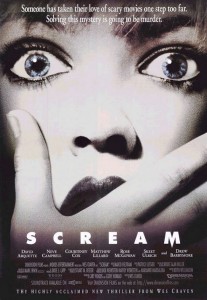 In The 40-Year-Old Critic, Venganza Media creator and host Arnie Carvalho recalls a memorable film for each year of his life. This series appears daily on the Venganza Media Gazette.
In The 40-Year-Old Critic, Venganza Media creator and host Arnie Carvalho recalls a memorable film for each year of his life. This series appears daily on the Venganza Media Gazette.
What’s your favorite scary movie?
As I mentioned in previous reviews of Love at First Bite and Hellbound: Hellraiser II, I have always been a horror fan.
As a very young child I loved the fear I felt toward forbidden cinema, and as I aged I came to see the humor, thrills, and scares in the genre. In my 20s, though, my love of horror changed. I had grown up and no longer had exciting nightmares starring Freddy Krueger. To me, there were no more mysteries in the world, and no more scares to be had on screen.
This problem was exacerbated by a lack of exciting horror in theaters. The slasher craze of the 80s had waned with Friday the 13th Part VIII: Jason Takes Manhattan and Freddy’s Dead: The Final Nightmare. By the early 90s the genre seemed to be gasping its last breaths; Jason Goes to Hell: The Final Friday was the 1993’s top-grossing horror film with only $15 million — nearly tying Manhattan’s $14 million for a series low. A year later the only notable horror release in theaters was Wes Craven’s New Nightmare. By the time The Mangler and Halloween: The Curse of Michael Myers came and (quickly) went, it seemed the bloody fun of the cinema was gone.
At the same time Hollywood was failing to launch new horror stars on screen. The first Leprechaun was released to little fanfare, and audiences simply laughed off Dr. Giggles.
I still enjoyed horror where I could find it, but that was mostly on direct-to-VHS releases. There was the occasional gem, such as Return of the Living Dead 3, or Tales from the Crypt Presents Bordello of Blood, but it was largely a parade of dreck.
I thought horror was dead.
But like any good villain, horror came back from the dead in the holiday season of 1996. The best gift I received that Christmas was an unexpected revival! Suddenly horror was cool again, and the film that made it happen was Scream.
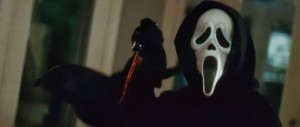
If Ghostface had narrowed the scope to “What’s your favorite scary movie from 1990 to 1995” I think his victims would still be trying to find one.
Even though I’d let my Fangoria subscription lapse, I’d kept up with horror film production in the 90s. I knew that Wes Craven, creator of the A Nightmare on Elm Street franchise, was working on a new slasher film… and I wanted nothing to do with it.
Though I idolized Craven growing up, due exclusively to the Nightmare series, the director’s later works were crap.
I was unimpressed and felt betrayed by Craven’s incoherent and bloodless 1989 slasher Shocker — though I have since come to love the film for the over-the-top “schlocker” that it is. Then in 1991 I raced opening weekend to see The People Under the Stairs, and was simply bored.
I still didn’t learn. I became ecstatic when I heard Craven’s next film would be a return to the Elm Street series, the director promising to make Freddy frightening once again. When I walked out of Wes Craven’s New Nightmare I felt I had seen my last Craven film. You can hear my full New Nightmare review in the Now Playing Podcast archives, but I truthfully wondered how I ever idolized this man who seemed able to only make terrible movies.
That line of thought was cemented with 1995’s Eddie Murphy horror comedy Vampire in Brooklyn, a film I saw out of devotion to Murphy, not Craven.
So in 1996, hearing Craven was going to make a new horror film was actually a turn-off. In ‘96 I would have rather gone to theaters to see Lawnmower Man 2: Beyond Cyberspace than Craven’s Scream.
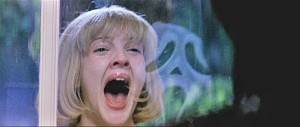
Scream turned Barrymore into an A-list star once again.
The cast did nothing to change this impression. Press materials touted Drew Barrymore’s role, and that seemed a bad sign. Back then she was still the little girl from E.T. who, like so many child stars, had developed a dependency problem. While I had seen her work in Boys on the Side and Mad Love I thought her heyday was behind her; the only roles she had in major releases were bit parts in Wayne’s World 2 and Batman Forever. She seemed “over” in Hollywood. I would never have guessed that, thanks to Scream, Barrymore was poised for a return to superstardom.
The rest of the cast — actors I’d not heard of or knew only from television shows — also failed to grab my attention. The only cast member that caught my interest was Matthew Lillard, whose zany performance I’d loved in Hackers, yet that was not near enough for me to want to see this movie in theaters.
Most of all, the film’s trailers didn’t hook me. I thought the killer’s mask was silly — had Michael Myers and Jason Voorhees taken all the good killer masks? I admit I was intrigued by the thought of characters that knew horror movie tropes; I mean, this was a horror movie where the characters were people like me. Still, with Craven’s name on the poster I wanted nothing to do with it.
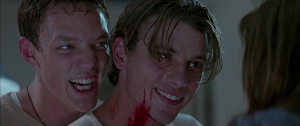
Lillard would go on to the Scooby Doo films after himself being unmasked as the bad guy in Scream.
I saw Scream in theaters only because I was invited by a group of friends and my options were to go to this movie or stay home alone. I wasn’t happy about going, and I anticipated a wholly miserable People Under the Stairs type of experience.
To say I was won over is an understatement. The film did have a good deal of true horror, with the opening murder scene a suspenseful highlight. With the scares firmly established, the movie achieved a near-perfect balance between self-referential humor and legitimate tension. While, due to my age, I was not afraid, the film did succeed in making me jump a couple of times.
In 2011 I gave my full review of Scream as part of our retrospective series leading up to Scream 4, so I will not repeat myself here. You can listen to that full review for a blow-by-blow analysis by Stuart, Marjorie and myself.
In short, not only did Scream win me over; I feel it is Craven’s best film — even better than my beloved A Nightmare on Elm Street.
I believe Craven was greatly assisted by the script from first-time screenwriter Kevin Williamson. Having seen many films made from Craven-penned scripts, none come near Scream in terms of plot twists, fleshed-out characterizations, and careful plotting. The movie was a whodunit, something I didn’t expect in a slasher. After all, in most slashers I knew the killer was Freddy or Michael or Jason or Chucky. That the killer was one of the kids was a fun experience — me trying to outwit the characters and peg the killer. When the mask is removed and the full story revealed, even I was taken aback by some of the twists. This is all Williamson, and I give him full credit for the film’s quality.
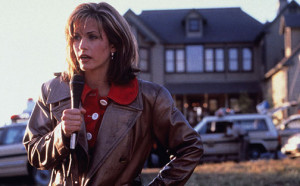
I watched Friends, but never saw Cox as a good fit for horror. Again, I was wrong.
Yet I cannot overlook Craven in the director’s chair. While the script was great, Craven brought two decades of horror experience to Scream. He knew how long to hold a moment, how to reveal a body, and how to build tension that would climax with a jump scare.
My heart was racing as I left the theater. This was the first great original horror film I’d seen in many years, yet had I known the long-lasting impact Scream would have, my exuberance would have been even greater.
The movie went on to make nearly $175 million on a $15 million budget, reminding Hollywood that a good horror movie can provide substantial returns.
Scream single-handedly revived the entire horror genre. The next year gave us not only Scream 2, but also — thanks to Williamson’s success — the enjoyable, but forgettable, I Know What You Did Last Summer.
We also got the Wes Craven-produced Wishmaster, which I saw in theaters and found a weirdly awful throwback to the days of Leprechaun.
By 1998, other studios had caught on and the post-modern, self-aware horror film had its heyday with Bride of Chucky, Halloween H20, Urban Legend and The Faculty. The quality was mixed, but all were far better films than Lawnmower Man 2 or The Curse of Michael Myers.
Scream made me appreciate Craven’s ability, but even more its success spawned dozens of films I’ve enjoyed over the past 20 years. For that reason alone, if not just for the movie itself, Scream might just be my favorite scary movie.
Tomorrow — 1997!
Arnie is a movie critic for Now Playing Podcast, a book reviewer for the Books & Nachos podcast, and co-host of the collecting podcasts Star Wars Action News and Marvelicious Toys. You can follow him on Twitter @thearniec
August 26, 2014 Posted by Arnie C | 40-Year-Old Critic, Movies, Now Playing Podcast, Podcasts, Reviews | 1990s, 40-Year-Old Critic, A Nightmare on Elm Street, Enertainment, Film, horror, Kevin Williamson, Movie, Movies, Now Playing, Now Playing Podcast, Podcasts, Review, Reviews, Scream, Slasher, Wes Craven | Comments Off on The 40 Year-Old-Critic: Scream (1996)
Children of the Corn II: The Final Sacrifice
Children of the Corn 2: The Final Sacrifice was released to little fanfare and was barely in theaters. The sequel had no involvement by original author Stephen King, and no returning members of the cast or crew of the 1984 film. Yet, despite being released nine years after the original film, this sequel picks up just days later and reveals what happened to the surviving children of Gatlin. Was this story needed, and is there any enjoyment to harvest from this Corn? Join Arnie, Stuart, and Jakob to find out!
Arnie C: http://traffic.libsyn.com/nowplayingpodcast/NPPCOTC02.mp3
August 25, 2014 Posted by arniec | Movies, Now Playing Podcast, Podcasts, Reviews | Enertainment, Film, Movies, Now Playing Podcast, Podcasts, Reviews | Comments Off on Children of the Corn II: The Final Sacrifice
40 Year-Old-Critic: Leaving Las Vegas (1995)
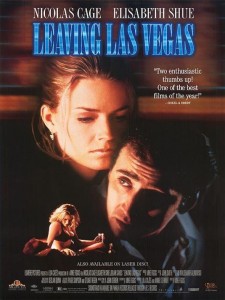 In The 40-Year-Old Critic, Venganza Media creator and host Arnie Carvalho recalls a memorable film for each year of his life. This series appears daily on the Venganza Media Gazette.
In The 40-Year-Old Critic, Venganza Media creator and host Arnie Carvalho recalls a memorable film for each year of his life. This series appears daily on the Venganza Media Gazette.
Have you ever had the feeling that the world’s gone and left you behind….
More than any other form of art, films have a soul. Moviegoers can experience a picture on more than an intellectual level; sometimes there is a base, emotional connection. Watching a great film can be akin to falling in love.
This is a view I first articulated while reviewing Gus Van Sant’s 1998 remake of Alfred Hitchcock’s Psycho for Now Playing Podcast (part of our Fall 2012 donation drive, that review is no longer available). That film showed two talented directors could take the same script, sometimes even the same camera shots, and produce different results. One filmmaker created art that engrossed and thrilled audiences, while the other produced a rote, mechanical and generic film.
Tens, hundreds, or even thousands of people — depending on the scope of the production — come together to create a single experience for a viewer. Even I sometimes forget this; the auteur theory takes hold and I focus on the director as sole creator of a vision. While the director usually maintains creative control, sometimes even through the editing stages, the movie itself is the result of millions of little decisions made by every actor, set dresser, composer, editor, and cameraman on the production. With the right people involved even the most mundane script can become a memorable experience.
One prime example of such a script elevated by those working on it is Leaving Las Vegas, the 1995 drama directed by Mike Figgis, starring Nicolas Cage and Elisabeth Shue. On paper, this movie seemed like the most trite of stories — depressed drunk Ben Sanderson (Cage) is a Hollywood screenwriter whose penchant for drink has ruined his every personal and professional relationship. When he is finally fired from his job he is ready to die, so he takes the last of his cash to Las Vegas where Ben plans to drink himself literally to death. In Vegas Ben hires a prostitute Sera (Shue), the damaged hooker with a heart of gold. The two lost souls fall in love, yet neither is willing or able to change their self-destructive habits.
These character tropes are so hackneyed that I would expect this to be a film made in the 1930s, when stories and characters were broader, and not the 1990s.
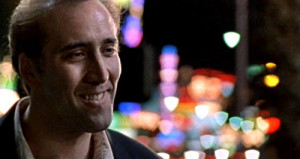
Cage in one of his more charming scenes, back-lit by the lights of the Vegas strip.
The film is based on a novel by John O’Brien. I have not read that book, but I have no doubt of O’Brien’s commitment to the material. Two weeks after discovering Leaving Las Vegas was to become a film, O’Brien used his gun to commit suicide. Clearly this was a man who understood the struggle with depression and the impulse to kill yourself. Yet, despite the insight his prose may offer, I have no interest in reading a book about two stereotypical characters going through a depressing endeavor. It may be very well written and I may be missing out, but the story itself sounds uninteresting.
Yet, despite cliched characters and a tired plot, in the hands of these filmmakers the result is a dramatically moving experience. Few movies I’ve seen in my life parallel the emotions stirred in me by Leaving Las Vegas, for what this team did, through filming and editing, was craft a film where the plot matters less and the characters matter more.
The tale is about a drunk, and the editing and filming often give the film a fugue-like ambiance. Sometimes the dialogue is crystal-clear, loud and in full focus. Other times the music mix raises. Sometimes you hear nothing as the actors’ lips move, other times there are words but you cannot make them out. It’s a dream-like experience that reminds me of techniques used by David Lynch.
The impact of the music cannot be overstated. The score, composed by Figgis himself, sounds like music played around 2 a.m. at an upscale bar. Heavy with piano and saxaphone, the music has a slow jazz feel that underlines the emotions of the moment. More, in an unusual move, some of the score is lyricized and sung by Sting. It blurs the line between soundtrack and score, but in the process creates sorrowful ballads of love and loss. Those original compositions intermix with covers of classic songs, such as “Lonely Teardrops” sung by Michael McDonald.
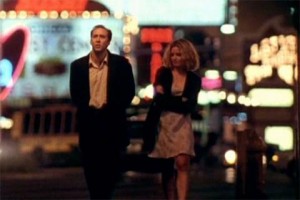
The sounds of the street often drown out character dialogue, to great effect.
The result sometimes feels like a depressing music video or an “in memoriam” montage, played while the characters still live. That Figgis is so willing to part with dialogue and just convey mood shows that in Las Vegas plot doesn’t matter. This is a character-driven story and we don’t need to hear their words to feel their pain.
This type of disregard for traditional narrative is used at the micro and macro scale. Sometimes the film cuts to the future suddenly, and we return to the present when Ben comes out of his stupor. We learn about the missing moments when Ben asks what happened. This is a movie told primarily from Ben’s shaky, out-of-focus point of view, and the camerawork and editing embody that mindset.
More than the cinematography, this film hops in and out of Ben’s own head. Sometimes we see Cage saying outrageous things, but then we discover it was only a fantasy in the character’s mind. In contrast, sometimes Ben makes equally offensive statements out loud and faces the very real consequence. As his blood alcohol content rises Ben cannot distinguish reality from fantasy, and, like Ben, the audience never knows exactly what is happening and what we can believe.
Of course, Figgis could not accomplish this alone. In the hands of a lesser actor than Cage Leaving Las Vegas could become an unintentional comedy quickly forgotten. Now, 20 years later, Cage is often disregarded, written off due to a long string of bad movies in which the actor makes unfortunate character choices.
Cage is an actor who gets off on playing characters in unconventional ways and giving them strange mannerisms. Often that will alienate the audience, but in Leaving Las Vegas Cage commits totally to the role. His body language exudes desperation. In one of the movie’s first scenes Ben is unintentionally sober, craving drink, and hitting up some colleagues for cash. He comes off sweaty, clumsy, and off-putting. One scene later, after a few drinks, Ben has an undeserved, over-inflated sense of self-confidence and makes improper advances on an attractive woman at the bar. It’s a wild swing of character, and is played perfectly through Cage’s intonation, eye work, and mannerisms.
This type of character could alienate audiences. Had viewers seen Ben as more creepy than sympathetic the result could be quite different. It’s little moments Cage plays, such as sobbing “I’m sorry” when being fired, that show humanity in this sad soul. It makes him someone we feel for, rather than pity.
I was a fan of Cage’s coming into Leaving Las Vegas, with Guarding Tess, Trapped in Paradise and Wild at Heart as highlights (though I’d also suffered through Kiss of Death, It Could Happen to You, and Amos & Andrew). Cage often gave captivating performances, but none I’ve seen before or since match his Oscar-winning performance here.
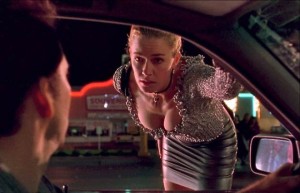
Despite how they meet, the relationship between Ben and Sera is about love, not sex.
Matching Cage’s portrayal is co-star Shue. In her roles in Back to the Future 2, Adventures in Babysitting, and even Cocktail I’d found the actress to be capable, but unexceptional. As Sera, Shue shows a range I’d never seen before. Early in the film Sera is a hooker, and very good at her job — she instinctively knows what the John wants, and becomes it. With Ben we see Sera start to open up. She lets down her guard, takes off her make-up, and becomes a real person. The transformation is startling, as is Shue’s lack of vanity in several unflattering scenes.
But Sera is not your normal streetwalker — she also has regular visits to a therapist. In these scenes we get to see inside Sera’s thoughts through monologues, confessions taken from her therapy session. As edited, these moments play like scenes from the confessional booth in MTV’s The Real World, but without them we would never be able to trust Sera. We never see the therapist; Shue is giving brief one-woman performances, but conveying pure emotion. This is a challenge for any actor, and she pulls it off. Shue fully deserved her Academy Award nomination for this performance.
Together Cage and Shue create a wholly believable, wholly dysfunctional, couple. Both broken characters are instantly drawn to the other. Though Sera knows Ben may be trouble, she puts that aside and chooses to follow her heart. The film avoids making their relationship too gross or base by actually, and believably, removing sex from the equation–while Ben hired Sera for physical gratification the liquor prevented him from performing. He becomes the only character not sleeping with Sera, even choosing to sleep on the sofa at night despite Sera’s repeated offers of more.
These two share a chemistry and a spark on screen that few romantic films can match. Though it’s a futile hope, it’s easy to root for these two to overcome their hardships through their new-found love.
Those two actors are the primary cast but even the minor roles are perfectly played by actors you’ll recognize; from Steven Weber (Wings, Stephen King’s The Shining), to comedian Richard Lewis, to Laurie Metcalf (Scream 2, Roseanne). It could almost be a drinking game — take a shot when you see an actor you know. With French Stewart, Shawnee Smith, R. Lee Ermey, Mariska Hargitay, and even, in the thankless role of bank teller, License to Kill’s Carey Lowell, you would be as drunk as Ben when credits roll.
No one on screen breaks the mood. Figgis has created his own Vegas, sometimes romanticized, sometimes demonized, but always real.
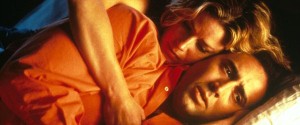 Leaving Las Vegas is a film with layers. On the surface, taken literally, the plot is about a terminal man and the woman who loves him as he dies. In such a bland interpretation, Sera is nothing but a fantasy, a female who serves a man’s needs. Sera describes herself as being instinctively able to become what her clients want, and she does that for Ben. Early in the film the drunk fantasizes of a woman pouring liquor on herself so he can drink off her, and she would have purpose. Ben never tells that to Sera, but she does that for him — alcohol and sex, Ben’s fantasy realized. Ben calls Sera, “my Angel”, and you could see her as nothing but.
Leaving Las Vegas is a film with layers. On the surface, taken literally, the plot is about a terminal man and the woman who loves him as he dies. In such a bland interpretation, Sera is nothing but a fantasy, a female who serves a man’s needs. Sera describes herself as being instinctively able to become what her clients want, and she does that for Ben. Early in the film the drunk fantasizes of a woman pouring liquor on herself so he can drink off her, and she would have purpose. Ben never tells that to Sera, but she does that for him — alcohol and sex, Ben’s fantasy realized. Ben calls Sera, “my Angel”, and you could see her as nothing but.
Yet to take that interpretation is to miss several important details. Sera is, in many ways, a mirror of Ben. Both came to Vegas from Los Angeles. Both are recently unemployed (Sera finding herself without purpose when Yuri, her lover and pimp played by Julian Sands, is murdered by Russian mobsters). Both characters are deeply wounded and on dangerous paths. And both accept each other unconditionally; Ben’s condition of being with Sera is that she never ask him to stop drinking. Likewise, Ben is accepting of Sera’s profession, knowing that she will continue to hook while he lives with her.
 Finally, Ben’s course is a straight one. He starts and ends the film a drunk and he never waivers from his path of self-destruction. It would be nihilistic if his story was the only one in the film. Yet through loving Ben, Sera softens. The relationship forces Sera to mature, and she evolves from accepting her doomed relationship to trying to fix it, finally asking Ben to see a doctor. When Ben responds by bringing another woman home to her bed, she instantly kicks him out — she was not that strong when the movie began and she was working for Yuri.
Finally, Ben’s course is a straight one. He starts and ends the film a drunk and he never waivers from his path of self-destruction. It would be nihilistic if his story was the only one in the film. Yet through loving Ben, Sera softens. The relationship forces Sera to mature, and she evolves from accepting her doomed relationship to trying to fix it, finally asking Ben to see a doctor. When Ben responds by bringing another woman home to her bed, she instantly kicks him out — she was not that strong when the movie began and she was working for Yuri.
The star of the movie is clearly Cage as Ben, but every time I watch this film I become more convinced the true main character is Shue’s Sera. And it is through Sera that I found my own redemption in 1996.
That summer I had graduated college. My Communications degree and B-average in were not opening any doors. I had a small apartment in a boring town. Most of my friends had left for bigger cities and greater opportunities. My full-time job was working nights as tech support for an Internet company. It didn’t demand much; I sat alone in an abandoned building for eight hours a day, answering the phone on the rare occasion that it rang. It also didn’t pay much; I was living on $8.25 per hour.
Not that I had career aspirations. In college I spent my time doing my coursework and never got to the other things I wanted to do — write some screenplays or even publish some short stories. I had nothing to build my resume, and no idea what career path I should take. I still wanted to entertain people — that drive instilled since seeing Pump Up the Volume — but come fall, even my gig as a DJ would be taken away.
Despite having family living in my same town, we were never close. I preferred being alone in my dark apartment to spending time with them (and I loathed being alone). I was so desperate for friendly contact that, despite having graduated, I asked my college radio station if I could continue to work (for free) as a DJ through the summer.
Mostly, I was lonely. While friends would have alleviated this problem, to me the solution was a girlfriend. Many of my college friends had married soon after graduation. It is very easy for a lonely straight man to envision a woman as the answer to his troubles, and I certainly fell into that mindset. Yet with few friends, no social events to attend, and Internet dating not yet commonplace, I had no way to even meet a woman unless she happened to be delivering my pizza one Friday night.
With all these troubles, no money, few friends, bad job, no prospects, I was suffering from a deep depression.
I was never suicidal, but my overriding emotion was one of apathy, with a side of hopeless despair. My only pleasure in life came from movies. I couldn’t afford to see many in theaters, but I spent what little surplus income I had at the rental store week after week.
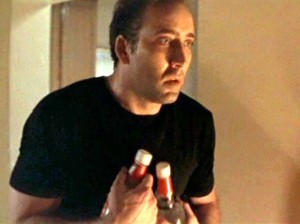
Ben’s constant fight against DTs show alcoholism isn’t a glamorous way to die.
That was when I found a kindred spirit in Ben Sanderson. Despite having recently turned 21, I was never much of a drinker. Still, there was something romantic in the very notion of going to Sin City and dying through copious consumption.
Yet through this act of destruction, Ben found his “angel” in Sera. And despite connecting with Ben’s depression, in Sera I saw strength and hope. Sera was in an equally bad situation — her “career” was short-term and dangerous. She was a smart, attractive woman, and even the Vegas cabbies were telling her she could do better than her station in life. When the movie ends Sera loses her love but gains hope for a brighter future.
Through Leaving Las Vegas’ trippy mood, moving characters, and tale of redemption I found my own. I was inspired out of my funk. Nothing happened quickly, but over the next four years my ambition redoubled, I went back to school to get a more employable degree, and I met my wife. But when my future seemed nearly as bleak as Ben’s, Leaving Las Vegas showed me the neon light at the end of a tunnel.
I believe that connection is partially because of the tragic, sad story presented, but the experience is heightened by Figgis’ choice to drop out dialogue and scenes. Figgis’ music created an emotional call-and-response; when the film’s dialogue was drowned out my own struggles filled in the blanks. When the dialogue faded out I would project my pain into the film, mixing with Ben and Sera’s until we were indivisible.
Even today, as I live a much happier, optimistic, and realized life, the film still moves me. You don’t have to be in pain to empathize with those in pain; you don’t have to hear their words to know their struggles.
This is where Leaving Las Vegas transcends being a movie and becomes a full, engrossing experience. This is the soul of a film.
Tomorrow — 1996!
Arnie is a movie critic for Now Playing Podcast, a book reviewer for the Books & Nachos podcast, and co-host of the collecting podcasts Star Wars Action News and Marvelicious Toys. You can follow him on Twitter @thearniec
August 25, 2014 Posted by Arnie C | 40-Year-Old Critic, Movies, Now Playing Podcast, Podcasts, Reviews | 1990s, 1995, 40-Year-Old Critic, Alcohol, Alcoholic, Drama, Elisabeth Shue, Enertainment, Film, Las Vegas, Leaving Las Vegas, Mike Figgis, Movie, Movies, Nicholas Cage, Now Playing, Now Playing Podcast, Podcasts, Review, Reviews, Romance | 1 Comment
40 Year-Old-Critic: Natural Born Killers (1994)
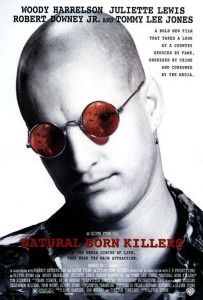 In The 40-Year-Old Critic, Venganza Media creator and host Arnie Carvalho recalls a memorable film for each year of his life. This series appears daily on the Venganza Media Gazette.
In The 40-Year-Old Critic, Venganza Media creator and host Arnie Carvalho recalls a memorable film for each year of his life. This series appears daily on the Venganza Media Gazette.
Mister rabbit says, “A movie review is worth a thousand prayers.”
In 1994 I was in college with aspirations of filmmaking. While my university did not have a dedicated film curriculum, my Mass Media Communications major with a Creative Writing minor afforded me classes in screenwriting, film criticism, editing, camerawork, and more.
But as the major was not simply film, there were numerous other classes I had to take for my degree. The list included Communication Ethics, First Amendment rights, studies of media impacts on the audience, and journalism, to name a few. As a college junior, I lived and breathed my major. Every form of entertainment I enjoyed, from video games to television to books to film, was a subject for my college studies. I wrote papers and gave multimedia presentations on violence in film, with a special focus on the Friday the 13th and Nightmare on Elm Street franchises.
But that year produced something unexpected from Oliver Stone and Quentin Tarantino. I was used to films factoring into my curriculum, but I never expected a major motion picture to be studying the same topic.
Natural Born Killers did just that.
The story is pure Tarantino. Having rewatched both True Romance and Reservoir Dogs multiple times I instantly saw a familiar trope in Mickey and Mallory Knox — the killers/anti-heroes of this film. Seeing two young outlaws in love and on a crime spree seemed right out of True Romance. That they are also merciless murderers felt like an extension of some of the characters from Reservoir Dogs — Mickey and Mallory could be Mr. and Mrs. Blonde. Finally, the film has a non-linear narrative that ends in a Mexican standoff. Despite Tarantino distancing himself from the production I saw his fingerprint on the negative.
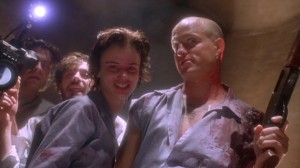
Despite the carnage, there was something pure and romantic about Mickey and Mallory’s love affair. It was sick and twisted, but also sweet.
I did later read the original script, which was published in book form. That draft was far more Tarantino, but still a reach for the director. More than a crime film, Tarantino’s Natural Born Killers had a pointed critique on American tabloid journalism.
Yet, in the hands of Oliver Stone, the film’s focus on the media grew exponentially. Stone, along with screenwriters David Veloz and Richard Rutowski, rewrote the script to the point that Tarantino ended up only receiving story credit. In the hands of Stone’s team, Natural Born Killers became a scathing commentary on American media.
It could not have hit at a more appropriate time. Rush Limbaugh was scoring big on radioand television with his daily indictment of the Clinton administration. Meanwhile the country was transfixed by the O.J. Simpson case. While this movie was released a few months before the trial began, the Ford Bronco chase and Simpson’s arrest were constant news.
The media focus seemed to go from one real-life drama to the next, be it Amy Fisher, Tonya Harding, Heidi Fleiss, the Menendez brothers, or even Woody Allen’s divorce from Mia Farrow — all were fodder for the newspapers and 24-hour news channels. What had once been the domain of the National Enquirer was suddenly considered “real news.” It seemed everyone was being given a talk show, and those who couldn’t host a show tried to get their 15 minutes of fame by appearing on one.
It’s ironic that Stone undertook this film as a chance to make a simple action picture, but he doesn’t do “simple.” As such, the result is an indictment not only of the media companies that propagate such coverage, but also the populace that consumes it.
Mickey and Mallory Knox, as brought to life by Woody Harrelson and Juliette Lewis, are products of the media. Despite Harrelson being in his early 30s when this film was made, Mickey and Mallory feel like members of the “MTV Generation.” These two realize they will never be TV stars, so they’ll be the next best thing: headline-makers. They guarantee it, always leaving one person alive to tell the media about Mickey and Mallory.
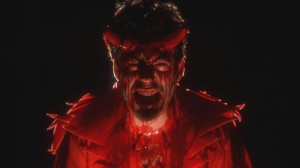
Stone has never been accused of being too subtle.
The journalists are not left untouched, though. The second half of the movie gets a shot of adrenaline in the form of Robert Downey, Jr., turning in a tremendous performance as tabloid TV reporter Wayne Gale. With an affected Aussie accent and an equally affected sympathetic persona, Gale convinces Mickey to do his first TV interview. As the film’s madness grows Gale starts to believe his own press, and eventually realizes the time comes when the audience wants to turn the TV off.
From the first frame to the last, Natural Born Killers is a film about the superficiality of personas, examining the concept of who a person is versus how he/she wants to be seen. While that difference is often greatest in the cases of public figures who must act a certain way in public but may be very different behind closed doors, the script shows that everyone has that secret face. The insight to that is Detective Jack Scagnetti (Tom Sizemore), who appears to be the heroic cop who brings down Mickey and Mallory. Yet the audience sees that he is a mirror image to Mickey. While Mickey kidnaps, rapes, and murders an innocent woman, Scagnetti hires, screws, and strangles a hooker.
Every character in the film is disgusting and immoral–save one Navajo Indian from whom Mickey and Mallory seek shelter. This character calls out blatantly that the two killers watch “too much TV.” While the mystical, magical medicine man is a blatant stereotype, he is the only character in the film who doesn’t deserve a bullet (but he gets one anyway). The police, the media, Mallory’s parents, even the random stranger Mallory seduces at a gas station, are all contemptible and repugnant.
In other words, they’re the product, creators, and consumers, of tabloid journalism.
Yet, for all of the high-minded idealism of the movie, Natural Born Killers avoids the usual “message movie” pitfall of heavy-handedness, which I discussed in my review of Philadelphia.
Stone’s filmmaking is too frenetic, too fast-paced, to ever linger. The film’s style changes with the scene; one moment we are seeing Mallory’s family portrayed as a sitcom, complete with laugh track, the next we have grainy black-and-white footage. There are even animated sequences inserted into the film that visualize the emotion of a scene. There is no way for the film to linger, there is too much going on.
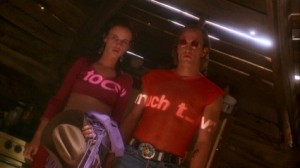
Something as simple as projecting a slide on actors felt fresh among the ever-shifting styles in Natural Born Killers.
In that regard, the picture is a critique of its audience. Stone knew that moviegoers in the 1990s had short attention spans, so he created a film perfectly suited to the mindset of an ADD-addled channel-flipper. The story and characters remain the same, but the tone, even the film stock, continually change. Stone also inserts bits of real commercials, as if he holds the remote we’re watching him scan to see what else is on.
The result is a trippy, psychedelic movie that truly feels like a tonal companion piece to his 1991 film The Doors. Mickey and Mallory are also rock stars of the media, and they even seek guidance from the spiritual Native American.
Like that earlier Stone film, Natural Born Killers is an experience more than a narrative. The color pallette, the transition to animation, the first-person camera shots years before found footage films were en vogue, the result is less narrative and more emotional.
And like The Doors, Natural Born Killers is propelled by a strong soundtrack. While the former film was almost exclusively set to Jim Morrison’s music, it was limited by the subject matter. Natural Born Killers doesn’t have that limitation, and the styles of music represented are as scattered as the film techniques.
Stone collaborated with Nine Inch Nails’ Trent Reznor to produce the soundtrack, and the result is a thumping, yet moody, symphony of discord. Music from Patsy Cline is interwoven with Patti Smith, Bob Dylan, L7, Dr. Dre, and much more — with a healthy dose of Leonard Cohen at the beginning and end.
Listening to the soundtrack is almost as involving an experience as watching the film. Reznor did not simply follow the Reservoir Dogs formula of putting film clips on the CD, he actually mixed it with the music, creating an aural cinematic experience.
(Though for those of us who are musical purists, it also ensured I bought many of the bands’ original albums to have versions of the songs without added effects and dialogue. It was this album that set me on the road to Leonard Cohen super-fandom.)
This entire tone could have been undercut by the lead actors, but Stone directed his cast expertly. All the leads, and key supporting characters, have left realism at the door. Exaggeration is the name of the game, so lines are screamed or drawled, movements emphasized, and facial expressions broad. Alone, that type of acting could undermine a film, but with the crazed visuals that accompany the scenes anything more natural would be lost.
The standout of the cast is Harrelson. Much like Tom Hanks with Philadelphia, I knew Harrelson from his comedies — not just Cheers, but Doc Hollywood, White Men Can’t Jump and even The Cowboy Way. I worried he could not pull off a performance as a homicidal maniac. More, as Harrelson was the son of a hit man who may have been involved in the John F. Kennedy assassination, it felt like stunt casting of the worst type.
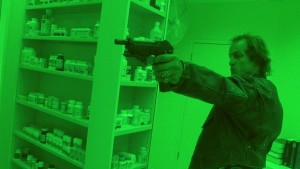
Harrelson left behind his good-ol-boy persona and fully inhabited the homicidal persona of Mickey Knox.
I was again wrong as I watched Harrelson, head shaved, fall into the character. By the film’s climax — when he has to break the fourth wall and deliver the line “I’m just a natural born killer” — all thoughts of comedy were gone. He was just a bad-ass, homicidal, rock star.
His performance is clearly aided by those of his co-stars. Lewis, a quirky actress I first noticed with 1993’s Cape Fear, is perfectly cast as a psychotic who becomes empowered and emancipated by following Mickey’s murderous examples. Sizemore carries a sleazy menace that follows him to every frame. Even Tommy Lee Jones overacts to the heavens as the spiteful prison warden. The result is a cast in perfect harmony, complimenting each other and their movie.
When I saw this film in theaters opening weekend I was mesmerized. I walked out, my head full of new viewpoints that I could incorporate into my coursework. I went back the very next day to try and catch more of the film, and to again experience the weird acid trip it offered.
Natural Born Killers spoke to me at a time in my life where I was already receptive to its message. I walked in expecting a road movie featuring mass murderers. I left thinking about media, and my own role in its creation.
But like Stone’s earlier film Wall Street, I feel the message of Natural Born Killers has been lost at best, or perverted at worst. Several instances of “copycat crimes” have appeared in the media, killers completely missing the point and, instead, are seemingly inspired by Mickey and Mallory Knox. It’s impossible to say if those acts would have been done without this film, but it’s a sad irony that a movie about the dangers of media violence then creates its own.
Yet every day when I look at the news, I feel that Natural Born Killers did not succeed in warning the media, or its consumers, about the impact of tabloid journalism. From Britney Spears’ head-shaving incident to Charlie Sheen’s “winning” display to even Robin Williams’ tragic suicide, the media is there to try and grab big ratings under the guise of informing the public.
On TV, audiences laughed at the obviously drugged antics of Anna Nicole Smith, until she died from her drugs. Audiences insist on Keeping Up with the Kardashians and watching Honey Boo Boo, The Bachelor or Catfish. Producers and editors sculpt clips from those shows, take sound bites out of context, and spend thousands of hours creating an audience-pleasing narrative of good versus bad that may have little bearing on reality.
I don’t know if fans of these shows a) don’t realize they manipulate the stars and their audience, or b) don’t care. Either way, we continue down the spiral to Stone’s original vision.
But if Natural Born Killers’ message didn’t last, the film didn’t stick with me either. Through my college years Stone’s film was in heavy rotation on my VCR. When the VHS release of the Director’s Cut came in 1997 (so long it had to be on two tapes) I rented it the first day. That was when I felt the trippy effect had finally worn off and I was no longer under the movie’s spell.
The scenes cut from Natural Born Killers — available on the second VHS tape — had every reason to be cut. I watched the extra hour Stone filmed for this movie and realized that, truly, this was a film made in the editing bay and not on the set. Assembling all the footage, including the cut trial scene and Mickey and Mallory’s attack on wrestling brothers Simon and Norman Hun, I realize Stone had a production out of control. The behind-the-scenes knowledge soiled this film for me, and for a decade I had trouble watching it at all. Now I can credit the final product, knowing how bad this movie almost was.
But in the fall of 1994 two Tarantino scripts were in theaters simultaneously: Natural Born Killers and Pulp Fiction. The masses crowded around Fiction, and Tarantino took home Oscar gold.
I greatly enjoy that second Tarantino-directed film, but if you asked me in the mid-90s to name my favorite of those two works, it had to be Natural Born Killers.
Tomorrow — 1995!
Arnie is a movie critic for Now Playing Podcast, a book reviewer for the Books & Nachos podcast, and co-host of the collecting podcasts Star Wars Action News and Marvelicious Toys. You can follow him on Twitter @thearniec
August 24, 2014 Posted by Arnie C | 40-Year-Old Critic, Movies, Now Playing Podcast, Podcasts, Reviews | 1990s, 40-Year-Old Critic, Juliette Lewis, Mallory, Mickey, Movie, Movies, Natural Born Killers, Nine Inch Nails, Now Playing, Now Playing Podcast, Oliver Stone, Podcasts, Review, Reviews, Robert Downey Jr, Trent Reznor, TV series, Woody Harrelson | 2 Comments
40 Year-Old-Critic: Philadelphia (1993)
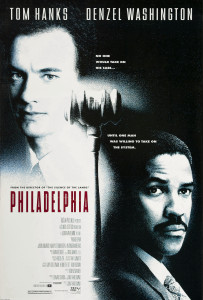 In The 40-Year-Old Critic, Venganza Media creator and host Arnie Carvalho recalls a memorable film for each year of his life. This series appears daily on the Venganza Media Gazette.
In The 40-Year-Old Critic, Venganza Media creator and host Arnie Carvalho recalls a memorable film for each year of his life. This series appears daily on the Venganza Media Gazette.
In many of these reviews I have observed how film can be an experience that takes you to other places and vicariously allow you to have extraordinary adventures. That was my childhood focus for films — escapist entertainment. As I aged, though, I came to discover film could also educate and open a window into the world of people totally different than myself.
The film that drove that point home more than any that came before was Jonathan Demme’s Philadelphia — a film I initially had no interest in seeing.
The picture had good people involved. Demme was not a favorite director of mine, but I had enjoyed Married to the Mob and fell in love with The Silence of the Lambs; the latter preceding Philadelphia by a couple of years. Likewise, co-star Denzel Washington had impressed me in his Oscar-winning role in 1989’s Glory. Both of these talents I liked, but neither did I love.
That affinity was thwarted by two large barriers.
My biggest problem with the film, before I even saw it, was star Tom Hanks. I had loved Hanks in the 80s. I had seen every episode of Bosom Buddies at least three times each; along with most of his films — Splash, Big, and Turner & Hooch are favorites. But by 1993 I felt Hanks was washed-up; a product of the 80s. The turn of the decade came and Hanks was starring in two of the worst films I had ever seen: Joe Versus the Volcano and The Bonfire of the Vanities. Sleepless in Seattle had also put me to sleep in theaters, and despite his acclaimed supporting role in A League of Their Own, I felt done with Hanks entirely.
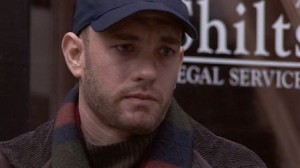
Despite having been a fan of Hanks in the 80s, he was a barrier to my seeing Philadelphia.
More, I pigeonholed him as a comedian. The thought of this guy doing a dramatic performance as a gay man dying of AIDS seemed funny for all the wrong reasons. I thought it was miscasting of the worst possible kind and that the film would be a train wreck.
But no matter who starred in the film, I still wouldn’t have rushed to see this it. From the trailers, from the interviews I read, from the film’s very premise, Philadelphia seemed like a movie with an agenda.
I had seen similar films by this point, from Born on the Fourth of July, to 1987’s Project X, to Gorillas in the Mist. I found them to be self-important slogs that would often have an effect opposite of what was intended. I was so put off by the picture I would feel kinship with the opposition. I had started to avoid “message movies” altogether.
Additionally, I was untouched by the AIDS epidemic. I had seen it covered on television shows like L.A. Law and St. Elsewhere and some “very special” sitcom episodes. I had watched the explosion of news coverage in the 80s. I was in the safe-sex ed classes in high school. I felt I knew all I needed to know, and I didn’t need to pay $7 for a movie to try and drive that point home again.
Further still, I wasn’t gay and, despite being a college student, had no gay friends (at least none that I knew of). Again, I had seen gay characters on television and in other films, but it was not a lifestyle, or even a cause to which I felt connected. My suburban, middle-class lifestyle made it all very unrelatable.
A combination of factors changed my mind, and I ended up seeing Philadelphia in theaters its opening week. First was the buzz surrounding the film. Critics I respected, and those who had lambasted Bonfire, heaped praise upon the film. It had started to become a topic of conversation among my friends.
Then there was the Bruce Springsteen song “Streets of Philadelphia”, a haunting piece that got heavy radio airplay. Never underestimate the power of a hit song to bring audiences into a movie — it worked for me. I wanted to see the film that could get The Boss to perform this song in a broken voice that made it sound as if he were on the verge of tears during the recording session.
Finally, my Now Playing Podcast co-host Stuart was in town for the holidays, and we would often see movies together on Christmas Day. We had already gone to see What’s Eating Gilbert Grape and were struggling to agree on a second film to watch. He suggested Philadelphia. By that point my curiosity was piqued, so we went.
It is a fine film. Not phenomenal, not outstanding, but very well done. I felt that way then, and now upon revisiting this film. The court case, which is ostensibly the film’s plot, is engaging. It clicked with me as a long-time fan of courtroom dramas. Still, the movie wasn’t only about the plot. This is a “message movie” and the point is to start conversation about homophobia in the workplace, and a true understanding of people not only dying from, but living with AIDS.
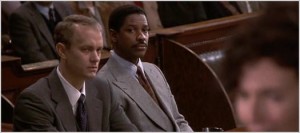
If what you want is a good courtroom drama, there are better out there. This plot is secondary to the human message of the film.
As such the plot does feel incidental.
As do any characters other than Hanks’ Andrew Beckett. The whole film is structured to engender audience sympathy for this man who lost his job, and eventually his life, due to his lifestyle and disease. Demme’s attempt to make the viewer connect with Beckett is obvious to me on a recent viewing.
More, Beckett is a character without much of an arc. He remains put-upon and in the right for most of the film. A late revelation on how he contracted the disease is a strange turn of events, but it doesn’t change Beckett for me. By that point in the film you were either on his side or walking out of the theater.
The true character arc is that of Washington’s Joe Miller. He plays Beckett’s lawyer and, over the course of the film, changes from a homophobe ignorant of AIDS and how it is transmitted, to understanding and accepting of Beckett’s lifestyle. Still, due to the script and the director, Washington’s performance and character is lost in Hanks’ shadow.
As for Hanks, who I expected to hate in his first highly dramatic screen role, Demme’s filmmaking was a success — I became fond of Beckett. The affinity I had for the actor helped me feel very comfortable with the dying lawyer he portrayed on screen. Perhaps it even created a feeling of closeness I wouldn’t have had if Beckett had been portrayed by someone unknown. Hanks physically transformed himself, losing a lot of weight to physically appear ill, and it did help both his performance and my sympathy for Beckett.
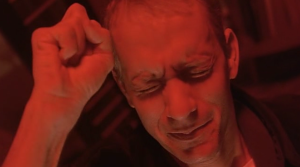
Did audiences really fall for this blatant manipulation? The film was moving, but this scene was too obvious in its pulling of the heart strings.
All that praise aside I do roll my eyes, unmoved by Hanks’ speech while playing an opera for Miller. The dramatic, high camera angle, Hanks’ closed-eye monologue with his hands raised to his head, it was the one scene of the film that felt unauthentic and overly manipulative. I imagined Hanks, after the take, grinning and telling his assistant “that is my Oscar moment.” Not only did the scene feel fake, I don’t think Hanks “sold” it to me. It was the one time I stopped seeing Andrew Beckett, and instead saw Tom Hanks. I also thought voters for the Academy Awards would be smarter than to fall for such chicanery… shows what I know about awards. They fell for it, and Hanks took home a gold statue, probably because of this very scene. With Forrest Gump the following year Hanks’ career hit new highs, and he keeps climbing to this day.
Yet I did feel moved at the end when Beckett lay in the hospital bed dying. Over the course of two hours I came to care for this man, and though his end was a foregone conclusion it still held impact.
I went into the film understanding how AIDS worked. When Miller goes to his doctor to see if he contracted AIDS from a handshake, that to me — even in 1993 — felt like an antiquated notion. More, I felt no bigotry towards homosexuals. I was a minority student at a liberal arts college and in my mind I held no judgement for anyone based on race, creed, gender, or orientation.
Still, this film opened my eyes. I may not have been discriminatory towards homosexuals, but that doesn’t negate that gays are discriminated against. I had thought that if I wasn’t a bigot than bigotry wasn’t my problem. This film helped me see another side. My views on AIDS and homosexuality were about me, this film helped me think about others. Philadelphia allowed me to experience the day-to-day life and struggles of homosexuals. No matter if I was bigoted, they must face and overcome bigotry. Just because I knew from classes how AIDS was transmitted, the film told me that even educated adults were sometimes ignorant about this disease. I may have had no gay friends, but this film made me feel as if, for two hours, I did. And I didn’t fear them or hate Andrew Beckett. I felt compassion.
More, this was one of the first homosexual characters I’d seen on screen that did not feel stereotypical. I didn’t think I knew any gay people because, in my teenaged mind, gays did not act the same as straight men. The epitome of this is Meshach Taylor’s Hollywood in Mannequin, but also George Hamilton’s Zorro, The Gay Blade, and Damon Wayans and David Alan Grier’s “Men on Film” sketch from In Living Color follow this pattern. Even the more toned down homosexual characters I knew, such as Billy Crystal’s Jodie Dallas on Soap, had affected mannerisms.
Hanks’ performance as Beckett was not a parody or a caricature — in most ways he acted like Hanks. Plus all those characters I listed were played for comedy; their homosexuality was cause for laughter. Here I was seeing homosexuality as cause for… nothing. He was just like everyone else.
This film was the first true step in my life toward a greater understanding, not just of gays but all people different from me. It helped me fully realize that a person cannot be judged by any single aspect of their character, but their whole being and the sum of their life experience.
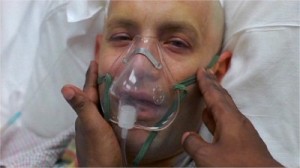
Hanks’ commitment to the role was admirable. By the end of the film he was unrecognizable.
And I wasn’t alone. Philadelphia helped break down many walls. It seemed, after this film, gay characters became more accepted by mainstream America. On television, from My So-Called Life to Pedro Zamora on the 1994 season of MTV’s The Real World, I started to see more representation of gays.
Yet they all paled compared to the 1996 ER episode which revealed Gloria Ruben’s character Jeanie Boulet to be HIV positive — the first instance I saw of someone not dying from AIDS, but living with HIV. From films like My Best Friend’s Wedding and The Next Best Thing to Ellen Degeneres’ coming out on Ellen, Philadelphia made it okay for these stories to be told.
Given the weaknesses I see in the film itself, I’m not sure that it would hold up for new viewers. For more than 20 years this film has been in the public consciousness, and American culture has changed as a result. As such, in an era of Queer as Folk, Will and Grace, and even a gay married couple on Modern Family, the film just wouldn’t seem as groundbreaking as it truly was.
But I cannot rewatch this film and not think of the world in which I lived in 1993, and how Philadelphia changed that world forever.
Tomorrow — 1994!
Arnie is a movie critic for Now Playing Podcast, a book reviewer for the Books & Nachos podcast, and co-host of the collecting podcasts Star Wars Action News and Marvelicious Toys. You can follow him on Twitter @thearniec
August 23, 2014 Posted by Arnie C | 40-Year-Old Critic, Movies, Now Playing Podcast, Podcasts, Reviews | 1990s, 1993, 40-Year-Old Critic, AIDS, Antonio Banderas, Denzel Washington, Enertainment, Film, HIV, Jonathan Demme, Message Movie, Movie, Movies, Now Playing, Philadelphia, Podcasts, Review, Reviews, Tom Hanks | Comments Off on 40 Year-Old-Critic: Philadelphia (1993)
40 Year-Old-Critic: Reservoir Dogs (1992)
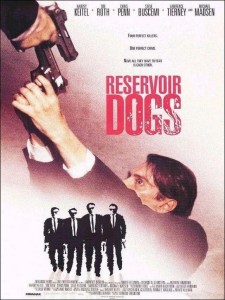 In The 40-Year-Old Critic, Venganza Media creator and host Arnie Carvalho recalls a memorable film for each year of his life. This series appears daily on the Venganza Media Gazette.
In The 40-Year-Old Critic, Venganza Media creator and host Arnie Carvalho recalls a memorable film for each year of his life. This series appears daily on the Venganza Media Gazette.
Are you gonna bark all day, little doggie, or are you gonna review a movie?
Throughout the 1980s American cinemas were dominated by blockbuster, event movies. They rose to prominence in the 70s, starting with Jaws and then Star Wars. By the “Big 80s” big films were the ticket, and the modern movie marketing machine began to form.
By the end of that decade, though, a counterculture of film had started to gain prominence — the indie picture. While this type of low-budget filmmaking was as old as movies themselves, the indies rarely received the publicity and the press afforded to large, studio films. That tide started to turn, in part due to the rise of the Sundance Film Festival in the mid-to-late 80s. Steven Soderbergh achieved critical mass with Sex, Lies, and Videotape in 1989. That same year Jim Sheriden’s My Left Foot was nominated for several Academy Awards, pushing star Daniel Day Lewis into the spotlight.
Both films were distributed by Miramax Films, a studio whose name would be at the center of the 90s indie movement. Studio heads Bob and Harvey Weinstein focused on distribution of smaller independent and foreign films. and the success of those aforementioned 1989 gave the Weinsteins a bully pulpit and legitimacy as they expanded their empire.
While I spent my senior year of high school watching big-budget fare like Lethal Weapon 3, Batman Returns, and Basic Instinct, even at age 17 I could see the shift was happening. I was regularly reading movie and entertainment magazines and following the careers of many actors and directors. I was aware of these low-budget films. Being the teen I was, I tried Sex, Lies, and Videotape, and found it to be much more dull than the titillating title had teased.
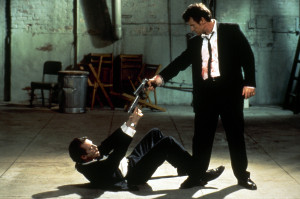
The image that sums up the movie perfectly–men ready to shoot each other.
Although I’d been consuming all of this media, I don’t remember ever hearing about a little film called Reservoir Dogs or its director, Quentin Tarantino. It wasn’t until 1993 — a year after its release — when my lifelong friend and Now Playing Podcast co-host Stuart turned me onto the film.
I had wanted to see True Romance, the 1993 Christian Slater crime film from Top Gun director Tony Scott. I missed it due to friends not wanting to see any film starring Slater post-Kuffs. Thinking I knew Stuart’s taste in film — he certainly was no fan of Slater — I didn’t even ask him, so I was surprised when he later told me he had already seen it and gave it a positive review. He even went out of his way to compliment Bronson Pinchot, of all people, while discussing the movie.
He told me the film was written by the guy who made his directorial debut with the film Reservoir Dogs. As I missed seeing True Romance in theaters (it was only in our town for one week) I immediately went out and rented Dogs with no idea what to expect. I’m not sure I even knew it was an indie film.
I was immediately drawn in. The opening scene had me laughing as the characters sat around deconstructing the lyrics of Madonna’s “Like a Virgin.” The slo-mo opening credits sequence, set to George Baker Selection’s “Little Green Bag”, had me grooving to a song that I hadn’t heard in almost 20 years. These guys were already so cool in their black suits, narrow ties, and sunglasses, and the movie hadn’t even really started.
Reservoir Dogs is really a whodunnit, only we aren’t looking for the identity of a killer, but a rat. Somewhere in this group of cool criminals was an undercover cop. When their jewel heist went bad some members of the gang were killed. The survivors gathered at the designated meeting point, but all are on edge wondering who was the turncoat.
The mystery is revealed through a series of flashbacks. Each of the main villains gets their own sequence showing how they came to be part of the group. As we find out about each member they are ruled out as a cop — until we get to the flashback that makes it explicit.
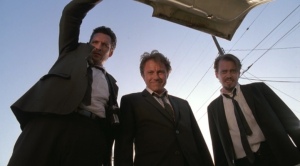
The camerawork in Reservoir Dogs was fresh and exciting. The steadicam following these dogs out of the building–the music fading behind them–was a technique I’d not noticed before watching this movie.
It wouldn’t be until years later that I would realize that through this structure Tarantino had revolutionized cinematic storytelling. Flashbacks were nothing new, but his copious use to unfold a story was uncommon and felt fresh. Today Reservoir Dogs has been copied endlessly — its structure was the template for every episode of Lost, plus hundreds more. Now I consider the flashback story a gimmick. Even Tarantino’s follow-up film Pulp Fiction continued this use, though, while the timeline of that latter film is not chronological, it is also not as scattered as this earlier work.
Watching this film I didn’t realize I was seeing a new storytelling structure that would permeate the mainstream. Through expert editing and story structure I was just drawn into Reservoir Dogs, without excess attention paid to the narrative. The dialogue, the characters, the mystery, it all had me.
Despite being a movie featuring murderous thieves, Tarantino found a way to make them likable characters. The opening scene in the diner, which helped establish a pecking order and general relationships, was a large part of that.
The flashback scenes also built upon this, showing a sense of family among many of the characters and their boss, Joe Cabot. Mr. Blonde (Michael Madsen, in his finest performance to date) is fresh out of prison having refused to rat on his employer. Still on parole, Blonde is afraid of going back. Joe, and his son “Nice Guy Eddie” (Chris Penn) set Blonde up with a fake job and a sense of security, before they do the job.
Likewise Mr. White (Harvey Keitel) is a longtime associate of Joe’s and flashbacks firmly establish their friendship and camaraderie.
The linchpin of the film, however, is Mr. Orange (Tim Roth). He gets the most flashback scenes, and here we get to connect with him outside of the crime family. Tarantino gets much praise for dialogue, and it comes through in these moments.
The sense of pop culture Tarantino put into the film is uncanny. Referencing songs of the 80s while bringing in music from the 70s, Reservoir Dogs clicked with a multitude of audiences. Yet, in a decade before Marvel films were popular, Tarantino referenced Fantastic Four as well — letting this teenage comic fan know a kindred spirit was behind the camera.
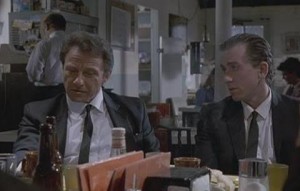
You give me a bad review in a dream you better wake up and apologize.
I also loved the way the soundtrack compiled these songs but, in between, included dialogue from the film. It was rare in 1992 to include anything other than music on a soundtrack. After Reservoir Dogs it became expected, until it — like flashback storytelling — became a tiresome and overused gimmick. With Reservoir Dogs, and then Pulp Fiction, Tarantino’s albums remain my gold standard for this trick.
Beyond all of that came my personal favorite character, the weasely, greedy Mr. Pink (Steve Buscemi). His instinctive sense of self-preservation plus his sardonic sense of humor was all established in his very first scene–he doesn’t tip waitresses. He cares more about his own finances than having compassion for the waitress, and tells this in a highly amusing way. Pink was always my favorite of the Dogs, and for years I thought he, the least trustworthy of all the criminals on screen, was the only survivor. Not only that, it seemed he got away with the diamonds! It wasn’t until 1996 when I saw a limited-run theatrical rerelease that I heard the audio and Pink ended up like the rest of the gang–shot to death.
I can continue to heap praise on this film, and over its 22 year history many have. Yet much of what I appreciated came in retrospect. Watching this film the first time, I was just taken in, and perhaps a bit shocked. Reservoir Dogs is bloody, foul-mouthed, and raw. The casual amorality that Mr. Blonde exhibits when he pulls his captive police officer from the trunk, where the cop had been stored for quite some time, brings the blackest of humor. It is a moment beaten only moments later by Blonde’s torture of the man, set to the jaunty Stealers Wheel’s song “Stuck in the Middle With You.”
This film was my intro to Tarantino, and I was instantly a fan. True Romance solidified that. The next year my dorm room was a practical shrine to the director, with giant Mr. Blonde and Mr. White posters dominating my walls. These films entered heavy rotation, and greatly influenced my creative view. I started tooling with my own crime stories that, at the time, I considered original. Now I realize they were blatant Tarantino rip-offs.
Through my love of Reservoir Dogs I also discovered new directors who followed Tarantino’s path and broke into Hollywood with gritty, genre-bending crime films. From Bryan Singer with The Usual Suspects to Guy Ritchie with Lock, Stock, and Two Smoking Barrels, and even Reservoir Dogs co-writer Roger Avary’s directorial debut Killing Zoe.
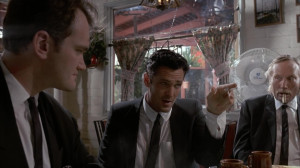
Tarantino pulled off the minor role of Mr. Brown, but he was not as fortunate in future acting gigs.
(I also followed Tarantino’s “acting” career to films like Sleep With Me and Destiny Turns On the Radio. Don’t make the same mistake I did. Never, ever watch Destiny Turns On the Radio)
Tarantino opened the door for indie filmmakers to be taken seriously in the 90s. He also shifted my focus for the rest of the decade, causing me to seek out small films as well as blockbusters, and to sample new directors as well as return to those I already enjoyed.
In the two decades since Reservoir Dogs Tarantino has gone on to win multiple academy awards and put together a very respectable resume of films. There is no doubt the man is a talented director, and an even better wordsmith. Still, to me, his earliest work remains his finest. Even Pulp Fiction, his directorial follow-up to Dogs, became more complex and bloated.
Here, with only the bare essentials and a meager budget, he created a work of genius, and an inspiration to aspiring writers and filmmakers across the country. Including me.
Tomorrow — 1993!
Arnie is a movie critic for Now Playing Podcast, a book reviewer for the Books & Nachos podcast, and co-host of the collecting podcasts Star Wars Action News and Marvelicious Toys. You can follow him on Twitter @thearniec
August 22, 2014 Posted by Arnie C | 40-Year-Old Critic, Movies, Now Playing Podcast, Podcasts, Reviews | 40-Year-Old Critic, Enertainment, Film, Harvey Keitel, Indie, Michael Madsen, Mirimax, Movie, Movies, Now Playing, Now Playing Podcast, Podcasts, Quentin Tarantino, Reservoir Dogs, Review, Reviews, Steve Buscemi, Tarantino, Tim Roth | 3 Comments
40 Year-Old-Critic: The Doors (1991)
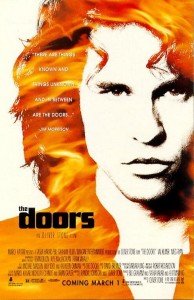 In The 40-Year-Old Critic, Venganza Media creator and host Arnie Carvalho recalls a memorable film for each year of his life. This series appears daily on the Venganza Media Gazette.
In The 40-Year-Old Critic, Venganza Media creator and host Arnie Carvalho recalls a memorable film for each year of his life. This series appears daily on the Venganza Media Gazette.
The critic awoke before dawn. He put his boots on. He chose a film from the ancient gallery and he walked on down the hall…
Believe it or not, I love the concept of film biographies, or biopics as they’re sometimes called. The world is full of colorful people with stories more strange and interesting than any fiction a Hollywood scribe can concoct. To learn a bit about a popular or historical figure, while also hopefully being entertained, seems like a win-win.
I realize this may be a shock to those who have heard my comments on the Now Playing Podcast review of The Aviator where I heaped my disdain on the overwrought, self-important Martin Scorsese-directed Howard Hughes biopic.
Therein lies the dichotomy: while I like the idea of a biopic, the execution is often lacking. A life cannot be compressed into a single film, so shortcuts are made to improve the narrative; and often the films come with this feeling that the director was saddled with the burden of making something to honor the subject.
Still, while they are the exception and not the rule, there are some biopics I completely love. Examples include: The Social Network’s profile of Facebook founder Mark Zuckerberg, Fire in Silicon Valley (the TNT TV movie about the rise of Microsoft and Apple), and Dragon: The Bruce Lee Story, which feels like a martial arts film while profiling the star of that genre.
Of all of those, though, no biopic has had the impact on me that came with Oliver Stone’s The Doors.
It was by chance that I saw The Doors. My interest in a biography film is directly proportional to my interest in the subject. I don’t care about Peter Pan author J.M. Barrie, so I didn’t see Finding Neverland; I’m not a fan of Liberace so I didn’t seek out Behind the Candelabra.
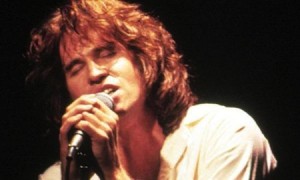
From movement to posture to body shape, Kilmer became Morrison for The Doors.
In my teen years, not only wasn’t I a fan of The Doors, I barely knew them. I was more familiar with the Echo and the Bunnymen cover of People are Strange featured in The Lost Boys than I was any given Doors song.
Nor was I especially a fan of Stone’s (though this review series may give the opposite impression, as I already profiled Wall Street, and one more Stone film will appear before this series ends). After Wall Street I had seen Born on the Fourth of July and found it interesting, and I actually saw JFK before The Doors due to more interest in the subject. But JFK ended up becoming one of those biopics — like The Aviator — for which I have no tolerance.
I saw The Doors due to utter boredom. I was home from college for a weekend with no plans, so, as I was wont to do, I went to the video store with no agenda. A Saturday night, the new releases gone, I eventually came upon this film’s VHS box and saw Val Kilmer staring out at me, his hair and shirt aflame.
Kilmer was an actor I’d greatly enjoyed. Real Genius remains, to this day, one of my favorite 80s comedies, in large part due to the actor’s fun, yet emotional role as young laser scientist Chris Knight. In addition, Kilmer had given strong performances in Top Gun, Top Secret!, and Willow. I wanted to see what the actor could do if given a more serious role, and I had read nothing but praise for his portrayal of singer Jim Morrison.
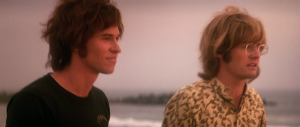
I mostly knew co-star Kyle MacLachlan from Twin Peaks when I first saw The Doors. His character of Ray Manzarek, Doors’ keyboardist, is lost in this film; despite the title this movie is all about Morrison.
I took the videocassette home, with no clue what to expect. I knew nothing of Morrison’s life or his band. I certainly didn’t expect to see visions of Native American spirit guides, trippy sexual satanic rituals, and Morrison receiving oral sex in the recording studio while singing. While there were silent parts, it felt like Morrison’s life was completely scored to his own music — and it fit perfectly.
I had never done acid or eaten hallucinogenic mushrooms, but after watching The Doors I felt as if I had done both. Even on my small television I lost myself in this story. The editing, the score, the dreamlike quality that inhabits almost every frame, made me feel I had experienced the film, not watched it. The Doors took their name from Aldous Huxley’s book The Doors of Perception, and I felt mine had been opened through this biopic.
I ejected the tape feeling as if I had communed with Morrison, as he had on screen with the Native American.
Much of the credit for that must be given to Kilmer. Everything I had read, all the accolades heaped upon the actor, did not begin to do justice to this transformative performance. Despite watching the movie for him, by twenty minutes into the film I recognized that the actor had become lost to the role.
Part of it was a physical transformation — Kilmer losing weight to make himself as wiry as Morrison was in classic photos. More than just adjusting his body mass, though, Kilmer moved with a swagger I’ve not seen him have before or since. When he sang the songs he wasn’t just passable but exceptional. Somehow he captured the mystical authority that was Morrison’s trademark.
On my first watching of The Doors I didn’t realize how accurate Kilmer’s portrayal was; I knew nothing of Morrison and thus had no basis to which I could compare. What I did know, though, was that Kilmer had transcended the performances I had seen before and transformed into someone else for two-and-a-half hours.
Kilmer’s Morrison was sexy, cool, confident, cruel, drunk, stoned… he was magical. He was The Lizard King, he could do anything.
I had never desired to own a Doors record before this movie, but after delighting in this film I became obsessed. The very next day I went to the used music shop (where I was a regular) and bought some Doors CD’s that I listened to hundreds of times.
More, I wanted to find out the rest of Morrison’s story. The film showcased the high points but I needed to know more; about his supposed bastard child, about the satanic rituals he undertook, about his tumultuous relationship with girlfriend Pamela Courson (Meg Ryan, lost in Kilmer’s shadow). This being the pre-Internet era, I had to go to a bookstore, and within a week I had bought Jerry Hopkins and Danny Sugerman’s biography No One Here Gets Out Alive.
This was not a short-term obsession. In the years since I’ve reread that book several times, as well as the autobiographies Riders on the Storm: My Life with Jim Morrison and The Doors by drummer John Densmore and Light My Fire: My Life with The Doors by keyboardist Ray Manzarek, and several other books along the way. I even bought a CD of a strange audio interview Morrison gave in his later years, and have listened to it religiously, looking for more insight into the man who hooked me on screen.
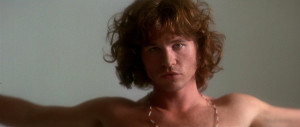
Kilmer perfectly recreates an iconic photo of Morrison.
Through those years of research I came to admire Stone’s work even more. It is impossible to sum up one man’s life in a single film, but Stone had come damn close. Though the surviving Doors disagree, my own readings show that Stone was mostly factual. With any real-life scenario there are different accounts of what happened, and even among the band there are disagreements about what in the film is fiction.
In the end, as with all biographies, some characters were combined or cut out, but it seems that Stone’s film did not indulge in the over-fictionalization and emotional shortcuts that are the hallmark of the genre. Even good biopics, like Dragon, rely on this crutch more than The Doors appears to have.
But beyond facts, Stone created a film that wasn’t about Jim Morrison, it was about being Jim Morrison. You didn’t need to see his every aspect so much as understand his point of view, and that is captured perfectly on film. Despite the seriousness of the subject, and contracts with Courson’s family and the remaining Doors, Stone kept the film light, fun, and trippy. He even avoided his JFK downfall — he never indulged a conspiracy theory over Morrison’s mysterious death in a bathtub. Several books propagate urban legend that Morrison’s death was faked, that Mr. Mojo Risin’ (an anagram of Morrison’s name) was living somewhere in Africa, and some day the world would witness the return of The Lizard King. That is subject material that seems tailor-made for Stone, but he does not follow the impulse. The result is a biopic that works as a movie, and a film that entertains as it educates.
Yes, while I only see most biopics due to an interest in the subject matter, this one was the total opposite — the biography film made me an uber-fan of the subject!
To this day The Doors is a film I watch regularly. It has stood the test of time better than its lead actor or its director. It has become iconic in my own mind, and when I envision Morrison in my head I’m never sure if I’m seeing Kilmer or Jim.
In the end, it doesn’t matter — for in this film they were one in the same.
Tomorrow — 1992!
Arnie is a movie critic for Now Playing Podcast, a book reviewer for the Books & Nachos podcast, and co-host of the collecting podcasts Star Wars Action News and Marvelicious Toys. You can follow him on Twitter @thearniec
August 21, 2014 Posted by Arnie C | 40-Year-Old Critic, Movies, Music, Now Playing Podcast, Podcasts, Reviews | 40-Year-Old Critic, Biography, Biopic, Documentary, Drama, Movie, Movies, Now Playing, Now Playing Podcast, Oliver Stone, Podcasts, Review, Reviews, Rock, The Doors, Val Kilmer | 4 Comments
Corn Connection: Terminator, Living Dead, and Garbage Day!
As Now Playing Podcast embarks on its nine-part Children of the Corn series, listeners are invited to take part in some behind-the-scenes fun; pointing the stars of the franchise toward their places in the Now Playing archives.
Stars? Actually, yes. It turns out, the cornfields are full of familiar faces. Perhaps the word “stars” is stretching it a bit, but there’s no doubt you’ll recognize some of them.
So, what about that 1984 Children of the Corn film? Which actors and actresses went on to further mention on Now Playing Podcast?
Here’s a look:
Linda Hamilton (Vicky) – The Terminator Retrospective Series
There will never be another Sarah Connor (just try it reboots!). Corn was released in theaters about seven months before The Terminator in 1984, and if it weren’t for her iconic role, it’s likely we wouldn’t be talking about Hamilton again unless Now Playing Podcast ever reviews King Kong Lives.
R.G. Armstrong (Diehl) – Predator Retrospective Series
This actor has a career dating back to the 1950s, with more than 180 credits listed on his IMDB page. But to Now Playing Podcast listeners, he’ll always be remembered as Gen. Phillips, the man who sent Arnold Schwarzenegger and his team of commandoes into the jungle, where they ended up facing the Predator.
Why did he pick Arnold? Cause some damn fool accused him of being the best!
John Franklin (Isaac) – Child’s Play Retrospective Series
Listeners will get to know John Franklin very well during the Corn series, as his turn as Isaac will likely be the role that defines his Hollywood career.
But Franklin did make an appearance in another Now Playing series; he did voice work for the first Child’s Play film. Unfortunately, that’s a series currently locked away in the Now Playing vault.
Courtney Gains (Malachai) – Halloween Retrospective Series and Back to the Future Retrospective Series
Gains is one of those 80s actors that you’ll swear you saw in 100 films. You’re probably right some of the time, the rest of the time you’re mistaking him for Stu Charno or Jason Lively.
But Gains has made a couple of appearances in films reviewed by Now Playing Podcast. He’s got an uncredited role in Rob Zombie’s Halloween and also the first Back to the Future film.
The latter will have you scratching your head, but pop in that disc (or tape?) again and take a look. You’ll see Gains in a pivotal scene. Here’s a hint: Earth Angel.
John Philbin (Amos) – The Return of the Living Dead Retrospective Series
Philbin is another actor that you’ll recognize in several roles, most notably as a member of Patrick Swayze’s gang in Point Break.
But he also played a role in The Return of the Living Dead, which is currently locked away in the Now Playing Podcast vault.
Eric Freeman (Israel, uncredited) – Silent Night, Deadly Night Retrospective Series
Wait, Eric Freeman? That Eric Freeman? Garbage Day Eric Freeman??
Yes, one of the most mocked memorable villains in the annals of Now Playing Podcast makes an uncredited appearance in the first Corn film. Sadly, he doesn’t get the chance to speak his most famous two-word line.
But you can enjoy the best/worst that Freeman offers as an actor during Now Playing’s hilarious 2012 holiday series. Enjoy Arnie’s Christmas jingles!
That does it for Children of the Corn. Did we miss anyone? If you spot an actor or actress with a connection to Now Playing Podcast leave a comment and help a fellow listener!
August 20, 2014 Posted by Jason Latham | News, Now Playing Podcast | arnold schwarzenegger, back to the future, child's play, Children of the Corn, courtney gains, eric freeman, garbage day, Halloween, john franklin, john philbin, king kong lives, linda hamilton, Now Playing Podcast, point break, predator, r.g. armstrong, return of the living dead, sarah connor, silent night deadly night, stu charno, terminator | Comments Off on Corn Connection: Terminator, Living Dead, and Garbage Day!
40 Year-Old-Critic: Pump Up The Volume (1990)
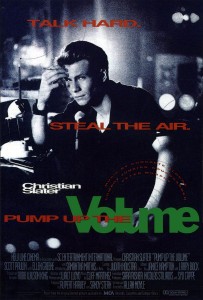 In The 40-Year-Old Critic, Venganza Media creator and host Arnie Carvalho recalls a memorable film for each year of his life. This series appears daily on the Venganza Media Gazette.
In The 40-Year-Old Critic, Venganza Media creator and host Arnie Carvalho recalls a memorable film for each year of his life. This series appears daily on the Venganza Media Gazette.
Okay, down to business. I got my Wild Cherry Diet Pepsi, and I got my Blackjack gum here, and I got that feeling… mmmm… yeah, that familiar feeling, that it’s time to write another movie review.
I think every generation of teenagers has a movie that speaks to them directly. Maybe it’s Rebel Without a Cause or The Breakfast Club or Mean Girls or High School Confidential; there is always a movie that can perfectly capture on screen a snapshot of your fears and concerns, along with the overall attitude of American youth.
For many people my age — the younger members of Generation X — that film is 1990’s Pump Up the Volume, and it is in a large part the reason that I’m writing this entire review series.
The film stars Christian Slater as Mark Hunter, a high school student recently transplanted from New York to Arizona. At school he is an introverted kid who stumbles over his words and mumbles when called on in class. But by night Mark rocks out as Happy Harry Hard-On, a pirate radio DJ — his name stolen from the initials of the Hubert H. Humphrey High School he attends.
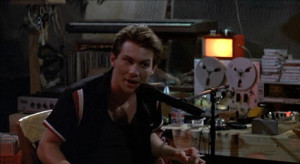
This looks like my studio. Only I have more toys, less records, and no reel-to-reel tape…but that would add atmosphere.
The show becomes a cult phenomenon at the school, with kids gathering nightly to listen in the remote locales that afford the best reception for Hard Harry’s low-powered FM transmission. Their communal experience stretches across class lines and cliques; and while Harry is simulating masturbation and playing banned Beastie Boys songs, he’s unaware that kids are looking up to him. As the audience grows Harry becomes an over-the-air Dear Abby for these pimple-popping pubescents. Unfortunately, one teen reaches out to Harry for help, and, when not satisfied with the response, commits suicide.
This leads to a contrived plot involving police and the FCC tracking down Mark on charges of criminal mischief. The film takes some Goonies-like kids-know-more-than-adults turns that stretch suspension of disbelief, and the last 30 minutes kind of fall flat as Mark tries to outsmart his pursuers. But the first hour truly succeeds in capturing the feeling of teen angst and insecurity shared by many high school students.
I know this film spoke to me in 1990. Like Mark, I had just moved to a new city, changing high schools in my junior year. That was my second move in three years, and I would live in five different cities over the span of four years. I always managed to make a small group of friends, but I understood Mark’s frustration. Also, like Mark, I avoided much of the situation by throwing myself into entertainment, be it books or films.
Each time I moved and lost contact with friends I’d have more free time to fill. Mark might as well have been speaking for me when he said, “I just arrived in this stupid suburb. I have no friends, no money, no car, no license. And even if I did have a license all I can do is drive out to some stupid mall, maybe if I’m lucky play some fucking video games, smoke a joint and get stupid. You see, there’s nothing to do anymore. Everything decent’s been done. All the great themes have been used up, turned into theme parks. So I don’t really find it exactly cheerful to be living in the middle of a totally exhausted decade where there’s nothing to look forward to and no one to look up to.”
Mark provided verbalization of my first post-modern early-life crisis.
My connection to this character was strengthened by Slater’s previous role as angsty, homicidal high school student J.D. in the dark comedy Heathers.
That film introduced me to the actor and his Jack Nicholson-esque delivery, and that’s why I was drawn to Pump Up the Volume. I have to say up front that Heathers is the better of the two films; both smarter and funnier.
In both films Slater’s character is an angry high school loner who seduces a brunette co-star while revealing the social hypocrisies that surround him. In many ways I saw Pump Up the Volume as a softer, less violent imitation of Heathers. I connected to Mark far more than J.D., the latter character’s mad bomber twist taking it a step too far.
As Mark, Slater took that angst and destroyed the school with words instead of dynamite. Through his one-man show he brought down a corrupt administration, got the girl, and made dozens of teens feel good about themselves.
It is the last point that gives Pump Up the Volume its power. Students call Harry’s hotline with problems so varied that everyone can find something to which they can relate. One pretty blonde girl is tired of pretending to be perfect. A gay teen is frustrated at the bullying he suffers. Another girl is kicked out of school after finding out she’s pregnant.
Gay or straight, male or female, fat or thin, Harry has self-affirming words of wisdom for you: “Feeling screwed up at a screwed up time in a screwed up place does not mean you are screwed up.”
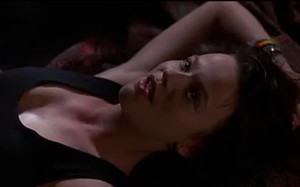
All my listeners have this look of orgasmic rapture on their faces when listening to my podcasts, right? No??
Don’t destroy my fantasy!
In that way Harry becomes a horny radio version of Robin Williams’ John Keating from Dead Poets Society. He realizes that teenage years bring pain, but he’s wise enough to know it’s temporary and won’t matter in five years. (That Mark espoused this so convincingly while also lamenting his own station in life is a dichotomy the script never cares to rectify.)
Mark lives a Superman-like lifestyle. He is a geek by day, and even wears glasses to hide his identity. By night he takes the glasses off and is a microphone superhero. To the teens in his audience, and this teen watching the film, he was an inspiration.
I mentioned in my review of Wall Street that, after seeing that movie, I had no career ambition. Turning 16 years old but having no concept of career goals was frightening. Soon I would have to pick a college, a major, a career, and I had nothing. Yet Happy Harry Hard-On sparked something inside me. He made me realize the true power of words, and how few things are more insidious than a whisper in your ear; few things more important than entertainment that can lift your spirits after a terrible day. Pump Up the Volume made me want to be an entertainer, and, while I would experiment with several avenues, that goal of bringing light to peoples’ day never changed.
In fact, I took a fairly direct path from Pump Up the Volume. Three years after seeing this movie I became a DJ at my college radio station. I never found corruption in the school administration, but I did smoke my share of cigarettes while lamenting into a microphone and wondering if anyone was out there listening. I do know I remotely deejayed a number of parties on and off campus.
And I played more than my share of Leonard Cohen songs. I also must credit Pump Up the Volume for broadening my musical tastes. Cohen’s song “Everybody Knows” launched Harry’s every broadcast and its cynical lyrics resonated with me:
Everybody knows that the war is over
Everybody knows the good guys lost
Everybody knows the fight was fixed
The poor stay poor, the rich get rich
That’s how it goes
Everybody knows
Cohen’s sonorous voice sounded like a funeral march, and this became my anthem. I bought the Pump Up the Volume soundtrack immediately. Though I was disappointed that Cohen’s version of “Everybody Knows” was absent, replaced by Concrete Blonde’s cover, that CD introduced me to the Pixies and Henry Rollins, along with Soundgarden and Sonic Youth years before they broke into the mainstream.
I finally rediscovered Cohen a few years later, but that will be discussed in time.
I still live with Pump Up the Volume as an influence on my life, though as an adult I find few of the characters relatable; my own teenage angst and awkwardness are now, fortunately, long buried in the past. Yet, as I mention this film — which I long considered an obscurity — to people around my age I find we, like Harry’s on-screen audience, had a shared communal experience. Pump Up the Volume became a film that, despite its faults, resonated with us.
Rewatching this film to prepare for this review I found myself connecting with Hard Harry in a new way. When he finally tells the story of how he got started with his pirate radio, it was a familiar one. He started broadcasting thinking no one, or perhaps one special person, was listening. Slowly he realized his show was picking up steam. It was an incredible dream, and one I think nearly every podcaster shares.
Every podcast begins the same way: someone picks up a microphone and starts talking with no clue if anyone will listen. Some shows may have better odds than others, being featured on other podcast feeds and the like, but I know when I recorded my first episode of Star Wars Action News I wondered if anyone would ever hear it. That it got 50 downloads in the first week floored me, that was a number far greater than I’d ever dreamed. I continued to record, and people continued to listen. Like Harry experienced in this movie, my audience grew.
Podcasting is the new pirate radio, and we operate outside the purview of the FCC. And as Harry does at the end of the film I urge each of you to, “seize the air. Steal it! It belongs to you! Speak out! They can’t stop you. Find your voice and use it! Keep this going! Pick a name, go on air. It’s your life, take charge of it. Do it, try it, try anything. Spill your guts out, say shit and fuck a million times if you want to, but you decide. Just fill the air! Steal it! Keep the air alive!”
Until tomorrow’s entry, talk hard!
Tomorrow: 1991
Arnie is a movie critic for Now Playing Podcast, a book reviewer for the Books & Nachos podcast, and co-host of the collecting podcasts Star Wars Action News and Marvelicious Toys. You can follow him on Twitter @thearniec
August 20, 2014 Posted by Arnie C | 40-Year-Old Critic, Movies, Now Playing Podcast, Podcasts, Reviews | 1990s, 40-Year-Old Critic, Christian Slater, Drama, Enertainment, Leonard Cohen, Movie, Movies, Now Playing, Now Playing Podcast, Podcasts, Pump Up the Volume, Review, Reviews, Samantha Mathis | 1 Comment
Make the ‘Corn Connection’ with ‘Now Playing Podcast’
Let’s be honest. None of us really expect to see row after row of green arrows once the Now Playing Podcast hosts emerge from their nine-part Children of the Corn Retrospective Series.
If it weren’t for their commitment to reviewing every movie spawned by the works of Stephen King, we wouldn’t, for example, be circling Sept. 23 on the calendar for the release of Children of the Corn 666: Isaac’s Revenge.
But Arnie, Stuart and Jakob are taking the plunge, and so we will join them on this epic binge of bad sequels. Only this time, we’re going to have some fun with it.
With our hosts seated in front of their microphones, those of us behind the scenes will be playing Six Degrees of Now Playing.
It’s The Corn Connection.
Every week we’ll run down the list of players from each of the nine Corn films, and direct an arrow toward their place in the Now Playing Podcast archives.
When you IMDB the casts of Hollywood horror franchises, you’ll often see familiar faces. Some are names that will soon become household (see Hellraiser: Hellworld), and some once were (Isaac’s Revenge).
So come back to the Venganza Media Gazette each week and take a trip around the Now Playing Podcast archives. And if you spot an actor or actress that’s made an appearance in another film reviewed by Now Playing, leave a comment and help a fellow listener discover what they might be missing.
We’ll start Tuesday following the release of 1984’s Children of the Corn over at the Now Playing Podcast website.
August 19, 2014 Posted by Jason Latham | News, Now Playing Podcast, Podcasts | Arnie, Children of the Corn, Hellraiser, Jakob, Night Shift, Now Playing Podcast, six degrees of separation, Stephen King, Stuart, Venganza Media | Comments Off on Make the ‘Corn Connection’ with ‘Now Playing Podcast’
40 Year-Old-Critic: When Harry Met Sally (1989)
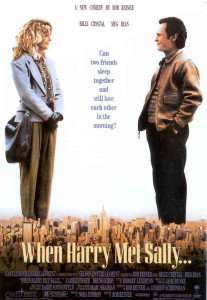
In The 40-Year-Old Critic, Venganza Media creator and host Arnie Carvalho recalls a memorable film for each year of his life. This series appears daily on the Venganza Media Gazette.
On Now Playing Podcast my co-hosts Stuart and Jakob often joke about my affinity for romantic comedies, or “RomComs.” I don’t mind the jokes. After all, it does seem that I tend to go to this lighthearted genre whenever discussing works of actors and filmmakers.
A History of Violence star Maria Bello? First saw her in Coyote Ugly and loved her in The Cooler.
I researched the work of The Wolverine director James Mangold by watching the atrocious Kate & Leopold.
Even mo-cap pioneer Andy Serkis — we actually see his face in 13 Going on 30.
The list goes on and on. I never analyzed my proclivity for these films, but the repeated jesting had me reflect a bit on why I spent time watching them in the first place. It quickly became clear that I chose to see those movies and more because of When Harry Met Sally.
When Harry Met Sally was released in the summer of 1989, which, at that point, might have been the biggest moviegoing summer in Hollywood history. Films like Star Trek V, Indiana Jones and the Last Crusade, Batman, Ghostbusters II, and Back to the Future Part II were all unleashed within weeks of each other.
With these blockbuster heavy-hitters on the calendar, Rob Reiner’s romantic comedy was not the No. 1 film on my “must see” list, but it was up there.
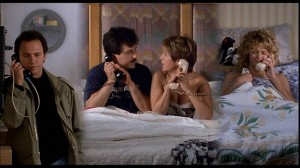
Crystal, Kirby, Fisher, and Ryan engage in 4-way split-screen action.
Part of the draw was the talent involved. I had liked Meg Ryan in Innerspace, and, although I was too young to appreciate the genius of Soap, Billy Crystal had really impressed me with Throw Momma from the Train.
But the biggest draw was Reiner. While I grew up watching “Meathead” on All in the Family, I’d already come to respect him as a director after seeing Stand by Me, The Princess Bride, and even the John Cusack comedy The Sure Thing.
Also, if I’m going to be completely honest, there was another big draw: Sex.
I was in my early teens and dating was a frustrating, confusing experience. I was also learning about sex through government-mandated public school health class as well as… extracurricular materials. As a boy desperately wanting to gain insight into the female brain, this film seemed like a wealth of knowledge.
The trailers teased wise phrases such as “Men and women can’t be friends, the sex part always gets in the way.” Was that true? It boggled my adolescent mind to ponder.
And there was the clip of Meg Ryan performing Sally’s fake orgasm in Katz’s Delicatessen. Yeah, I really wanted to know more about that!
Getting into the theater was a tricky proposition for someone three years shy of the 17-year-old threshold for R-rated films. I eventually convinced my prudish 21-year-old sister Michelle and her husband to take me.
I know that at 13 I didn’t get all the jokes or understand the subtle nature of some of the humor (I also totally didn’t recognize “Princess Leia” Carrie Fisher as Sally’s best friend Marie). Still, I was taken by this film and its world.
Crystal was funny and salacious as Harry. I was won over by this libidinous lothario early on, during the car ride when Harry propositions Sally despite the fact that he’s dating her best friend. Crystal’s timing is spot-on. In the hands of another actor this type of introduction could have alienated the audience, but Crystal’s light hearted delivery, his sparkling eyes, and his disarming smile made Harry the type of character men could root for and women could come to love.
As Sally, Ryan gave the performance of her life. I developed a major crush on Sally and, due to this, I saw most of Ryan’s work. The success of this film made her a hot property, but from Flesh and Bone to I.Q. to The Doors, no performance she has ever given comes close to matching the one she gives here.
I believe part of this is because of the way Ryan threw herself into the role, right down to the deli orgasm scene. While some actresses may have shied away from such an extreme moment, this scene was actually Ryan’s idea. With physical comedy, self-effacing stumbles, and great delivery, she gave her all to When Harry Met Sally.
More, I think her co-stars, primarily Crystal and Bruno Kirby, were so amazing that Ryan’s game was elevated.
Thanks to the performances from the two leads and a script by Nora Ephron, Reiner created the perfect romantic comedy; one that appeals equally to men and women. The movie delicately balanced the two points-of-view and at no point while watching When Harry Met Sally did I feel I was watching a “chick flick.” To me it was just a comedy film.
Not only did this film make me fall in love with Sally; I fell in love with New York City. This was the first time I’d seen New York truly romanticized on screen. Sure, Ghostbusters, Splash, and Short Circuit 2 were among the many movies set in the Big Apple, but this film truly drove home to me the differences between New York and other cities where I’d spent considerable time, such as Chicago or Fort Myers, Florida. The use of cabs for transportation, the unlikely experience of running into old acquaintances in a city with 8 million residents, the difficulty of taking home a Christmas tree in a town that relies on public transportation — I saw it all for the first time in When Harry Met Sally. This was the first movie that I realized to be as much about a place as the people.
Reiner deserves so much praise for the way he structured the film; using holidays to show the passing of time, the split-screens during the four-way phone call, the rapid-fire quips — honestly, I could gush about this film for pages. It is one of those movies that just came together and made on-screen magic.
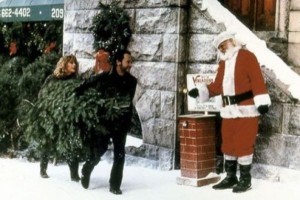
When Harry Met Sally is the perfect movie to watch between Christmas and New Year’s–a perennial holiday favorite.
This was my first foray into truly adult comedy, as compared to the Eddie Murphy comedy that just used adult language. When Harry Met Sally has adults dealing with issues of age, marriage, and commitment; and doing so in a funny way.
I left the theater still pondering the question of whether men and women can be friends; but I was certain that, through Sally, I’d gotten a glimpse into the workings of the fairer gender. I certainly didn’t know all I needed to know, but I felt that I’d been educated (through the film’s female perspective) as well as entertained (by the film’s male point of view).
I wanted to know more, and I wanted to laugh as hard as I did in that theater. Because When Harry Met Sally was such a success, the comedies of the 1990s and 2000s kept copying Reiner’s formula, and I watched dozens of them hoping to feel the same as I did in 1989.
I followed Ryan to French Kiss, Sleepless in Seattle, Addicted to Love, and many more hoping to see, but never finding, the magic she possessed as Sally. Only You’ve Got Mail came close.
I also followed Billy Crystal to the forgettable Forget Paris, but enjoyed his comedy more in City Slickers and Analyze This.
When neither Crystal nor Ryan repeated their success I tried to find this type of on-screen chemistry with other known actors. From Sandra Bullock and Bill Pullman in While You Were Sleeping, to Nicholas Cage and Bridget Fonda in It Could Happen to You, to several Friends stars in films best forgotten, I watched them all.
Most of them were terrible.
Not only did these movies lack the insight and wit of When Harry Met Sally, the genre itself slowly degenerated before my eyes. Initially the films would try to replicate Reiner’s delicate balance of romance and comedy, but in time they changed to focus far more on the romance, less on the comedy, becoming base female wish fulfillment. By the mid-90s the vast majority were, indeed, the “chick flick RomComs” that Jakob taunts me for watching. There were a few gems in the bunch, such as The Wedding Singer, There’s Something About Mary, Bridget Jones’ Diary and The 40-Year-Old Virgin, but, by and large, they were junk that left me bored.
But if I was not entertained, was I educated? Did this deep dive into the world of female-targeted cinema give me insights into women? Well, in the past 25 years I’ve learned a lot, and mostly it’s that everyone is a unique individual. My quest to learn some magic secret about “all women” was doomed to fail because each woman is her own person. I learned that not through film, but through dating and, eventually, marriage.
I also learned the answer to Reiner and Ephron’s main question — yes, men and women can be friends. The best marriages are those where the two are friends. I feel lucky to have that where my best friend is my wife.
So maybe When Harry Met Sally taught me something after all.
Tomorrow: 1990!
Arnie is a movie critic for Now Playing Podcast, a book reviewer for the Books & Nachos podcast, and co-host of the collecting podcasts Star Wars Action News and Marvelicious Toys. You can follow him on Twitter @thearniec
August 19, 2014 Posted by Arnie C | 40-Year-Old Critic, Movies, Now Playing Podcast, Podcasts, Reviews | 1980s, 40-Year-Old Critic, Billy Crystal, Bruno Kirby, Carrie Fisher, Comedy, Meg Ryan, Movie, Movies, Now Playing, Now Playing Podcast, Orgasm, Podcasts, Review, Reviews, Rob Reiner, Romance, Romantic Comedy, Romcom, When Harry Met Sally | Comments Off on 40 Year-Old-Critic: When Harry Met Sally (1989)
Children of the Corn (1984)
More than 20 films have been adapted from short stories in Stephen King’s 1978 collection Night Shift, but almost half of those films are based on one tale: “Children of the Corn.” The story tells of a group of crazed religious children who sacrificed all the adults in service of their god–He Who Walks Behind the Rows. Now Arnie, Stuart, and Jakob start to harvest these films with a review of the 1984 original. Was this original film revolutionary, demanding 8 follow-up films? Listen and find out!
Arnie C: http://traffic.libsyn.com/nowplayingpodcast/NPPCOTC01.mp3
August 18, 2014 Posted by arniec | Movies, Now Playing Podcast, Podcasts, Reviews | Enertainment, Film, Movies, Now Playing Podcast, Podcasts, Reviews | Comments Off on Children of the Corn (1984)
40 Year-Old-Critic: Hellbound – Hellraiser II (1988)
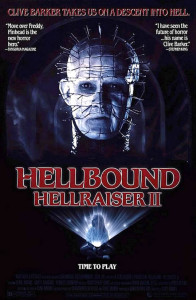 In The 40-Year-Old Critic, Venganza Media creator and host Arnie Carvalho recalls a memorable film for each year of his life. This series appears daily on the Venganza Media Gazette.
In The 40-Year-Old Critic, Venganza Media creator and host Arnie Carvalho recalls a memorable film for each year of his life. This series appears daily on the Venganza Media Gazette.
When I was young I was scared of horror. Not horror films, mind you, but the actual concept of horror petrified me. I mentioned in my earlier article discussing 1979’s Love at First Bite that even watching Dracula on television required an adult be home to protect me.
Yet, I was curious… I wanted to see it while I was frightened of what I might find.
The best analogy I can use for my view of horror is, indeed, the Lament Configuration puzzle box featured in the Hellraiser movies. I was a voyager seeking forbidden knowledge, but once the box was opened the pleasures, and terrors, inside would forever be unleashed. If I watched a horror film the hooks would be in my flesh, and what I would see were images relegated to the domain of nightmare.
I wanted to go there, but I took tentative steps over several years. As a very young child I stuck mostly to the safe horrors of Scooby-Doo ghosts and the seemingly supernatural mysteries in The Three Investigators young adult novels. At age 7 I tried to stretch my own limits by leaving the safety nets of kiddie fare behind and attempting to endure adult horror.
I saw The Shining on television in the early 1980s and was petrified by the decaying woman in the bathtub. I watched Frank Langella in Dracula around the same time. I would see ads for horror films like Return of the Living Dead, Friday the 13th, and Psycho III, read the reviews, and talk endlessly about them with classmates.
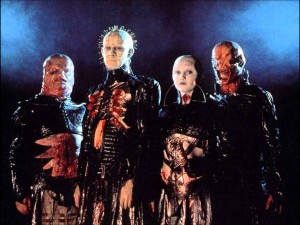
Like the cenobites I too wanted to explore the further regions of horror.
Finally, when I was 8 years old, I tried to face horror. I came home from school one day to find our hosted teenage exchange students were watching Friday the 13th on the VCR. My afterschool ritual was to watch a movie, often Star Wars or Grease, but these Brazilians had monopolized the machine. I was not going to change my routine, so if I could not pick the movie then I would just watch theirs. Not five minutes passed before I saw Mrs. Voorhees decapitated and I fled the room.
That image haunted me for years.
But as I grew into adolescence I wanted to stretch my boundaries further, and I did, starting with horror novels. I found the page safer than the screen, as the written word was always limited by the boundaries of my own imagination. I went further at age 12 and had my first horror movie marathon with the A Nightmare on Elm Street 1 and 2. While I did have a few nightmares of my own I loved every minute of it. I immediately started to consume all the horror I could, reading Fangoria magazine and watching more Stephen King films, the Friday the 13th series, Child’s Play, The Lost Boys, and more.
Within a year I was still captivated, but also starting to bore of the same routine. The vast majority of horror films I watched were slashers, each starring a new group of stereotypical teen characters taken to the slaughter. I had entered the realm of horror to stretch my boundaries, but I just found the same stories again and again. I had faced those fears and I wanted more. I wanted to be tested anew.
Then came Hellbound: Hellraiser II. I had known about the original Hellraiser from the ads. Stephen King’s words were put on the movie screen in a giant font: “I have seen the future of horror and his name is Clive Barker.” Trailers for the first Hellraiser raised my curiosity but the film never came to my town. In 1988, before I’d even had a chance to see Hellraiser on video, its sequel Hellbound came to theaters. The monstrous-looking Cenobites graced the poster. In the movie these creatures described themselves as, “Explorers in the further regions of experience. Demons to some, angels to others.” They were just what I wanted.
Being only 13, I couldn’t find any adult foolish enough to take me to see Hellbound. My parents were lax and would buy me tickets to A Nightmare on Elm Street films, but something about the Hellraiser series made them nervous. I had to wait for video, but the day Hellbound hit VHS I rented it and its predecessor.
I don’t know what I expected the movie to be, but my memory was of fevered excitement. I was going to see something forbidden; I expected something akin to a snuff film. I expected to be changed.
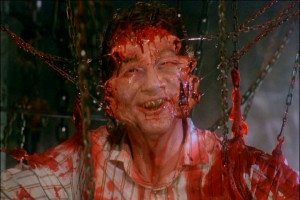
I wanted extreme…I got it. This was one of the first frames I saw of Hellraiser.
By complete accident I put Hellbound in the VCR first and it opened with a montage of the goriest, scariest scenes from the first film. I saw Larry (Andrew Robinson), his flesh stretched by hooks on chains. His distended face leaked more than just blood, and he slurred a blasphemous “Jesus… wept” before exploding into chunks of flesh.
Just these opening frames of Hellbound were an orgy of death and carnage. I was scared. I was nauseated. I was excited. I couldn’t bear to watch, yet I couldn’t turn away.
I had found exactly what I wanted in that damned puzzle box.
Eventually the opening credits started and I hit “stop” so I could watch the films in the correct order. I realized that this was not a Faces of Death-type snuff film but rather a mostly conventional horror film with a crazy woman seducing men and then killing them. Still, I had found a horror more pure, and more imaginative, than even Freddy. Pinhead and his varied demonic cohorts were immortal evil incarnate.
The first film had the better gore, but the second expanded the world further. In Hellbound we got to see the creation of a cenobite and travel to their labyrinthine realm; all taking place in an insane asylum — the heart of madness.
Yet the entire mad experience was accompanied by an amazing orchestral score by Christopher Young. From the disarming lullaby that played when the box was opened to the crescendos that sound like the soundtrack for the end of days, Young’s score stuck with me every bit as much as the latex work. I was no fan of Young’s given his “whale song” music for A Nightmare on Elm Street 2: Freddy’s Revenge but he redeemed by Hellraiser. I’ve still not heard a score he’s done better.
In the years since seeing Hellbound I have encountered many horror fans who claim the original Hellraiser is the only one worth watching. I disagree. Perhaps it was because I experienced them as a double-feature, prompted by the marketing for Hellbound, but I see the first two Hellraiser films as parts of a whole.

The matte work may not be cutting edge but Hellbound expanded the mythology of the Hellraiser franchise.
Yes, the first movie had a more visceral feel, but it also had long scenes of Kirsty Cotton (Ashley Lawrence) walking the streets of London. The sequel truly fulfilled Kirsty’s character arc and allowed her to escape the madness forever, or at least until the direct-to-video Hellraiser VI.
After seeing Hellraiser and Hellbound I felt I had gone to the limits of horror. I tried to explore further by reading Clive Barker’s books and seeing his follow-up films Nightbreed and Lord of Illusions. They couldn’t live up to the horrors of Hellraiser.
Repeatedly I’ve felt that Barker is the man who comes closest to taking the terror of nightmares and putting it on the page or screen, but he always falls just short.
For more than a decade the Hellraiser duology would be my bar for terror and horror, and they are both films I appreciate to this day.
I continue to try and find new boundaries to push in every aspect of life. I find contentment to be equal to death and I want to be pushed further. In the 25 years since first seeing Hellbound I’ve discovered films that grossed me out more (Human Centipede comes to mind), but none that felt as forbidden as the first two Hellraiser films.
I will continue to find the next cinematic puzzle box, and when I find it I’ll open it without hesitation.
Tomorrow: 1989!
Arnie is a movie critic for Now Playing Podcast, a book reviewer for the Books & Nachos podcast, and co-host of the collecting podcasts Star Wars Action News and Marvelicious Toys. You can follow him on Twitter @thearniec
August 18, 2014 Posted by Arnie C | 40-Year-Old Critic, Movies, Now Playing Podcast, Podcasts, Reviews | 1980s, 40-Year-Old Critic, Barker, Books, Books & Nachos, Cenobite, Clive, Clive Barker, Enertainment, Film, Hellbound, Hellraiser, horror, Movie, Movies, Now Playing, Now Playing Podcast, Pinhead, Podcasts, Review, Reviews, Sequel | 1 Comment
40 Year-Old-Critic: Wall Street (1987)
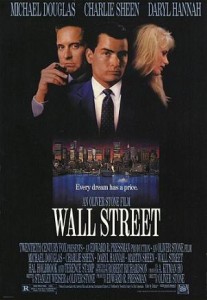
In The 40-Year-Old Critic, Venganza Media creator and host Arnie Carvalho recalls a memorable film for each year of his life. This series appears daily on the Venganza Media Gazette.
Growing up I wanted to be a stockbroker. Other kids said they wanted to be astronauts, movie stars, or firemen; I said stockbroker. In my preteen years I upgraded that to investment banker.
Why wouldn’t I want to go into that world? I grew up in the big 80s, the era of Reaganomics. Money was being flashed everywhere, and it wasn’t just the musicians and actors who had rich and famous lifestyles; there were also names like Ivan Boesky, Carl Icahn, Jordan Belfort, and Donald Trump.
My godfather, who rode the stock market to a healthy retirement, told me that the brokers had the best gig — no matter if their clients won or lost, the broker got the commission.
What did I really want to be when I grew up? I wanted to be rich. I saw the stock market as the avenue to that lifestyle. When I turned 13 I even became a stock owner, my godfather buying me some shares of Ohio-Edison.
That dream crashed in 1987, starting with Black Monday, when the Dow Jones Industrial Average dropped 508 points (which would still make headlines today, but back then it was almost 25 percent of the Dow’s value). I heard stories of broker suicides and rich people in ruin. My faith in the avarice of the economy was shaken.
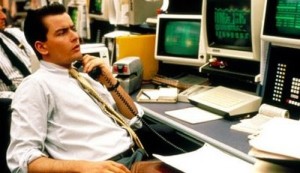
As a child this wasn’t how I envisioned the job of a stock broker.
It was broken entirely two months later when I saw Oliver Stone’s Wall Street. I had looked forward to that film for months. I didn’t know much about Stone (I hadn’t yet seen Platoon), but I knew his name and his Oscar-winning reputation.
Had I researched the man further I would have known that Wall Street wasn’t going to be what I expected, which was a more realistic version of The Secret of My Success.
Instead I saw a film to which I could relate a bit too well. Charlie Sheen played Bud Fox, an up-and-coming broker barely making ends meet. The early scenes that give you a glimpse into the life of the average, front-line broker did not depict the glamorous lifestyle I’d seen on television — it actually looked like Bud might have earned less than a talented bartender.
The high-pressure nature of the business and the cold-call sales techniques combined to make Bud hungry and bitter. Even as a kid I could relate to him; his drive to get out of the phone pool and make a name for himself.
But then we were introduced to Michael Douglas as Gordon Gekko. I had seen Douglas a few months earlier in Fatal Attraction and thought of him as a good guy. In Wall Street he’s a ruthless, wealthy businessman, but I envisioned him almost as a guardian angel that would show Bud the road to riches.
Instead Gekko turned out to be a greedy, deceitful, vengeful criminal. He corrupted Bud with promises of women and riches until the young businessman betrayed his own father in service of his mentor.
Bud redeemed himself — he came up with a plot to save his father’s company — and served time for his misdeeds, but as Sheen’s character was taken to prison I found myself finally questioning this lifestyle I had coveted for years.
Stone told the story exactly how it should have been told in 1987; show the flash, the cash, the allure of riches in the big 80s. Then show the cost, including the broken relationships, the drug hangovers, and the realization that Bud’s “friends” (and even his girlfriend) all disappeared when the money was gone.
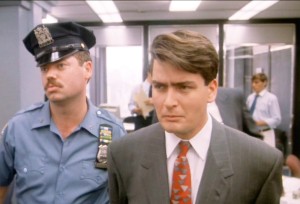
This was the image that struck me hardest from the film. Not the penthouse, not the girl, but the consequences.
This was a movie with a social commentary, and one that should have been made louder and more often in the 80s. The “Greed is Good” mentality prevailed as the economy boomed, but while the success stories got the press, little attention was paid to the illegal and immoral activities undertaken by so many to achieve those ends.
More, the film could not have had a luckier release schedule, if you can ever call Black Monday “lucky.” The stock market was on everyone’s minds and tongues, questioning this ethereal concept of non-liquid assets in a grand trading scheme. Stone’s message rang true, for a period.
I now feel the message of Wall Street has been lost. The stock market is more vital to the lives of Americans than ever thanks to 401(k) plans and other reliances. Despite the crash of the NASDAQ at the turn of the century (when several of my close friends lost everything) and the crash of the Dow in 2007, it seems Americans still like to play the market like a Blackjack table.
More, Gordon Gekko and his “Greed is Good” speech have become lionized by today’s hungry, young businessmen. Even this year’s The Wolf of Wall Street seemed to play up the glamour of Jordan Belfort’s illegally-funded lifestyle rather than focus on the victims he snookered.
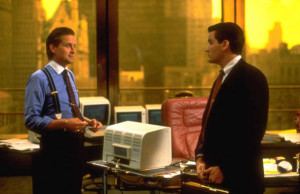
“Please allow me to introduce myself. I’m a man of wealth and taste.”
Had Stone been a different filmmaker and Wall Street a more Wolf-ish tale perhaps my ambitions would have redoubled. I might be a very wealthy man today, or I might be in prison. Fortunately I saw the right movie at the right time. In 1987 and now, Stone’s message rang true. I went in wanting it all, and I left the theater a boy without a goal, perhaps slightly more normal for that.
For that life-changing course — setting me on a path where I would end up helping people by day and entertaining people by night — Stone’s film will always remain a profound symbol of how art can change the direction of your life.
Not all films are pure entertainment, the best ones raise questions as well.
Tomorrow — 1988!
Arnie is a movie critic for Now Playing Podcast, a book reviewer for the Books & Nachos podcast, and co-host of the collecting podcasts Star Wars Action News and Marvelicious Toys. You can follow him on Twitter @thearniec
August 17, 2014 Posted by Arnie C | 40-Year-Old Critic, Movies, Now Playing Podcast, Podcasts, Reviews | 1980s, 1987, 40-Year-Old Critic, Bud Fox, Charlie Sheen, Enertainment, Film, Gordon Gekko, Michael Douglas, Movie, Movies, News, Now Playing, Now Playing Podcast, Oliver Stone, Podcasts, Review, Reviews, Stock Market, Wall Street | 2 Comments
40 Year-Old-Critic: Howard the Duck (1986)

In The 40-Year-Old Critic, Venganza Media creator and host Arnie Carvalho recalls a memorable film for each year of his life. This series appears daily on the Venganza Media Gazette.
In 1986 I was obsessed with, and repulsed by, one film.
It starred a creature not entirely human, nor entirely animal.
The creature wanted to mate with its frizzy-haired, yet attractive, female co-star.
The film also featured a teleportation plot and a once-gentle scientist that slowly transforms into a beast.
That film was David Cronenberg’s remake of The Fly, and even its trailers scared the bejesus out of me. Those trailers ran before nearly every movie I watched. I was 11 years old, but still needed to leave the theater when I’d see The Fly approaching.
I was afraid. I was very afraid.
If I was writing this retrospective before 2011, this article would have focused on that film and how it pushed my adolescent boundaries into new territories.
But now I am going to write about Howard the Duck.
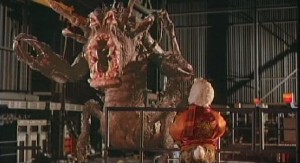
This is what I see in the ink blot…
Or, more accurately, I’m going to write about talking about Howard the Duck. I think I’ve said everything I needed to say about the notorious 1986 bomb three years ago when I reviewed it — alongside co-hosts Stuart and Jakob — for Now Playing Podcast. I discussed seeing the film in theaters, reading the novelization (which I reviewed as well, on the Marvelicious Toys podcast), and even seeing the Dark Overlord in a Rorschach Test. After more than two hours discussing Howard the Duck, what more could I have to say?
Plenty, it turns out. It was a complete accident, but Howard the Duck changed my life.
As I discussed on that show, I’d always had a kitschy fascination with George Lucas’ follow-up to Return of the Jedi. I knew people hated it, but didn’t understand why. It followed the Ghostbusters formula to a T: creatures from another plane come to Earth, wacky scientists try to determine the cause, and hilarity ensues. It even ends with one of the main characters transforming into an evil beast and the fate of the world determined by an animated laser battle between the heroes and giant, evil creatures.
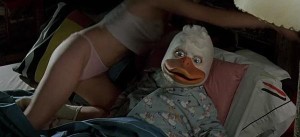
“They let kids watch this film????”
I loved Ghostbusters, and I loved Howard the Duck even more — as Sigourney Weaver’s Dana never wore anything close to the slinky, sexy outfit that perfectly framed Lea Thompson’s Beverly.
Though it had been 25 years, I was excited by the chance to review Howard the Duck for Now Playing Podcast. Our movie review show was coming up on its 4th anniversary and it had always been a way for me to discuss films for which I had passion. Whether I loved a film or hated it, if I felt something then I wanted to talk about it.
Around this time the show was also finally starting to find some success. Our early, short-form reviews had downloads that measured in the teens. With our Friday the 13th Retrospective Series — something I envisioned as a quick one-off — downloads jumped from the teens to the thousands.
We continued to work hard and over the years our audience started to find us. We were still a small fish in a large sea, but we had grown from a dwarf puffer to at least a catfish.
The success of our 2010 A Nightmare on Elm Street series emboldened me, and, that same year, Iron Man 2 inspired me. After seeing Iron Man, War Machine, Nick Fury, and Black Widow share the screen I could not contain my excitement for The Avengers. So I pitched to Stuart and Jakob the biggest retrospective series ever: all of the Marvel movies, in order, starting with Howard the Duck.
There was quite a bit of negotiation, wrangling, and reordering of movies; but between May 2010 and March 2011 we came to an accord and the Now Playing Marvel Movie Retrospective began.
It was our biggest series, or biggest gamble, and it all hinged on Howard.
Perhaps it was the buildup, but that show always seemed special. We were coming off the Philip K Dick Retrospective Series, which had been pushed to Spring 2011 after The Adjustment Bureau’s release date changed. Downloads were low on the Dick series and there were some production issues. By the time we hit The Adjustment Bureau morale behind-the-scenes was low.
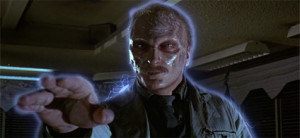 All of that changed with Howard. To my memory, that was the first Now Playing review that, in its raw audio, went more than three hours. Over the course of two years I had allowed Now Playing’s runtime to grow, but only one show had ever gone more than 2 hours: the 2010 review of the A Nightmare on Elm Street remake.
All of that changed with Howard. To my memory, that was the first Now Playing review that, in its raw audio, went more than three hours. Over the course of two years I had allowed Now Playing’s runtime to grow, but only one show had ever gone more than 2 hours: the 2010 review of the A Nightmare on Elm Street remake.
I spent about 80 hours editing our Howard the Duck review, trying to hold to the editor’s axiom of “kill your darlings.” But I just couldn’t do it.
Even during my 11th pass on the Howard the Duck review I was still laughing out loud at the jokes.
Before I even finished the edit I knew that show was something special. I just prayed it would find an audience.
It did.
Maybe it was the press releases I had sent, maybe it was the social media promotion, but for the first time, Now Playing Podcast broke through iTunes’ Top 10 TV/Film audio podcast rankings. It took a few days after the show was released, but we had done it!
That spot increased our visibility, and the downloads multiplied exponentially. To go from the unsuccessful Dick series to the top of the iTunes charts was just incredible. Howard the Duck became iTunes’ 5th most downloaded episode in the aforementioned category.
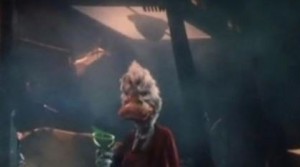
Howard had a theatrical come-back this year, but this mangy fowl is NOT my Howard! The costume in 1986 looked better than this.
The success was so astounding I actually hesitated before releasing the next show. I knew our Man-Thing podcast was also pretty funny, but the newest show is always the most downloaded. Downloads of Howard were sure to decrease.
Still, we had a schedule, and so Man-Thing went out on time, and became iTunes’ No. 1 most downloaded TV/Film audio podcast. The following week we reviewed Kick-Ass and it grabbed the No. 1 slot, pushing Man-Thing into second place.
Stuart, Jakob, and I were stunned. It was unbelievable to look at the iTunes rankings and see Man-Thing at the top. I have since joked that more people listened to our review of Man-Thing than actually saw that damn film.
One thing we all agreed on — it was Howard the Duck that launched those shows to the top. Howard was a special show, combining serious film criticism with a terrific dose of humor, making fun of ourselves as well as the film, and we knew that was why listeners kept coming back to our show.
Now Playing has had its ups and downs since then. Some shows and retrospectives click more with audiences than others, and some shows I am more proud of than others. Still, it was with Howard the Duck that all the pieces fell into place and listeners responded.
For those reasons I will always love that duck.
I have stated at least twice on the podcast that I wish I could turn that “Red Arrow” grade for Howard into a “Green Arrow” on our site. I realize the film has its flaws — I still believe the second act drags — but I enjoy it anyway. I gave Howard the review I did not because I didn’t like the movie, but because I didn’t think others would find the same enjoyment. After all, our end rating is always a “recommendation” and not a “thumbs up.” When I give the “Green Arrow” I’m not saying, “I like this movie,” I’m saying, “I think you will like this movie.”
Well, I knew back then that I liked Howard the Duck in spite of the flaws.
That fondness has grown as, through Now Playing, I’ve become closely associated with that “fowl” creature. Stuart and Jakob were with me in the review, but I was Howard’s champion (and the one that saw the Dark Overlord in a Rorschach test). Over the past three years that special relationship with this childhood guilty pleasure has grown.
I started collecting a few trinkets from the Howard the Duck film — the old trading cards, a candy cigar, a mini duck head that once held sugar treats. Then I got the Bowen statue, the Toy Biz figure. Finally, this year, I took the plunge — one of the Industrial Light and Magic creature shop workers was selling several Howard the Duck production pieces.
On my desk, a foot from me as I write, is a glass egg that Lucasfilm gave to crew and press back in 1986. Inside that egg is a single duck feather. The Howard the Duck logo on the front makes me smile, not because of that 1986 film about a duck trapped in a world he never made, but because of the podcast that I made that found its place in the world.
Tomorrow — 1987!
Arnie is a movie critic for Now Playing Podcast, a book reviewer for the Books & Nachos podcast, and co-host of the collecting podcasts Star Wars Action News and Marvelicious Toys. You can follow him on Twitter @thearniec
August 16, 2014 Posted by Arnie C | 40-Year-Old Critic, Comic Books, Marvelicious Toys, Movies, Music, Now Playing Podcast, Podcasts, Reviews | 1980s, 40-Year-Old Critic, Action, Collecting, Comic Books, Comics, Enertainment, Film, George Lucas, Marvel, Marvel Comics, Marvelicious Toys, Movie, Movies, News, Now Playing, Now Playing Podcast, Podcasts, Review, Reviews, sci-fi, Toys | Comments Off on 40 Year-Old-Critic: Howard the Duck (1986)
40 Year-Old-Critic: Goonies (1985)
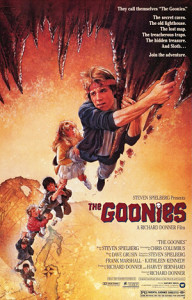 In The 40-Year-Old Critic, Venganza Media creator and host Arnie Carvalho recalls a memorable film for each year of his life. This series appears daily on the Venganza Media Gazette.
In The 40-Year-Old Critic, Venganza Media creator and host Arnie Carvalho recalls a memorable film for each year of his life. This series appears daily on the Venganza Media Gazette.
Tastes change through the ages. As a child I could not stand the bitterness of coffee, but now you wouldn’t want to engage me in conversation before my second cup. I also used to love maple sugar candy, a confection so sweet it made me gag when last I tasted it.
As it is with food and drink, so it is with movies.
Recently I attempted to watch The Goonies and I turned it off halfway through. It wasn’t the same.
But in 1985 I was a Goonie.
Executive produced by Steven Spielberg and directed by Superman’s Richard Donner, Goonies told the story of a group of pre-teen boys who lied to their parents, snuck out of the house, and saved the day. It was a film that continued a narrative Spielberg introduced in E.T.: a child outsmarting his parents and undertaking an adventure that would solve a family crisis and bring everyone closer together.
Surely every boy on the playgrounds of every school across America was the target audience for Donner’s film. Fat or thin, with or without braces, fast-talking or shy, there was a Goonie on screen with whom children and young teens could connect (Or at least every white child; the film lacked in diversity, with the only non-white child being an uncomfortable Asian stereotype).
For me, just 10 years old, I looked at the screen and saw myself as Mikey, the lead Goonie. Both of us were prone to flights of fancy, both of us would come up with crazy plans that often ended with my friends and I getting grounded, both of us still believed in the fantastical, and, hey, we were both asthmatic.
I was thrilled as the Goonies dodged booby traps and slid down a waterfall. I rocked out to the soundtrack featuring pop stars like Cindi Lauper and The Bangles. I shuddered when Chunk was locked in a room with the monstrous Sloth, and then cheered when the two became best friends and saved the day. I was engrossed as I watched the Goonies not only outsmart their parents, but also overcome the criminal Fratelli family. Truly this was a kid-power film if ever there was one!
At the time I didn’t see the movie for what it was: Indiana Jones for the playground set. Just look at all the booby traps, the majority of The Goonies could have been filmed on remnants left over from Temple of Doom.
Instead, I just went with the Goonie kids on their wild adventure to find One-Eyed Willy, and left the theater feeling that children could do anything. Parents were but unnecessary obstacles that tried to downplay the magical nature of the world.
This was the message I learned from so many films, from E.T. to Explorers to Cloak and Dagger to The Last Starfighter; but it was Goonies that drove it home. My childhood friends and I started to have our own misadventures, including the time we tried to catch some teenage drug-dealers by the mall, or when we started investigating ghosts that may or may not have haunted my house (both of these stories ended in humiliation and ruin).
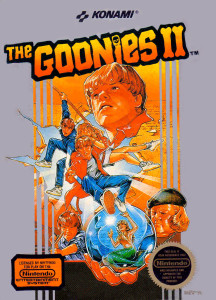
A couple years later my dream of Goonies 2 came true–but in a Nintendo game. My script was better; it didn’t have needless mermaids.
Even more though, if children could do anything, why couldn’t we actually be Goonies? By age 10 I was familiar with moviemaking — having watched many behind-the-scenes TV specials. I picked up movie magazines that had interviews and profiles with the actors and directors involved. The movie Clue, with its multiple, random endings, even started to give me ideas about marketing.
Not understanding the struggle child actors face trying to break into Hollywood, I was resentful of the Goonies casting and what I considered “Hollywood nepotism.” My Goonies Official Film Magazine made me realize all the Goonies were either actors who had been in other films (Corey Feldman and Jonathan Ke Quan) or children of famous people (Sean Astin and Josh Brolin). Obviously, boys from Springfield, Illinois, had no chance of being cast.
So I decided to make my own Goonies 2.
It had to happen — a 10-year-old boy obsessed with watching movies would surely turn into an 11-year-old who wanted to make movies. My parents had an 8mm film camera for family movies and, at age 8, I’d already filmed Star Wars 4: The Return of Darth Vader.
It’s a mostly ad-libbed, terribly embarrassing 10-minute-short that ended with Luke Skywalker and Darth Vader playing together in a swimming pool.
But I was now older, wiser, and had dreams of filmmaking.
Over the span of a month I hammered out a script for Goonies 2. The plot was simple enough: the jewels were not enough to save the homes and the Goonies had to go out and find even more money. With my best friend Stuart’s help we cast our friends and family in various roles. A group of us even successfully recreated some of Data’s gadgets, including a spring-loaded, belt-worn dart gun.
I clearly was not alone in this dream. Earlier this year I saw an episode of the ABC sitcom The Goldbergs in which lead character Adam tried the exact same thing! As this show is loosely based off the real life experiences of showrunner Adam Goldberg, I do wonder how many other kids across the country were inspired to grab cameras and try filmmaking because of this Donner-Spielberg adventure.
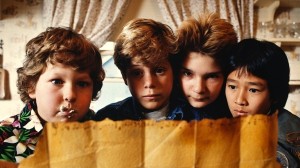
I felt “Good Enough” to hang with The Goonies
Fortunately, we never shot a frame of Goonies 2 — I doubt I could survive such embarrassment. The props were repurposed into a sixth-grade class performance for Goonies Cereal (we got an A). The script, typed in Wordstar on a NEC APC III, was lost when the 5.25-inch floppy was bent. My only memory of the script is my sister Linda saying she had memorized her dialogue. She was cast as Mama Fratelli, and all she did was scream.
Rewatching The Goonies recently, I imagine my 10-year-old self really did tap into the core of that film, because it’s full of screaming, shouting, hollering, and various other loud noises.
As an adult it was just an assault on my senses.
The film is too sugar-fueled, too chaotic, and too… kiddie for me to enjoy. But I will always have those memories of being 10 and dreaming I could be a Goonie.
So, if this were an episode of Now Playing Podcast, would I recommend The Goonies? Being a film critic means more than just saying “I liked a film.” Everyone has opinions, but an opinion is not a critique. While personal judgments will always play into a review, more must be taken into account in order to properly judge any creative work. Not every film is made for mass appeal, and sometimes focusing on a niche audience is key to a movie’s success. The Goonies clearly struck a chord with its core audience, and I can’t think of a higher recommendation than that.
Tomorrow — 1986!
Arnie is a movie critic for Now Playing Podcast, a book reviewer for the Books & Nachos podcast, and co-host of the collecting podcasts Star Wars Action News and Marvelicious Toys. You can follow him on Twitter @thearniec
August 15, 2014 Posted by Arnie C | 40-Year-Old Critic, Movies, Now Playing Podcast, Podcasts, Reviews | 1980s, 40-Year-Old Critic, Corey Feldman, Enertainment, Film, Goonies, Joey Pants, Josh Brolin, Movie, Movies, Review, Reviews, Richard Donner, Sean Astin, Sloth, Steven Spielberg | 1 Comment
‘Turtles’ Power Now Playing on iTunes, ‘Children’ lurking
Now Playing Podcast is leaving the sewers and venturing into the cornfields.
Venganza Media’s flagship podcast capped its Teenage Mutant Ninja Turtles Retrospective Series this week with its review of the Michael Bay-produced franchise reboot. The film marked the Turtles’ return to the big screen after a 7-year layoff and captured the box office crown on opening weekend.
Now Playing Podcast marked its own triumph on Thursday, when its Teenage Mutant Ninja Turtles (2014) episode debuted at No. 5 on iTunes’ TV & Film audio podcast rankings.
The achievement extends Now Playing’s summer winning streak, highlighted by the Teenage Mutant Ninja Turtles II episode, which peaked at No. 2 on iTunes in late July.
Throughout the TMNT series, hosts Arnie Carvalho, Stuart Atkinson and Jakob Brewster have guided listeners through the highs and lows of Ninja Turtles lore, and ventured outside of the feature films to discuss long-forgotten turns in the franchise’s history, including the infamous Coming Out Of Their Shells concert tour.
“Turtle Power is a real thing, it cannot be underestimated,” Atkinson joked. “I give all the credit to those green guys. They’ve been through hell at the movies and they deserve a little Top 10 love.”
With the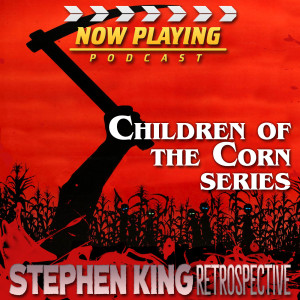 Turtles franchise now in their rear view, the hosts are set to begin the next chapter in Now Playing’s massive Stephen King retrospective. The series, which began last fall, picks up again Aug. 19 with Children of the Corn, a nine-episode arc that will complete Now Playing’s coverage of King’s Night Shift collection.
Turtles franchise now in their rear view, the hosts are set to begin the next chapter in Now Playing’s massive Stephen King retrospective. The series, which began last fall, picks up again Aug. 19 with Children of the Corn, a nine-episode arc that will complete Now Playing’s coverage of King’s Night Shift collection.
The first Corn adaptation hit theaters in 1984 and was followed by seven poorly-received sequels, as well as a television remake. Fans of Now Playing’s earliest horror retrospective series’ can look forward to the hosts continuing their discussion of Hollywood’s sequel addiction as they try their best to remain composed in the face of mediocre filmmaking.
“Reviewing Night Shift has been a long haul, and I say that as the King fan!” Carvalho said. “I haven’t watched most of these Corn films, but they made nine of them — there has to be something there, right?”
“Nine films? Most direct-to-video?” Brewster added. “I just hope I can come up with enough corn puns to bring a kernel of humor to our listeners’ ears. Sigh.”
The Children of the Corn series will carry Now Playing Podcast into early October, before the hosts embark on a journey through the films of director Christopher Nolan, leading up to the release of November’s Interstellar.
August 14, 2014 Posted by Arnie C | News, Now Playing Podcast, Podcasts | Arnie, Children of the Corn, iTunes, Jakob, News, Now Playing, Now Playing Podcast, Podcast, Podcasts, Stephen King, Stuart, Stuart in LA, Teenage Mutant Ninja Turtles | Comments Off on ‘Turtles’ Power Now Playing on iTunes, ‘Children’ lurking
40 Year-Old-Critic: Beverly Hills Cop (1984)
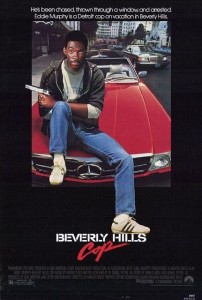 In The 40-Year-Old Critic, Venganza Media creator and host Arnie Carvalho recalls a memorable film for each year of his life. This series appears daily on the Venganza Media Gazette.
In The 40-Year-Old Critic, Venganza Media creator and host Arnie Carvalho recalls a memorable film for each year of his life. This series appears daily on the Venganza Media Gazette.
For as long as there have been movies, there have been movie stars.
As early as the 1910s film studios realized familiar faces could bring in audiences. From Florence Lawrence to Humphrey Bogart, Marilyn Monroe to Charlton Heston, Tom Cruise to Will Smith, the right movie star can trump story, script, and even production value and turn terrible films into box office gold.
As a child, though, I didn’t understand the concept of following actors; instead, I followed characters. I wanted to see the next film with Kermit the Frog, Luke Skywalker, or God. I wasn’t thinking about Jim Henson, Mark Hamill, or George Burns.
That changed in 1984 when I found my first cinema idol, the man I wished I’d grow up to be.
Much to my parents chagrin, that man was Eddie Murphy.
I was not much of a Saturday Night Live fan when I was young. While I didn’t have a set bedtime, midnight was a bit later than I usually stayed up. I’d seen the show a few times but I was neither a fan, nor did I even know the comedians in the cast.
But in 1984 I had become a cinephile, seeing dozens of films in theaters and countless more on VHS. In addition to the standard kids fare, like Ghostbusters and The Neverending Story, my tastes were starting to evolve. Thanks to Siskel & Ebert I was asking my parents to take me to see some movies where I was clearly not the target audience, such as Amadeus, as well as the fairly risque Johnny Dangerously (I saw it in theaters once… once).
My older sister Susan, home from college for Christmas break, witnessed my maturing interest in film and felt there was one movie phenomenon I was totally missing: Beverly Hills Cop. It had been out a few weeks and had started to build amazing buzz. Critics loved it, and it was topping the box-office.
 But it had a hard-R rating, with nudity, intense gun violence, and more curse words than I could count. My parents were fairly lax about what media I consumed (a year later they’d let me rent Revenge of the Nerds knowing full-well what I was about to see), and Susan decided it’s better to beg forgiveness than to ask permission. So she took me to the mall, ostensibly to Christmas shop, but, in fact, to see my first R-rated film: Beverly Hills Cop.
But it had a hard-R rating, with nudity, intense gun violence, and more curse words than I could count. My parents were fairly lax about what media I consumed (a year later they’d let me rent Revenge of the Nerds knowing full-well what I was about to see), and Susan decided it’s better to beg forgiveness than to ask permission. So she took me to the mall, ostensibly to Christmas shop, but, in fact, to see my first R-rated film: Beverly Hills Cop.
I was absolutely awestruck. I had never seen a movie as extreme as this.
The story, originally intended to star Sylvester Stallone, followed fast-talking Detroit police detective Axel Foley’s trip to Los Angeles investigating the murder of his childhood friend. But the cop becomes the criminal when clues point to wealthy art dealer Victor Maitland, and police actually authorized to act in the Beverly Hills jurisdiction try to reign in Foley’s unorthodox inquest. The result is quite a bit of 80’s action, as well as the usual fish-out-of-water jokes, as Foley works both with and against the Beverly Hills Police Department in trying to bring his friend’s killer to justice.
The violence excited and frightened me. I’d seen guns on the big (and small) screen, but before Beverly Hills Cop I’d never seen a man shot twice in the head; chunks of the victim’s skull falling to the carpet. I’d seen car chases on Dukes of Hazzard and other shows, but none had the metal carnage like the truck chase in the film’s opening minutes. I’d seen machine gun shootouts on The A-Team, but those didn’t actually have people falling dead from the wounds.
Then there was the language. My parents had been known to use a few choice words but never had I heard expletives used in this way. Murphy had gone beyond just cursing, he turned his Beverly Hills Cop dialogue into a virtual tone poem of profanity. So shocked was I that I completely misunderstood the main character’s name — in my mind Murphy starred as “Asshole Foley”, with every single character referring to him by that descriptive term. Given the way he acted, who could blame them?
Yet, the entire picture was set to a light, pop score. The synth tones of Harold Faltermeyer ran throughout, interrupted only by chart-topping hits by The Pointer Sisters, Glenn Frey, and Vanity. I was never afraid or scared, I was enthralled. My adrenaline was pumping, I was rocking, and, most importantly, laughing. I had never before experienced a film that felt subversive, like I was seeing a peek into the adult world, hearing how they talked with no kids around.
I loved it.
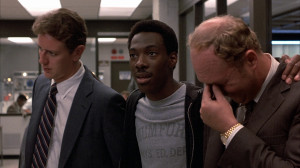 More, I loved Eddie Murphy. The comedian is in nearly every frame of Beverly Hills Cop and his energy is infectious. Here the actor perfected the con-artist persona he previously used on the small screen, as well as in 48 Hours and Trading Places. No matter how dangerous the situation, I knew Murphy would be able to talk, joke, or shoot his way out of it. I don’t recall ever laughing quite as hard as I did in that theater watching Axel Foley stick a banana up the tailpipe of that car staked outside his hotel.
More, I loved Eddie Murphy. The comedian is in nearly every frame of Beverly Hills Cop and his energy is infectious. Here the actor perfected the con-artist persona he previously used on the small screen, as well as in 48 Hours and Trading Places. No matter how dangerous the situation, I knew Murphy would be able to talk, joke, or shoot his way out of it. I don’t recall ever laughing quite as hard as I did in that theater watching Axel Foley stick a banana up the tailpipe of that car staked outside his hotel.
I walked out of the theater ecstatic. I wanted to see more. For the first time in my life I was starstruck and wanted to see everything Eddie Murphy had done or would do.
I made it a point to stay up late that week and watch Murphy host Saturday Night Live (his “White Like Me” sketch still makes me laugh). Quickly I went to the video store to rent his previous two hits. And I went opening weekend, again with Susan, to see The Golden Child.
Yes, I even bought the novelization to try and quell my excitement two years later for Beverly Hills Cop II.
I started buying Eddie Murphy comedy albums and watching Raw and Delirious. Through those specials I connected with Murphy, because I realized I idolized him as Murphy in his youth idolized Richard Pryor. I even found myself trying to tell Eddie Murphy-style jokes, and, for a time, flirted with the idea of doing stand-up comedy. I didn’t have much of a sense of humor as a child; I developed it in my teen years and Murphy was my teacher.
My parents were not overly fond of their son’s new hero. The string of profanity that emitted from our family room television would prompt my mother to use a few choice words of her own.
I didn’t see it the way she did. Murphy’s complete ownership of his vocabulary allowed me to see the power words have without fear. As a young kid I would curse for the wrongness of it, but Murphy helped me see that cursing punctuates language with an emphasis that nothing else can emulate.
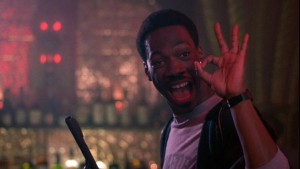 Older generations would state that swearing was for the dumb; Murphy showed me the truly intelligent know-how to wield every word for maximum impact. Some listeners have complained about the language we sometimes use on Now Playing Podcast, but I would not change a syllable. I believe the complete use of the English language allows me to express myself uniquely and clearly. I learned that from Murphy’s ad-libs and stand-up routines.
Older generations would state that swearing was for the dumb; Murphy showed me the truly intelligent know-how to wield every word for maximum impact. Some listeners have complained about the language we sometimes use on Now Playing Podcast, but I would not change a syllable. I believe the complete use of the English language allows me to express myself uniquely and clearly. I learned that from Murphy’s ad-libs and stand-up routines.
I wasn’t the only one to fall under Axel Foley’s influence. Beverly Hills Cop became the first R-Rated film — and the first comedy — to gross more than $200 million at the box office. That was a very exclusive group well into the 1990s.
Murphy even beat fellow Saturday Night Live alums Bill Murray and Dan Aykroyd, with Cop making more money in 1984 than Ghostbusters.
I must admit that Ghostbusters, with its lighthearted comedy, special effects, and giant Marshmallow Man, left a cinematic legacy that may be greater than Beverly Hills Cop. The Ghostbusters formula is aped to this day with films like R.I.P.D., Men in Black, and Evolution. There’s even a director signed for Ghostbusters III.
On the other hand, I don’t feel Murphy has aged as well. While his box-office mojo reigned for many years, even as a child I knew his follow-up films, The Golden Child and Beverly Hills Cop 2, didn’t measure up to his first star vehicle. While Coming to America was a brief return to form, it was also the last time I loved an Eddie Murphy film.
After The Distinguished Gentleman I realized his films had dropped significantly in quality, but due to my childhood devotion, I saw every film Murphy released through the 1980s and 1990s (yes, even Holy Man and Life). I watched every new Murphy movie hoping to laugh as hard as I did in Beverly Hills Cop and Coming to America. I finally gave up in 2001, I could not abide Pluto Nash.
But Murphy was the first movie star to impact my viewing habits. For that reason, even though I should know better, I continue to cross my fingers and hope the “Asshole Foley” I know and love will be back in Beverly Hills Cop IV.
Arnie is a movie critic for Now Playing Podcast, a book reviewer for the Books & Nachos podcast, and co-host of the collecting podcasts Star Wars Action News and Marvelicious Toys. You can follow him on Twitter @thearniec
August 14, 2014 Posted by Arnie C | 40-Year-Old Critic, Movies, Now Playing Podcast, Podcasts, Reviews | 1980s, 40-Year-Old Critic, Action, Beverly Hills Cop, Comedy, Eddie Murphy, Enertainment, Film, Ghostbusters, Movie, Movies, Now Playing, Now Playing Podcast, Podcasts, Review, Reviews | 6 Comments
40 Year-Old-Critic: E.T. the Extra-Terrestrial (1982)
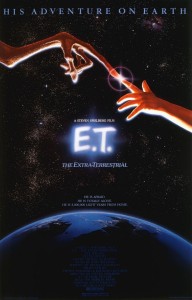 In The 40-Year-Old Critic, Venganza Media creator and host Arnie Carvalho recalls a memorable film for each year of his life. This series appears daily on the Venganza Media Gazette.
In The 40-Year-Old Critic, Venganza Media creator and host Arnie Carvalho recalls a memorable film for each year of his life. This series appears daily on the Venganza Media Gazette.
Movies are magic.
The commonplace nature of cinemas in the United States allow us to take for granted the power of cinema. Most of us live close to prolific multiplexes, so no effort is needed, no great journey undertaken, to get to a theater.
But once inside we enter a dark room and are taken far away from our everyday lives. It is so easy to fall into the world of a well-crafted movie that I often find myself lost in the experience. That magic of cinema makes me a movie lover to the point that I spend countless hours each week watching and reviewing films for Now Playing Podcast.
Because cinematic worlds are consumed so easily by moviegoers, it is easy to overlook the talent of hundreds, sometimes thousands, of people whose combined work creates a vision from nothing. I know as a very young child I never thought about who made a film. I never envisioned writers trying to sell a spec script, directors scouting for suitable locations, or puppet-makers designing detailed creatures. Despite loving Star Wars I didn’t know the name George Lucas. I just paid my two dollars and was taken to a galaxy far, far away.
But I can very clearly remember the year in my life when that simplistic view of movies changed, and I realized movies were made by people — and certain people made films better than others.
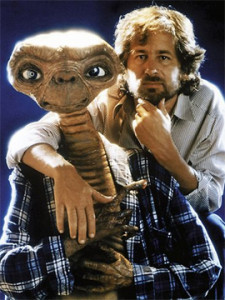 I was 7 years old, the year was 1982, and the film that made it clear was Steven Spielberg’s E.T. the Extra-Terrestrial.
I was 7 years old, the year was 1982, and the film that made it clear was Steven Spielberg’s E.T. the Extra-Terrestrial.
I didn’t know Spielberg’s name, nor his work. Jaws, Close Encounters of the Third Kind and Raiders of the Lost Ark may have been the films that made the director a household name, but as a young child that was lost on me.
The first time I paid attention to his name was a Saturday night in the spring of ‘82. Despite my age, my Saturday night ritual was to watch Siskel & Ebert At The Movies. I was interested in which movies deserved the coveted “Thumbs Up” from the critics, but more than that I loved seeing the clips of so many different movies all in a half-hour. Through these two iconic critics I was exposed to more movies than my parents would allow me to see.
On this particular Saturday night Gene Siskel and Roger Ebert showed a movie clip from E.T. that fascinated and scared me. It was the scene where Elliott rolls a baseball into the shed, and it comes back out. He runs in and gets his family, and his older brother, Michael, looks down at the alien footprints in the dirt and declares, “The coyote’s come back again, Ma.”
The pre-release materials never allowed audiences to view the alien creature — you had to pay admission to see it — but from that trailer I felt there was something dangerous and wondrous in that shed. I thought E.T. was a horror film and I thought Elliott was in grave danger from the unseen beast, but I wanted to know more.
In their review Gene Siskel and Roger Ebert repeatedly referenced director Steven Spielberg.
 I remember going to see E.T. opening weekend. Unlike Raider’s of the Lost Ark the year before, I would not miss this film. But I needn’t have feared — going was a family event. For a change it wasn’t just the science-fiction obsessed boy in the house demanding to see the movie. Everyone, from my workaholic, absentee father to my pragmatic mother to all three of my teenaged sisters, wanted to see this movie.
I remember going to see E.T. opening weekend. Unlike Raider’s of the Lost Ark the year before, I would not miss this film. But I needn’t have feared — going was a family event. For a change it wasn’t just the science-fiction obsessed boy in the house demanding to see the movie. Everyone, from my workaholic, absentee father to my pragmatic mother to all three of my teenaged sisters, wanted to see this movie.
Being a large family with children ranging from 7 to 19, whole-family outings to a movie theater were rare. But this was one of those occasions. I remember the six of us taking up a good portion of the row, and how I was once again transported into the world Spielberg created. I also remember crying at the end, and trying desperately not to.
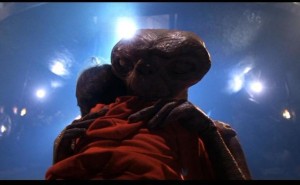 As a child I was very sensitive. I also was not wholly unfamiliar with the idea of a bittersweet ending. My sister Susan helped me remember watching a rerun of the 1978 TV special Puff the Magic Dragon and how at the end Puff flew off, leaving Jackie alone. I didn’t understand then the importance of Jackie’s transformative experience with Puff, I just saw a boy losing his friend. I heard the line, “Dragons live forever, not so little boys” and I cried. Hard. My father, however, had no sympathy and chastised his 4-year-old son for getting emotional over a television show.
As a child I was very sensitive. I also was not wholly unfamiliar with the idea of a bittersweet ending. My sister Susan helped me remember watching a rerun of the 1978 TV special Puff the Magic Dragon and how at the end Puff flew off, leaving Jackie alone. I didn’t understand then the importance of Jackie’s transformative experience with Puff, I just saw a boy losing his friend. I heard the line, “Dragons live forever, not so little boys” and I cried. Hard. My father, however, had no sympathy and chastised his 4-year-old son for getting emotional over a television show.
Now here it was just a few years later and that Puff ending was replayed with E.T. leaving Elliott, and once more I was crying. My father was sitting just a few seats away, and I tried to hold in the tears. I failed, and left the theater sobbing.
I also left that theater changed. The film had engrossed me, and I’m told I wouldn’t stop talking about it for weeks to come.
More, I kept going back to see it. The second time I saw E.T. I went with Stuart, whom I had met the previous year in grade school. Knowing the ending in advance, I told myself I’d hold it together. I did better, but when the credits rolled my lower lip was quivering and tears streamed down my face. Then I saw it with my godparents, then a babysitter, then my mother’s friend who took me, both to occupy me one afternoon and to see the film herself.
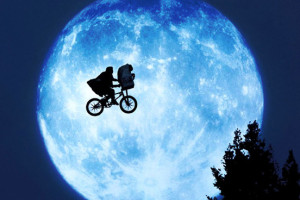 Going to see E.T. became a habit. I ended up seeing it about a dozen times in theaters.
Going to see E.T. became a habit. I ended up seeing it about a dozen times in theaters.
Then I started to seek out more about Spielberg. I started to connect that name with Raiders of the Lost Ark and other films both at the video store and in theaters. Through At The Movies I became more exposed to the people behind the camera, as well as in front of it. But no matter how many names I learned, Spielberg’s was special from that moment with E.T.
That film was a massive success, dethroning Star Wars as the highest-grossing picture of all time. As such, the number of “Spielberg films” exploded, from Gremlins to Goonies, Indiana Jones and the Temple of Doom to Back to the Future, Poltergeist and even An American Tail (which, at 12, I felt far too old to see in theaters, but went for Spielberg). I sought them all out.
The lesson I learned as a 7-year-old took many more years to sink in fully. I spent my teen years following actors instead of filmmakers. I would enjoy a film with Corey Feldman, John Candy, or Eddie Murphy and wanted to see more of them, but I was repeatedly disappointed by the uneven nature of their performances. Finally, later in life, I would relearn the childhood lesson, as I started to appreciate films for those who made them. I would follow the careers of Oliver Stone, Quentin Tarantino, Richard Linklater, Darren Aronofsky, and others.
But Spielberg was the first auteur to excite me — at just 7 years old — as I watched E.T. phone home again and again.
Next — 1983!
Arnie is a movie critic for Now Playing Podcast, a book reviewer for the Books & Nachos podcast, and co-host of the collecting podcasts Star Wars Action News and Marvelicious Toys. You can follow him on Twitter @thearniec
August 12, 2014 Posted by Arnie C | 40-Year-Old Critic, Movies, Now Playing Podcast, Podcasts, Reviews | 1982, 40-Year-Old Critic, Be Good, E.T., E.T. the Extra-Terrestrial, ET, Movie, Review, Reviews, Steven Spielberg | Comments Off on 40 Year-Old-Critic: E.T. the Extra-Terrestrial (1982)
Teenage Mutant Ninja Turtles (2014)
Platinum Dunes Studios has released more franchise reboots than original films, attempting to update horror classics Friday the 13th, The Amityville Horror, and Texas Chainsaw Massacre for a new generation. Their latest reboot is of a totally different sort–Teenage Mutant Ninja Turtles! Can producer Michael Bay bring his Transformers toyetic touch to the Turtles? Join Stuart, Arnie, and Jakob in this final TMNT review to find out!
Arnie C: http://traffic.libsyn.com/nowplayingpodcast/NPPTMNT05.mp3
August 11, 2014 Posted by arniec | Movies, Now Playing Podcast, Podcasts, Reviews | Enertainment, Film, Movies, Now Playing Podcast, Podcasts, Reviews | Comments Off on Teenage Mutant Ninja Turtles (2014)
40 Year-Old-Critic: Raiders of the Lost Ark (1981)
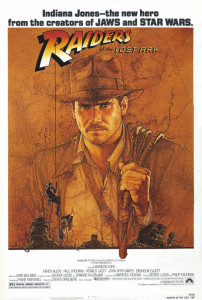 In The 40-Year-Old Critic, Venganza Media creator and host Arnie Carvalho recalls a memorable film for each year of his life. This series appears daily on the Venganza Media Gazette.
In The 40-Year-Old Critic, Venganza Media creator and host Arnie Carvalho recalls a memorable film for each year of his life. This series appears daily on the Venganza Media Gazette.
I wrote at length about the summer blockbuster in the 1975 installment of this retrospective series discussing Jaws. I recalled how it seemed each year had one movie that everyone was talking about. Hollywood now gives its tentpole pictures one or two weeks to make an impact, but when I was a kid the biggest films ran for months and would remain in the public conversation for years.
In 1981 I learned what it was like to be on the outside of that conversation.
I spent a lot of time at the movies as a kid. I remember a summer program in our town that screened older, child-friendly films each week for just $1 — a small price for my mother to pay to have me sit quietly for two hours. My mother, my godmother, and my sister would coordinate schedules to take me to see those summer films and, being the completist that I am, I refused to miss a single installment.
Not content with the preprogrammed children’s fare, I started to make my own decisions about which new releases I would see. I remember begging my mother to take me to Clash of the Titans, The Great Muppet Caper, Superman II, and The Fox and the Hound. But one film that totally escaped my attention was Raiders of the Lost Ark.
By the summer of ‘81 Steven Spielberg was already a name-brand director with blockbusters Jaws and Close Encounters of the Third Kind under his belt. He’d survived a rare misstep with the ill-conceived 1979 comedy 1941 and returned to form two years later with the first installment in the Indiana Jones franchise.
This film carried more than just Spielberg’s golden name. The poster boasted “From the creators of Jaws and Star Wars.” It was Spielberg’s collaboration with the man who had made the most successful film of all time… George Lucas.
With those names on the poster it is no shock that moviegoers turned out in droves to see the film, with no misgivings about its period setting — a far cry from the filmmakers’ recent science-fiction fare. Plus Raiders wisely featured a strong supernatural bent for those who appreciated the fantastical elements of Close Encounters and Star Wars.
Raiders of the Lost Ark went on to become the top-grossing film of 1981. It was a cultural smash, a critical darling, and nominated for several Academy Awards.
I totally missed it.
The first Indiana Jones movie opened in our town on June 12 — the same day as Clash of the Titans. I didn’t just choose to see Greek gods over Indiana Jones, I have no memory of knowing Raiders of the Lost Ark was out there. Soon after, Superman II opened, and that was the movie I’d been waiting to see.
Raiders was totally lost on me.
When school resumed that fall it didn’t take long for me to realize I’d missed something huge. Now a second-grader, I returned to classrooms ready to reunite with schoolyard friends and talk about Clash of the Titans and Superman II, but the only movie on their minds starred some guy with a whip. Playground chums regaled me with tales of the swordsman who performed deft moves only to be quickly shot dead, and that magical box that made Nazi faces melt. I had nothing to add to these conversations, I could only nod and say it sounded fun.
 This feeling of isolation continued for years, and I felt Raiders of the Lost Ark would taunt me forever. For Christmas in 1982 my sister Susan bought me the Raiders of the Lost Ark Atari 2600 game. She was now a college student and assumed I’d seen the film and loved it. I played that game for days, trying to use it as a surrogate for the movies I’d missed. I created a story in my mind featuring snakes and whips and anchs and black markets.
This feeling of isolation continued for years, and I felt Raiders of the Lost Ark would taunt me forever. For Christmas in 1982 my sister Susan bought me the Raiders of the Lost Ark Atari 2600 game. She was now a college student and assumed I’d seen the film and loved it. I played that game for days, trying to use it as a surrogate for the movies I’d missed. I created a story in my mind featuring snakes and whips and anchs and black markets.
Finally, the next year, my long nightmare ended.
In late 1982 my family bought our first VCR and, a few months later, we rented Raiders of the Lost Ark on VHS. Of course, I loved the film (and was surprisingly happy to see how little it resembled its Atari counterpart). It was exciting and funny, and also a bit scary. I had nightmares for months about those melting faces. Though I would rewatch Raiders regularly on video, for the first year or more I would cover my own eyes during the bloody climax.
Then, in 1984, when Indiana Jones and the Temple of Doom was released, I ensured I didn’t make the same mistake — I saw the sequel twice on opening weekend and read the novelization.
I still watch Raiders of the Lost Ark regularly to this day (though I now laugh at the effects that made me wince as a child). Just this past summer I went on a fishing trip with friends and we gathered around the cabin’s small television to watch Harrison Ford in his second-best role. We applauded its genius, debated the importance of Indy in the movie’s plot, and lamented the franchise’s abysmal fourth installment.
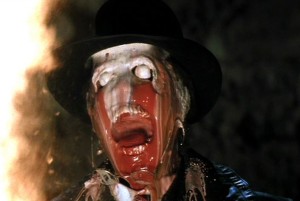 Raiders of the Lost Ark was the best film of 1981, but it also taught me the importance of cinema as part of a cultural conversation. Shared experience creates a community, and in the 1980s part of our nationwide identity was defined by blockbuster films. National defense programs were named after sci-fi flicks, presidential candidates quoted hit movies, and playground friendships were made and broken by what you saw over summer vacation.
Raiders of the Lost Ark was the best film of 1981, but it also taught me the importance of cinema as part of a cultural conversation. Shared experience creates a community, and in the 1980s part of our nationwide identity was defined by blockbuster films. National defense programs were named after sci-fi flicks, presidential candidates quoted hit movies, and playground friendships were made and broken by what you saw over summer vacation.
I do feel that today some of the magic is lost when there is a new “must see” movie every weekend. It waters down the experience. Now there are more fractured groups of fans, and rarely is there a film like Titanic, Star Wars, E.T., or Raiders of the Lost Ark that can transcend age, race, and gender and become a cultural phenomenon.
At 6 years old I learned how important that was, thanks to Raiders, and it’s a belief I hold today.
Next — 1982!
Arnie is a movie critic for Now Playing Podcast, a book reviewer for the Books & Nachos podcast, and co-host of the collecting podcasts Star Wars Action News and Marvelicious Toys. You can follow him on Twitter @thearniec
August 11, 2014 Posted by Arnie C | 40-Year-Old Critic, Movies, Now Playing Podcast, Podcasts, Reviews | 1981, 40-Year-Old Critic, Clash of the Titans, George Lucas, Harrison Ford, Indiana Jones, Now Playing, Now Playing Podcast, Podcasts, Raiders of the Lost Ark, Review, Reviews, Steven Spielberg, Superman | 4 Comments
40 Year-Old-Critic: Popeye (1980)
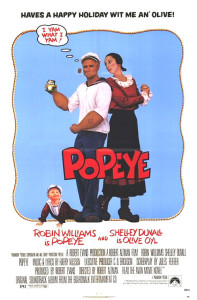 In The 40-Year-Old Critic, Venganza Media creator and host Arnie Carvalho recalls a memorable film for each year of his life. This series appears daily on the Venganza Media Gazette.
In The 40-Year-Old Critic, Venganza Media creator and host Arnie Carvalho recalls a memorable film for each year of his life. This series appears daily on the Venganza Media Gazette.
What, you thought The Empire Strikes Back was a given for 1980? Absolutely not! Let me explain.
1980 is a special year for me because it is the first year I can actually remember seeing movies in theaters. I have vivid recollections of my mother taking me to see The Empire Strikes Back on a hot summer day while weekending in Chicago, and I remember going to see Superman II when it opened at our local mall. And I remember later that year my sister Susan taking me to see the Robin Williams “comedy” Popeye, and sadly this is the moviegoing experience I remember best of all.
As a child I loved cartoons. Mostly, I was interested in superheroes like Superman, but I watched the Bozo show religiously and it featured a variety of cartoons, including Tom and Jerry, Mighty Mouse, and Popeye. I consumed this animated fare as part of a daily television diet.
My TV viewing was not confined to mornings, I was also starting to watch prime time shows. Being the youngest child in the house I rarely choose what shows were on our one television. Occasionally, when I was alone, I’d get to see Dukes of Hazzard or The Incredible Hulk. But most nights I watched whatever my older sisters wanted to see.
Their tastes ran to sitcoms of the day: Happy Days, The Jeffersons, Three’s Company,The Facts of Life, and my absolute favorite, Mork & Mindy. Robin Williams’ character, along with his colorful costumes, kept my attention for the full half-hour every Thursday night.
So, Williams as Popeye? It had to be a no-brainer for Susan to take her kid brother to that movie. To this day, the experience of seeing that film is burned into my brain.
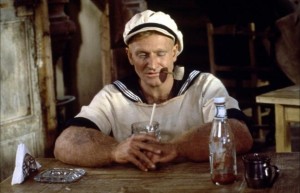
I yam what I yam…a bad movie.
My first reaction to this dirty, ugly picture was, “This isn’t my Popeye!” I wasn’t sure what had happened to the character I loved from The Bozo Show, but as shown on-screen “our hero” Popeye was beaten down and disavowed. His every scene seemed to be a boring exercise in humiliation. Worst, this Popeye hated spinach! A recent rewatch made it clear that the ingestion of that canned plant is the character’s arc — his origin story — but to a 6-year-old it seemed this movie didn’t know the first thing about the cartoon I loved. It lacked the crazy, fast-paced antics of the animated show and replaced it with warbled songs sung by Shelley Duvall and Robin Williams, neither of whom should ever be allowed to sing again (Aladdin aside). It seems even Williams was embarrassed during the making of the movie–he looks depressed in nearly every scene.
And it wasn’t just Williams, it was everyone. As Pappy, Ray Walston was a frightening character who denied Popeye’s parentage. Bluto was a bully that seemed comical in animation, but when personified in the flesh his hairy bulk repulsed me.
At 6 years old I did not yet possess the vocabulary to express how this movie made me feel. I did not know the meaning of words like “abrasive” or “grimy.” I couldn’t properly express that Popeye lacked the fun, spirited tone of the cartoon, and that its rundown river-town setting made me feel like I needed a hot bath. I didn’t just experience disappointment, I had a feeling of utter betrayal — and not just by Popeye. I wasn’t that big of a fan where an inaccurate on-screen portrayal would scar me.
No, I felt betrayed by cinema.
Up until this point in my life I’d had a magical experience every time I had gone to the movies. I’d seen Yoda teach Luke Skywalker about good and evil. I’d listened to Muppets sing and loved it. I’d seen God in the guise of George Burns. I’d been enthralled as Mickey Mouse made brooms dance. I’d believed a man could fly! I hadn’t seen a lot of movies in theaters at this age, but each one seemed hand-picked for maximum enjoyment. I thought the movie theater was a place where only good things happened.
Seeing Popeye made me realize, for the first time, that a movie could be really, truly terrible. In some ways, it was the death of my childhood innocence.
I insisted my sister take me back to the movies a week later to wash the taste of spinach out of my mouth. She picked a film I hadn’t heard of, Flash Gordon. Again, I thought I would be seeing another cartoon hero come to life (I’d mistaken it for the DC Comics hero, The Flash).
It was like a one-two punch, Popeye and Flash Gordon. I’d never look at movies the same again.
From the moment I walked, shell-shocked, out of that mall theater something inside me changed. My trust in the silver screen was broken. It would take many years for me to fully comprehend the enormity of that concept — that choices had to be made where I spent my money and time — but it all started with what surely must be director Robert Altman’s worst picture.
I am now about to turn 40, but inside I’m still a 6-year-old every time I go into a theater. I still hope every movie I watch — especially every theater-going experience — will be magical and wondrous. And I still feel betrayed when I’m instead given something as disastrous as Popeye or Aliens vs Predator.
At least now I can channel those memories and spare others from the letdown I experienced. As a critic on Now Playing Podcast I, hopefully, can warn people when there’s a Popeye at the multiplex. Also, as an adult, I can now fully put into words those negative feelings I had as a child.
Thinking now about 1980, I realize so many films I love today were released that year: The Empire Strikes Back, The Blues Brothers, Raging Bull, Ordinary People, and, of course, the original Friday the 13th. I have memories of seeing them all, but none are as vivid as that horrible Saturday when I saw Popeye.
Next — 1981!
Arnie is a movie critic for Now Playing Podcast, a book reviewer for the Books & Nachos podcast, and co-host of the collecting podcasts Star Wars Action News and Marvelicious Toys. You can follow him on Twitter @thearniec
August 10, 2014 Posted by Arnie C | 40-Year-Old Critic, Comic Books, Movies, Now Playing Podcast, Podcasts, Reviews, Television | 40-Year-Old Critic, Bluto, Cartoon, Comedy, Flash Gordon, Movie, Movies, Now Playing, Now Playing Podcast, Olive Oil, Popeye, Review, Reviews, Robin Williams, Shelly Duvall | 4 Comments
40 Year-Old-Critic: Love at First Bite (1979)
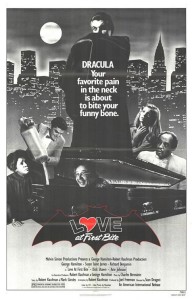 In The 40-Year-Old Critic, Venganza Media creator and host Arnie Carvalho recalls a memorable film for each year of his life. This series appears daily on the Venganza Media Gazette.
In The 40-Year-Old Critic, Venganza Media creator and host Arnie Carvalho recalls a memorable film for each year of his life. This series appears daily on the Venganza Media Gazette.
It’s not easy to choose a favorite film from 1979 — so many of that year’s films have influenced my life in one way or another, from The Muppet Movie, which solidified a love for the older-skewing Muppets, to Alien, which scared the pants off me (and Sigourney Weaver), to The Jerk (which may be Steve Martin’s finest ludicrous performance). And I cannot leave out Francis Ford Coppola’s mad masterpiece Apocalypse Now, which is certainly the most engaging and best-made film from 1979.
But while I always enjoy getting lost in the jungles of Coppola’s Vietnam, I didn’t see the film until adulthood, and it hasn’t shaped my life or my views.
The movie that did was a little George Hamilton horror spoof, Love At First Bite. The story tells of Dracula (George Hamilton) coming to (then) modern-day New York City to find his true love Mina Harker, who has been reincarnated as supermodel Cindy (Susan Saint James). His quest is thwarted by Cindy’s psychiatrist boyfriend Jeffrey Rosenberg (Richard Benjamin), who also just happens to be a descendant of Dracula’s nemesis van Helsing.
Barely in first grade, I was probably far too young to be watching Love At First Bite. I was too naieve to really understand all the references to the swinging seventies, and the meaning of the word “kinky.” More, the social commentary about urban youth rehabilitation, psychiatry, and religion was all mostly lost on me.
Yet I was enraptured by this movie. As I have mentioned in previous reviews, I have always been fascinated by horror. I was mesmerized by trailers on television for movies like Friday the 13th and Evil Dead. It was as if seeing them would be like reading from the Necronomicon itself, opening me to a world of demons and monsters. To an imaginative young boy that thought is rapturous, and terrifying. I would watch horror films through slatted fingers; I could not bear to see the monsters but I also could not look away. The few times I would try to watch horror films — including Frank Langella’s Dracula from this same year — I needed an adult nearby to protect me from the “evil” radiating from the screen.
But in Love at First Bite — here was a Dracula I could handle. Hamilton was sharing the screen with familiar faces like George and Weezie Jefferson (Sherman Hemsley and Isabel Sanford, respectively). He didn’t want to slaughter innocents, he wanted to be reunited with his centuries-old-love! He wasn’t turning people into ghastly, zombie-like minions, he was feeding on winos and getting drunk off their blood! I understood this Dracula to be silly.
Now, just because I thought he was funny didn’t mean I wasn’t also in awe of Dracula, his immortality and powers. His magical ability to transform into bats and dogs, and his thirst for blood, still held me in thrall. The movie didn’t intend it, but I must admit, I was slightly afraid of George Hamilton’s Dracula.
This was a movie that made horror accessible to a 6-year-old. It was the stepping stone for me between Sesame Street’s Count (always my favorite Muppet, as I secretly hoped one day he’d count the other Muppets on which he’d fed) and true horror killers like Freddy and Jason. I especially liked the crazy antics of Arte Johnson as Dracula’s servant Renfield, the actor throwing himself into the role with wild abandon.
I have since revisited Love at First Bite and can see its many flaws. The film is very much a product of its time. It’s a desperate Mel Brooks wannabe, attempting to be a vampire version of Young Frankenstein, but, strangely, adds the racist humor of Blazing Saddles. The jokes are dated and most don’t hold up, the effects are shoddy and obvious, and while the score is amazing, the best song in the movie — Alicia Bridges’ “I Love the Nightlife” — has been cut from home video releases due to rights issues. Still, some of the Dracula jokes, such as “Creatures of the night….shut up!” still make me giggle. Revisiting Love at First Bite in 2014 was not a rewarding experience and if this were a review for Now Playing Podcast, I’d struggle with giving it a recommend.
Yet this film helped me accept a dichotomy in my own mind that monsters could be frightening and alluring. Just as I was repulsed by — yet drawn to — horror films, Cindy was drawn to — yet frightened by — her undead on-screen lover. The fine line between terror and turn-on was revealed to me. It’s something I’d explore further in Hellraiser, but I recognize that I was first exposed to it by Love at First Bite.
In the 30-some years since I have read Bram Stoker’s original novel and watched countless versions of the quintessential vampire on screen, but when I think of Dracula, it’s George Hamilton that I picture in my mind. So for that long-lasting bite this film gave me, it is the film from 1979 that I remember most.
Next — 1980!
Arnie is a movie critic for Now Playing Podcast, a book reviewer for the Books & Nachos podcast, and co-host of the collecting podcasts Star Wars Action News and Marvelicious Toys. You can follow him on Twitter @thearniec
August 9, 2014 Posted by Arnie C | 40-Year-Old Critic, Movies, Now Playing Podcast, Podcasts, Reviews | 40-Year-Old Critic, Arnie, Comedy, Dracula, Entertainment, Film, George Hamilton, Love at First Bite, Movie, Movies, Now Playing, Now Playing Podcast, Podcasts, Review, Reviews, Vampire | 2 Comments
Now Playing soars on iTunes, Bleeding Cool covers ‘The 40-Year-Old Critic’
Venganza Media celebrated dual successes on Thursday, as Now Playing Podcast’s Guardians of the Galaxy review cracked the Top 5 on iTunes, while the company’s latest project — Arnie Carvalho’s The 40-Year-Old Critic — received a welcome reception from pop culture website BleedingCool.com.
“I love hearing people talk passionately about their interests, and there are fewer people that do so with as much vigor and resourcefulness as one Arnie Carvalho,” Bleeding Cool’s Jeremy Konrad wrote of the Venganza Media founder and Now Playing Podcast co-host.
In anticipation of his 40th birthday, Carvalho has been taking a look back at an influential film for every year of his life. That list includes hits like Jaws and E.T., but also notorious flops such as Popeye and Howard the Duck – the latter having previously been featured in one of Now Playing Podcast’s most famous episodes.
Konrad’s Q&A also covers the podcast’s popular donation shows, Carvalho’s toy collection, and Now Playing Podcast’s continued dominance of Apple’s iTunes podcast page.
Now Playing Podcast is currently featured in iTunes “What’s Hot” section, and on Thursday the review of Guardians of the Galaxy reached No. 3 on the Top 200 TV & Film episode chart. The review — released Monday — is the latest entry into Now Playing’s celebrated Marvel Comics Movie Retrospective Series, which began in 2011 and has covered every theatrical and television film featuring a Marvel superhero.
Now Playing Podcast is also wrapping up its Teenage Mutant Ninja Turtles retrospective, with the final film in the five-episode series scheduled for release Tuesday, Aug. 12.
https://venganzamedia.com/Gazette/2014/07/31/venganza-media-announces-the-40-year-old-critic-series/
August 8, 2014 Posted by Arnie C | 40-Year-Old Critic, Comic Books, Marvelicious Toys, Movies, News, Now Playing Podcast, Podcasts, Reviews, Site Information, Star Wars Action News | 40-Year-Old Critic, BleedingCool, Howard the Duck, Jeremy Konrad, Marvel, Marvelicious Toys, Movies, Now Playing, Now Playing Podcast, Press Release, Review, Star Wars, Star Wars Action News, Venganza Media | Comments Off on Now Playing soars on iTunes, Bleeding Cool covers ‘The 40-Year-Old Critic’
40 Year-Old-Critic: Superman (1978)
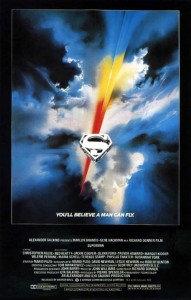 In The 40-Year-Old Critic, Venganza Media creator and host Arnie Carvalho recalls a memorable film for each year of his life. This series appears daily on the Venganza Media Gazette.
In The 40-Year-Old Critic, Venganza Media creator and host Arnie Carvalho recalls a memorable film for each year of his life. This series appears daily on the Venganza Media Gazette.
I look at 1978 as the middle-child of movie years. Moviegoers were still wowed by 1977’s Star Wars, which was continuing to play on many screens in’78. Lucas’ masterpiece had just set Hollywood on its own space race, but it took a couple of years for Lucas imitators and other sci-fi directors to get their films produced. As such, many of the sci-fi films I grew up with and celebrate as seminal were not released until 1979. But what about the year in-between? It had Dawn of the Dead, a smart mix of social commentary and horror, and Grease, which is a fun sing-a-long romp that I’ve watched more times than I can count. Still, neither changed my life nor my view of film. And please don’t bring up Jaws 2, Animal House, or Every Which Way But Loose. No, in 1978 there are only two films that resonated with me. The first was Halloween, an annual must-watch for me that iterated the Texas Chain Saw Massacre formula and is the father of the 80s slasher film. But its impact pales in comparison to the single 1978 movie that made me believe a man could fly — Superman: The Movie. I was 4 years old when this superhero film was released, but my parents took me to see this in theaters despite my young age. In one viewing my focus changed.
I’ve gone back and looked at family photo albums. From September ‘74 through November ‘78 all my photos were full of the usual childhood accouterments: I had PlaySkool’s wooden Sesame Street figures, clown items, Cookie Monster designs on my 4th birthday cake. You can see the changes after December ‘78. My clothes were no longer Big Bird T-Shirts, now they were superhero Underoos. Away went the baby PlaySkool toys and, in their place, was a collection of Mego Superheroes. And on my bedroom wall were two new posters: Lou Ferrigno as CBS’s The Incredible Hulk, and Christopher Reeve, arm pointing to the sky, advertising Superman: The Movie. Obviously, many films captured my imagination (and my parents’ dollars) as a child. That alone is not enough to warrant the title of Most Important Film of 1978. However, when I look at my life, and when I look at the hit movies of today, it’s impossible not to see the legacy of star Christopher Reeve and director Richard Donner. In the mid-70s superheroes were seen as campy entertainment for children. Comic books had long been stigmatized as pulp trash, and that reputation was solidified by the 1960s Batman TV series. Early drafts of Superman reflected that attitude as well (you can hear all about that in the Now Playing Podcast Superman review). But with this Superman film Donner saw an opportunity to make a more serious superhero adventure. He gave A-list stars Marlon Brando and Gene Hackman top billing, brought in state-of-the-art special effects, and allowed John Williams to create that emotional, rousing anthem for his hero. The result was a film that lived up to the promise on its poster, and as a 4-year-old I believed a man could fly. Admittedly, Superman did not completely abandon some campy scenes and performances; Ned Beatty’s Otis could have been teleported right from that 60s Batman series. Still, by taking the material as seriously as it did Donner and company created the first modern superhero film.
You can see the lineage: Superman begat 1989’s Batman, which begat The Crow five years later, which begat Blade in ‘98, which begat 2000’s X-Men (also produced by Donner), which begat 2002’s Spider-Man, which led to the creation of the Marvel Cinematic Universe, starting with Iron Man in 2008, and The Avengers four years later. And those are just the game changers. More than 100 other big-budget, major motion pictures follow Superman’s example of treating the material with respect and casting big-name stars as iconic comic characters. To this very day, almost every single superhero film is still following the mold created by Donner. As the Now Playing Podcast reviews show, the Superman series went downhill very quickly. Producers Alexander Salkind and Ilya Salkind fired Donner, and without his vision the series devolved into a Richard Pryor yuk-fest. It took Tim Burton’s Batman to remind Hollywood that audiences will turn out for a serious superhero film. Then, like Superman before it, the Batman series quickly collapsed when Burton moved on. It was finally Bryan Singer’s X-Men that ignited what has become the blockbuster movie genre of the 21st century. (Don’t get me started on what Singer did to Superman, you can hear my review of that travesty in the Now Playing Podcast archives.) As for me: seeing 1978’s Superman at such a young, impressionable age forever changed my world view. While I was never heavy into comic books, Superman turned me on to multimedia superheroes. My morning cartoons became filled with Batman and Spider-Man and Hulk, and every time there was a new comic-based television series or film I was in the audience.
I am forever chasing the sense of wonder I felt in 1978 when Clark Kent ripped open his shirt and I saw the bright red and yellow S. Better still, this is a good movie. Unlike Texas Chain Saw Massacre, which I don’t enjoy but which fathered films I love, Superman: The Movie is always a joy to watch. While the pacing (especially in the director’s cut) may bore some people, I love the character exploration and world-building that Donner indulges. This love of superhero movies would be a direct catalyst for the creation of Now Playing Podcast, a show that’s been downloaded by hundreds of thousands of people across the globe. The idea for what would become Now Playing came to me as I was leaving a screening of the Marvel Comics movie Ghost Rider, and our first review was Sam Raimi’s Spider-Man 3. The excitement for Marvel’s The Avengers kicked off Now Playing’s longest retrospective series, and turned the podcast into a weekly show as we revisited every Marvel movie, starting with George Lucas’ Howard the Duck.
It is also Marvel’s Iron Man 2 that made me a serious collector of comic book-related merchandise. That led to the creation of the podcast Marvelicious Toys and my sizable Marvel collection, full of movie-based Hot Toys figures, quarter-scale statues, and even some one-of-a-kind production materials from Howard the Duck. And while my collecting focus has been the Marvel films, I do own one single collectible from the DC universe: a Hot Toys figure of Christopher Reeve from 1978’s Superman. I own it not as a collector, but as a fan, and I display it in my home theater as a reminder that I still believe a man can fly.
Next — 1979!
Arnie is a movie critic for Now Playing Podcast, a book reviewer for the Books & Nachos podcast, and co-host of the collecting podcasts Star Wars Action News and Marvelicious Toys. You can follow him on Twitter @thearniec
August 8, 2014 Posted by Arnie C | 40-Year-Old Critic, Comic Books, Marvelicious Toys, Movies, Now Playing Podcast, Podcasts, Reviews | 40-Year-Old Critic, Arnie, Christopher Reeve, Comic Books, Comics, Enertainment, Film, Movie, Movies, Now Playing, Now Playing Podcast, Podcasts, Review, Reviews, Richard Donner, Superman | 6 Comments
40 Year-Old-Critic: Star Wars (1977)
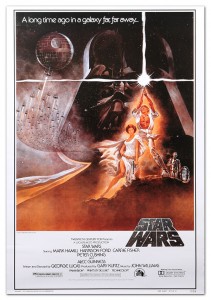 In The 40-Year-Old Critic, Venganza Media creator and host Arnie Carvalho recalls a memorable film for each year of his life. This series appears daily on the Venganza Media Gazette.
In The 40-Year-Old Critic, Venganza Media creator and host Arnie Carvalho recalls a memorable film for each year of his life. This series appears daily on the Venganza Media Gazette.
For each year of this series I spent quite a bit of time deciding which film was the most influential on my life. I read lists of all films released, as it’s certainly possible a low-grossing cult hit could have impacted me more than any blockbuster or award-winner. I spent at least 30 minutes researching every year before making my decision.
Well, every year except 1977.
I only half-jokingly ask: Were any movies released in 1977 other than Star Wars? More accurately, do any other films matter when stacked up against Star Wars? Looking at the year’s biggest films, there was Close Encounters of the Third Kind, which furthered Stephen Spielberg’s career and has legions of fans (I’m not one of them). The Woody Allen crowd will point to Oscar-winner Annie Hall. It’s an okay film but, to me, forgettable. Smokey and the Bandit and Oh, God! were products of their time, and neither aged well. Even that year’s James Bond release — The Spy who Loved Me — is a letdown.
But then there is Star Wars (and note, I refuse to call it A New Hope; when it came out in 1977 it was simply Star Wars). The film is more than a cultural phenomenon, it is a global icon. Star Wars transcends nationality, race, gender, and age. Everywhere I go, from Illinois to California to Germany to Spain to Mexico, I find Star Wars fans and collectibles.
It is not hyperbole to say Star Wars forever changed cinema. On a meager budget George Lucas’ team developed entirely new ways to film special effects. John Dykstra’s computer-controlled Dykstraflex camera allowed for dynamic, active shots of ships in space without use of visible fishing lines. The rapid-fire, Academy Award-winning editing — courtesy of Paul Hirsch, Richard Chew, and (George’s ex-wife) Marcia Lucas — created an excit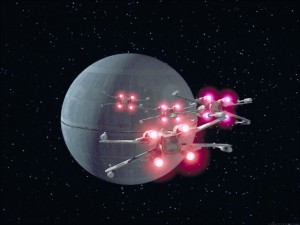 ing feel while trusting audiences to keep up with a story that starts in the middle of the action. Not only did Star Wars raise the bar for science-fiction and action spectacles, it quite literally and fundamentally changed the way movies were made.
ing feel while trusting audiences to keep up with a story that starts in the middle of the action. Not only did Star Wars raise the bar for science-fiction and action spectacles, it quite literally and fundamentally changed the way movies were made.
I have heard and read the complaints that Star Wars forever ruined movies by relying on hackneyed character tropes, choosing action over acting, and making audiences care more about the spectacle than the story.
I dismiss those comments as rhetoric. People love to lay blame, and there’s a hipster-coolness to attacking any cultural touchstone.
Yes, there are numerous Star Wars imitators that have taken these impulses to mind-numbing extremes, but that is the fault of each film’s creator. Star Wars simply showed moviegoers and movie-makers alike what could be done.
Personally, Star Wars was a film that would shape the way I view movies. As a child it made me believe in magic. In my late teens it introduced me to Campbellian mythological structure and archetypes. Honestly, it has — directly or indirectly — influenced every major decision of my life.
I’m told my parents took me to see Star Wars in 1977. I would have been 3, maybe 4 years old, and I have no memory of seeing it on the big screen.
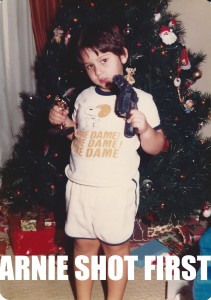 I do remember the toys. When I was still too young to read I saw a little green alien action figure (Greedo) in the toy aisle of our Kroger grocery store and I wanted him. My parents read this as me loving the film and started to buy me more figures in the toy line — which confused me at first. But over time I grew to understand not just the figures, but the movie which I watched in an endless loop for many years. Then I expanded to the video games (on the Atari 2600), Star Wars novels, role-playing games, and more.
I do remember the toys. When I was still too young to read I saw a little green alien action figure (Greedo) in the toy aisle of our Kroger grocery store and I wanted him. My parents read this as me loving the film and started to buy me more figures in the toy line — which confused me at first. But over time I grew to understand not just the figures, but the movie which I watched in an endless loop for many years. Then I expanded to the video games (on the Atari 2600), Star Wars novels, role-playing games, and more.
As the Star Wars sequels were released I became even more enthralled with the universe, and it is a love that never waned. In the late 80s, when Star Wars was in a lull, I still watched the movies and reread the books. In 1993 my college dorm held Star Wars Sundays. HBO seemed to play the trilogy every week, and I formed a bond with my fellow students through this shared childhood love.
It was Star Wars that led me to online forums. It was Star Wars that motivated me in 1996 to build my first personal website about the Star Wars toys I collected and the role-playing game I was running. In 2005, it was Star Wars that motivated me to look up the definition of a podcast, and then to dig an old microphone out of the closet and start my first show, Star Wars Action News.
Throughout the past nine years I have traveled across this country — and to Germany — taking part and speaking at several conventions. I have hosted sold-out Star Wars fan events and even presented on the Kotobukiya stage at San Diego Comic-Con.
I was honored to have StarWars.com claim my Star Wars collection was one of the largest in the world. I have had the honor of touring Lucasfilm, and even briefly met George Lucas himself. Since starting Star Wars Action News I’ve gone to new places, had new experiences, interviewed actors, producers and writers, and made dozens of new friends.
All of that goes back to this one film from 1977.
The truth is, without Star Wars you would not be reading this article. My love of Star Wars grew into a love of film, and my Star Wars podcasting grew into a network of podcasts that includes the movie review show Now Playing Podcast, which has become our most-downloaded show and a staple in the iTunes top TV & Film audio podcasts category.
As a film critic, Star Wars is the film by which I measure all other blockbusters. Transformers may have modern effects and louder explosions, but does it create the same sense of wonder in its audience? Is Sam Witwicky a suitable audience avatar — a hero in the vein of Luke Skywalker?
(Answer: he’s not. Listen to our Transformers Movie Review Retrospective to hear why.)
Now, I do realize every Star Wars film has its flaws, from wooden acting to redundant plot points to convenient character revelations. But I don’t care. I may be turning 40, but when I watch Star Wars I’m 6 years old again, and I love it.
Star Wars has shaped my life, and there is no other film from 1977 that can compete.
Tomorrow — 1978!
Arnie is a movie critic for Now Playing Podcast, a book reviewer for the Books & Nachos podcast, and co-host of the collecting podcasts Star Wars Action News and Marvelicious Toys. You can follow him on Twitter @thearniec
August 7, 2014 Posted by Arnie C | 40-Year-Old Critic, Movies, Now Playing Podcast, Podcasts, Reviews, Star Wars Action News | 1970s, 40-Year-Old Critic, Arnie, Enertainment, Force, George Lucas, Hasbro, Movie, Movies, Now Playing, Now Playing Podcast, Podcasts, Reviews, Star Wars, Star Wars Action News | 4 Comments
40 Year-Old-Critic: Carrie (1976)
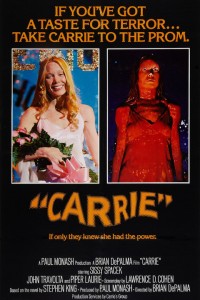 In The 40-Year-Old Critic, Venganza Media creator and host Arnie Carvalho recalls a memorable film for each year of his life. This series appears daily on the Venganza Media Gazette.
In The 40-Year-Old Critic, Venganza Media creator and host Arnie Carvalho recalls a memorable film for each year of his life. This series appears daily on the Venganza Media Gazette.
Last October, prompted by the release of the remake, Jakob, Stuart, and I reviewed 1976’s Carrie for Now Playing Podcast. It was the first film in our ongoing (with no end in sight) Stephen King Movie Retrospective. I came to that series a Stephen King fan, as I’ve followed his work since the mid 1980s. While researching Carrie for that review I realized I am likely only a Stephen King fan thanks to Brian DePalma’s film adaptation.
It’s not that I believe DePalma’s Carrie to be the best adaptation of a King novel, for proof you can listen to my thoughts in our Now Playing review. I think it’s a well-crafted and enjoyable film, but some poor characterizations and pacing issues prevent me from heralding it as the best King film to date.
I think Carrie’s greatest achievements took place off-screen.
King’s debut novel was published in April 1974, five months before I was born. Carrie sold well — especially in paperback — and secured the author a multi-book deal, but its overall performance was not exceptional. Even a year later, with the release of his second novel, Salem’s Lot, King was still not a household name. All of that changed in ‘76 when Carrie hit theaters. DePalma took that story, added his visual style and a Hitchcockian score, and the result was an Academy Award-nominated film.
I have no doubt that the success of Carrie in theaters gave King the boost he needed to achieve critical mass and have his first hardcover bestseller in 1977 with The Shining.
 It helps that King is a prolific storyteller, and I’ve always believed his appeal comes from engaging stories filled with relatable characters. No cinematic success can turn a poor writer into one of the bestselling authors of all time. But with Carrie, a spotlight was shone on King. He was exposed to a broader audience than the bookstore shelves could ever provide. De Palma opened the door and King had the talent to walk through it.
It helps that King is a prolific storyteller, and I’ve always believed his appeal comes from engaging stories filled with relatable characters. No cinematic success can turn a poor writer into one of the bestselling authors of all time. But with Carrie, a spotlight was shone on King. He was exposed to a broader audience than the bookstore shelves could ever provide. De Palma opened the door and King had the talent to walk through it.
The result is publishing history. I grew up going to schools where it seemed every third student was reading a Stephen King novel. Not only were my friends engrossed in the pages, but the parents of my friends were also reading King. I was enthralled. As a child drawn to horror — and simultaneously terrified of it — I couldn’t not read these books.
The first book I read was Carrie, suggested to me by lifelong friend and fellow Now Playing host Stuart. A few weeks after finishing the novel I saw De Palma’s film for the first time, and I became a Stephen King fan. He was the first author whose name would make me immediately interested in a book.
King has published 64 novels — most of them bestsellers — as well as countless short stories, and I have read most of them. I continue to read King as I enter my 40th year, and will continue through my 41st, 42nd, and so on, until one of us dies. I’m also reviewing every widely-published Stephen King story on our Books & Nachos podcast. As I write this I’m also working on a review of his ‘78 masterpiece, The Stand.
And it all goes back to DePalma’s Carrie. Without that film, it’s possible King would have been one of 1,000 authors who publish countless books for their niche audience, but never gain widespread attention. That film was a cultural phenomenon that shaped me as a person.
Tomorrow — 1977!
Arnie is a movie critic for Now Playing Podcast, a book reviewer for the Books & Nachos podcast, and co-host of the collecting podcasts Star Wars Action News and Marvelicious Toys. You can follow him on Twitter @thearniec
August 6, 2014 Posted by Arnie C | 40-Year-Old Critic, Now Playing Podcast, Podcasts, Reviews | 40-Year-Old Critic, Academy Award, Arnie, Book, Brian DePalma, Carrie, Fiction, horror, Novel, Now Playing Podcast, Oscar, Review, Stephen King, Telekenesis | 3 Comments
40 Year-Old-Critic: Jaws (1975)
 In The 40-Year-Old Critic, Venganza Media creator and host Arnie Carvalho recalls a memorable film for each year of his life. This series appears daily on the Venganza Media Gazette.
In The 40-Year-Old Critic, Venganza Media creator and host Arnie Carvalho recalls a memorable film for each year of his life. This series appears daily on the Venganza Media Gazette.
My childhood was defined by the summer blockbuster. Each year I can think of one, and only one, major movie that held me — and the entire country it seemed — in its thrall. E.T. (1982), Return of the Jedi (1983), Jurassic Park (1993), Independence Day (1996), the list goes on. Each year there seemed to be one film that unified audiences, and I could discuss this film with everyone I met. I never thought about why this was the case, it simply was a fact.
What I didn’t realize for more than thirty years was that the summer blockbuster phenomenon had not always been, but rather started just before my first birthday with the release of Steven Spielberg’s Jaws.
The director’s breakthrough film didn’t have an immediate impact on me. Jaws had become part of our cultural lexicon by the time I was able to speak. John Williams’ theme music was omnipresent in films and television, the film’s dialogue was quoted regularly, and the ride was a staple at Universal Studios theme park. As such, I never felt the need to watch Jaws — I figured pop culture had exposed me to all I needed to know. I even saw Jaws 3D before viewing the Spielberg original, the red-and-blue gimmick glasses drawing me in 1983.
Finally, in 2011, as part of Now Playing Podcast’s Spring Donation Drive (an exclusive series for donors) I watched the original Jaws and realized I only thought I knew that movie.
Jaws is not just Spielberg’s breakthrough picture, it’s the original blueprint for the stereotypical “Steven Spielberg Film.” Though it’s based on Peter Benchley’s novel, Spielberg initiated several rewrites to the script to make the film more fun, the characters more likable, and the ending more explosive.
T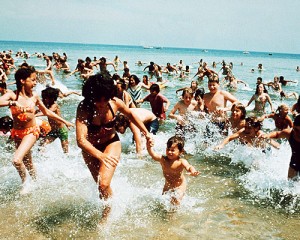 he story follows Amity Island Police Chief Martin Brody (Roy Scheider), a man who must defend his family and his town from a man-eating shark. While the story is presumably about the hunt for the shark, the film focuses more on Amity Island town politics and Brody’s relationship to his wife and children. Creating relatable character drama with a backdrop of extraordinary events is the hallmark of Spielbergian filmmaking, and it all started here with a shark tale.
he story follows Amity Island Police Chief Martin Brody (Roy Scheider), a man who must defend his family and his town from a man-eating shark. While the story is presumably about the hunt for the shark, the film focuses more on Amity Island town politics and Brody’s relationship to his wife and children. Creating relatable character drama with a backdrop of extraordinary events is the hallmark of Spielbergian filmmaking, and it all started here with a shark tale.
The result became his cinematic template — the way Amity Island is made real with its cast of colorful characters is echoed in Spielberg films I had seen throughout my childhood, films like E.T., Poltergeist, Gremlins and Goonies. I was dumbstruck when I realized that with Jaws, Spielberg created a narrative that he would copy, and see imitated by others, for decades.
The impact of Jaws, obviously, was felt even more at the box office. It changed moviegoing forever. Until that summer, Hollywood viewed the winter months as the time to release its blockbuster films; summer was a dumping ground for under-performers. But first with Jaws and, a few years later, Star Wars, Hollywood studios began to program the “summer movie.” More, the summer blockbuster had a type: high-concept, audience-pleasing characters, ever-improving special effects.
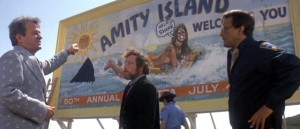 These films captivated moviegoers year-after-year, and throughout the 1980s I was one of the summer masses going to theaters for every big opening day. It was the heirs to Jaws’ legacy that made me love movies.
These films captivated moviegoers year-after-year, and throughout the 1980s I was one of the summer masses going to theaters for every big opening day. It was the heirs to Jaws’ legacy that made me love movies.
It took me 36 years to get around to watching Jaws, but when I did I immediately recognized that this film’s DNA was passed on to all of the favorite films from my youth.
Tomorrow — 1976!
Arnie is a movie critic for Now Playing Podcast, a book reviewer for the Books & Nachos podcast, and co-host of the collecting podcasts Star Wars Action News and Marvelicious Toys. You can follow him on Twitter @thearniec
August 5, 2014 Posted by Arnie C | 40-Year-Old Critic, Now Playing Podcast, Podcasts, Reviews | 40-Year-Old Critic, Arnie, Jaws, Now Playing, Now Playing Podcast, Review, Shark, Steven Spielberg, Summer Blockbuster | 6 Comments
Guardians of the Galaxy
When teased at the end of Thor: The Dark World, the Guardians of the Galaxy looked like a bunch of a-holes. But this past weekend Star-Lord, Gamora, Drax, Rocket Raccoon, and Groot proved their worth with a heroic opening weekend at the box office. More than just money, the film has been a hit with audiences and critics alike. What is the magic that made this film blow up like a ch-ch-ch-ch-cherry bomb, and were the hosts of Now Playing won over by this charming band of outlaws? Listen to Arnie, Stuart, and Jakob in this review to find out!
Arnie C: http://traffic.libsyn.com/nowplayingpodcast/NPPAVENGERS10.mp3
August 4, 2014 Posted by arniec | Movies, Now Playing Podcast, Podcasts, Reviews | Enertainment, Film, Movies, Now Playing Podcast, Podcasts, Reviews | Comments Off on Guardians of the Galaxy
40 Year-Old-Critic: The Texas Chain Saw Massacre (1974)
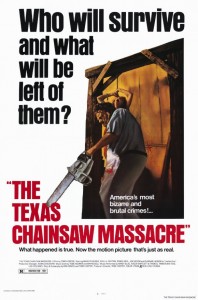 In The 40-Year-Old Critic, Venganza Media creator and host Arnie Carvalho recalls a memorable film for each year of his life. This series appears daily on the Venganza Media Gazette.
In The 40-Year-Old Critic, Venganza Media creator and host Arnie Carvalho recalls a memorable film for each year of his life. This series appears daily on the Venganza Media Gazette.
I was born in 1974, and if my parents took me to a movie that year I have no memory of the trip. In the 40 years since, I’ve caught up on many of the classics from that year such as The Godfather Part II, Blazing SaddlesThe Conversation, and Young Frankenstein. But, truthfully, none of those pictures shaped my life nearly as much as the small indie film The Texas Chain Saw Massacre.
Of course, I didn’t see this film in its original release. I was only 19 days old when Texas Chain Saw hit theaters. And while my parents were pretty lax with the content of movies I watched or books I read, even they would have had serious concerns about my watching teens carved up for food. I got into true, hard R-rated horror films when I turned 12, and the constant Chain Saw references in the 1987 Mark Harmon film Summer School had me finally rent this grindhouse film on VHS.
I was unimpressed.
I had built Leatherface up in my mind as a Freddy, a Jason, or a Michael Myers. But, in truth, Leatherface had none of the slick, commercial appeal of those later imitators. As such, the film was less fun for me as a teen. I later returned to Texas Chain Saw in 2010 for Now Playing Podcast’s retrospective series and, to the shock of many listeners, I gave it a red arrow. The cacophonic score, annoying performances, and dirty, low-budget look of the film still made it a movie I couldn’t enjoy. I labeled it “horror homework” — great for aficionados of the genre but not a film I’d recommend for the masses.
But while I may not recommend watching the film I truly recognize there are few films more important than this. It is no exaggeration to say that without The Texas Chain Saw Massacre the horror films I love may never have come to be.
First, Texas Chain Saw was a hugely successful film, costing only $300,000 to make and grossing over $30 million at the US box office (which, per BoxOfficeMojo is more than $131 million adjusted for inflation). This showed studios that inexpensive horror films could make bank.
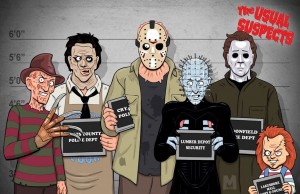 In addition to showing studios a pathway to profit, Texas Chain Saw also inspired screenwriters and directors. This film, along with Alfred Hitchcock’s Psycho, provided a template for the “slasher” sub-genre of film, combining a masked killer with an iconic weapon Later horror films like Halloween, Friday the 13th, A Nightmare on Elm Street, and even Scream and I Know What You Did Last Summer, all series that I love, took this formula and refined it for even greater success. And Leatherface’s greatest successor may just be Hannibal Lecter, another cinematic cannibal that has captured my imagination.
In addition to showing studios a pathway to profit, Texas Chain Saw also inspired screenwriters and directors. This film, along with Alfred Hitchcock’s Psycho, provided a template for the “slasher” sub-genre of film, combining a masked killer with an iconic weapon Later horror films like Halloween, Friday the 13th, A Nightmare on Elm Street, and even Scream and I Know What You Did Last Summer, all series that I love, took this formula and refined it for even greater success. And Leatherface’s greatest successor may just be Hannibal Lecter, another cinematic cannibal that has captured my imagination.
More, this film launched director Tobe Hooper into the spotlight, paving the way for him to direct Poltergeist, another seminal horror film of the haunted house variety. (And yes, we discussed how much influence Hooper had on Poltergeist in Now Playing Podcast’s 2011 Spring Donation Drive. Those podcasts are no longer available.)
While this film doesn’t click with me as entertainment, I credit Texas Chain Saw for paving the way for later horror films I love. This film was born the same time I was, and without it I would not be the man, or the movie critic, I am today.
I do, however, stand by that red arrow. As I found out when I was 13, this isn’t a film I can recommend for those looking for the same glossy thrill given by Friday the 13th Part VI. It is not a Hollywood production and it shows. But while I can’t recommend it, I love it for the future films it enabled.
Tomorrow — 1975!
Arnie is a movie critic for Now Playing Podcast, a book reviewer for the Books & Nachos podcast, and co-host of the collecting podcasts Star Wars Action News and Marvelicious Toys. You can follow him on Twitter @thearniec
August 4, 2014 Posted by Arnie C | 40-Year-Old Critic, Now Playing Podcast, Podcasts, Reviews | 40-Year-Old Critic, Arnie, Freddy, horror, Leatherface, Michael Meyers, Now Playing, Now Playing Podcast, Review, Texas Chain Saw Massacre, Texas Chainsaw Massacre, Tobe Hooper | 10 Comments
The 40-Year-Old Critic – Introduction
 In exactly 40 days I turn 40 years old.
In exactly 40 days I turn 40 years old.
That milestone is not one without heft. If the actuarial tables for American males are to be believed, I’m likely at least halfway through my time on this planet. Each day I am probably closer to my death than to my birth. Now is the time to start measuring life by the things I’ll never do instead of the things I could do. It’s a time to reflect on what has been and determine what will be for the rest of my days.
The usual things come to mind when I ponder my life thus far: My loving, supportive, smart, and funny wife, Marjorie. My long-time best friend, Stuart. My godparents, who helped raise me and taught me to be analytical. My sister, who exposed me to literature and deconstructionist themes. My father, who gave me a cynical view, a strange sense of humor, and a love of classical music.
But what all these people have in common is a strong memory of watching films together; sitting in a dimly lit cinema, absorbed by the images on the screen.
Marjorie and I have seen so many films together that I doubt I could compile a comprehensive list. but a few stand out. Our first film as a married couple, watched in a midnight release on our honeymoon, was Star Wars: Attack of the Clones. The projector broke. We sat for 3 hours past the planned midnight start time before the movie began. I can still sing that New Orleans’ theater’s jingle for popcorn and candy, which played on a loop the entire time.
Another memorable movie trip was to see Richard Linklater’s Before Sunset. It was a limited release so we had to drive 4 hours each way just to watch the film, and I was so tired on the return trip we had to get a hotel.
I remember Ocean’s 11 — a movie with such a strong feel-good vibe that it saved our Sunday. We walked into the theater in the most sour of moods, and left extremely happy.
I remember watching Fight Club on video. Marjorie was tired so she went to sleep, and the next day all I could talk about was how she had to see that film–the first movie that I felt she and I had to share as a couple versus being able to experience on my own.
Stuart and I have seen films together since 1982. I remember going with him to see E.T.: The Extra-Terrestrial and Return of the Jedi. Many more movies followed, but there are standouts. Charlie Sheen’s The Wraith, which we saw hoping for horror but got car races and heavy metal instead. We hated it at the time, but I later came to love this film for what it was (and the Sherilyn Fenn waterfall scene). We saw The Gate the weekend it opened, and bemoaned our choice for days. Not all the movies we watched were terrible — I first saw The Godfather trilogy in Stuart’s Chicago apartment, and he introduced me to Apocalypse Now and Blade Runner as part of a film noir marathon we had together as teens.
For years Stuart and I had a standing Christmas night movie appointment. He was in town to spend the holiday with family, and so a dinner of Chinese food and a movie viewing was had. Jackie Brown was the most memorable of those Christmas viewings, and we had wildly different reactions to Quentin Tarantino’s Pulp Fiction follow-up.
But from European Vacation to Jaws 3-D to The Devil’s Rejects, Explorers, JFK, The Lawnmower Man and hundreds more, Stuart and I are still going to movies together.
My sister Susan took me to see my first R-rated film, Beverly Hills Cop. She also exposed me to many movies I’d have not seen in my youth without her influence, including Ghostbusters and Lady and the Tramp. She is much older than I, so our movie time together has been sparse, but always memorable, including E.T., Return of the Jedi, and Bridget Jones’ Diary. (Though she staunchly refused to join me for a Hellraiser marathon.)
Yes, throughout the years my romantic, familial, and friend relationships have all involved, and in some ways been shaped by, movies. Sometimes there is no quicker way to look into a person’s soul than to ask what films they cherish. So it seems appropriate that to celebrate my 40th birthday I look back at 40 years of cinema.
Each day, from now until my birthday on September 12th, I will post an article looking back at the one film from each year of my life that impacted me most. This may not be my favorite film, it may not even be a film I like, but the one that had the longest-lasting impact on me and helped shape my view of the world.
I hope you’ll join me each day as I reflect on my lifetime of cinema.
August 3, 2014 Posted by Arnie C | 40-Year-Old Critic, Movies, Now Playing Podcast, Podcasts | 40-Year-Old Critic, aging, Apocalypse Now, Arnie, Arnie Carvalho, Attack of the Clones, Before Sunset, Beverly Hills Cop, Blade Runner, Bridget Jones' Diary, death, E.T., European Vacation, Explorers, Fight Club, Film, Ghostbusters, Hellraiser, Jackie Brown, Jaws, Jaws 3-D, JFK, Lady and the Tramp, Marjorie, Movies, Now Playing Podcast, Ocean's 11, Podcasts, Pulp Fiction, Return of the Jedi, Richard Linklater, Star Wars, Stuart, Stuart in LA, Susan, The Devil's Rejects, The Gate, The Godfather, The Lawnmower Man, The Wraith | 9 Comments
Venganza Media Announces ‘The 40-Year-Old-Critic’ Series
‘Now Playing Podcast’ host Arnie Carvalho pens a personal 40-film retrospective for his 40th birthday
 SPRINGFIELD, Ill – As Now Playing Podcast continues its remarkable run on iTunes’ Top 10 TV & Film podcast rankings, creator and host Arnie Carvalho is marking his 40th birthday with a written retrospective of 40 films that influenced his life and career. The series, titled The 40-Year-Old Critic, will be published daily on Now Playing’s sister website, Venganza Media Gazette, beginning Monday, Aug. 4.
SPRINGFIELD, Ill – As Now Playing Podcast continues its remarkable run on iTunes’ Top 10 TV & Film podcast rankings, creator and host Arnie Carvalho is marking his 40th birthday with a written retrospective of 40 films that influenced his life and career. The series, titled The 40-Year-Old Critic, will be published daily on Now Playing’s sister website, Venganza Media Gazette, beginning Monday, Aug. 4.
“Our podcast listeners frequently share that they enjoy when the Now Playing hosts provide personal anecdotes in addition to movie reviews, this series will deliver just that.” Carvalho said. “This series will help our listeners understand a bit more why I give the recommendations I do and I hope they’ll be interested and amused by these articles”
The 40-Year-Old Critic will launch with Carvalho’s take on 1974’s The Texas Chain Saw Massacre, with successive articles covering a single film from each year of his life. Stepping away from the microphone will also give Carvalho a chance to analyze films unlikely to appear on Now Playing Podcast, including the Robin Williams box-office bomb Popeye, cult classic Pump Up the Volume, and the Star Wars saga.
About Now Playing Podcast
From its humble beginnings in 2007 as a short-form, off-the-cuff movie review podcast, Now Playing Podcasthas grown into one of the most-celebrated independent shows on iTunes. Its success is largely attributed to the appeal of its hosts and Now Playing’s highly-acclaimed retrospective format, keeping listeners engaged for months and years as the hosts maneuver Hollywood’s hectic film schedule.
Venganza Media launched in 2005 and is the driving force behind the No. 1 podcast for Star Wars collectors, Star Wars Action News, Marvelicious Toys, and frequent iTunes Top 10 podcast Now Playing Podcast. The company, which currently produces six podcasts, is based in Springfield, Illinois.
For more information, contact Venganza Media.
July 31, 2014 Posted by Arnie C | 40-Year-Old Critic, Movies, News, Now Playing Podcast, Podcasts, Reviews | 2 Comments
New Podcast: Dawn of the Planet of the Apes – A Podcast Preview
Dawn of the Planet of the Apes was one of 2014’s most hotly-anticipated movies. That is quite a boost for the cerebral franchise that had lain dormant for 28 years before the disastrous 2001 remake. That all changed with 2011’s Rise of the Planet of the Apes which introduced Caesar and his smart apes to a new generation of moviegoers, and excitement built in the past 3 years to launch this newest film to a strong opening and the next sequel already in development for a 2016 release. Could this newest Planet of the Apes film be the best yet? If you donate and support Now Playing in the next 2 weeks you can listen and find out!
: http://nowplayingpodcast.com/Podcasts/NPPPOTA08TEASE.MP3
Category: Movies & Film
July 30, 2014 Posted by Arnie C | Movies, Now Playing Podcast, Podcasts, Reviews | Enertainment, Film, Movies, Now Playing Podcast, Podcasts, Reviews | Comments Off on New Podcast: Dawn of the Planet of the Apes – A Podcast Preview
TMNT
The Teenage Mutant Ninja Turtles return to their animated roots for 2007’s computer-rendered TMNT. With a complex plot that spans millennia, involves an immortal Aztec and his stone statue generals, and thirteen random monsters of urban legend, do the turtles stick their heads out long enough to matter? Listen to Arnie, Jakob, and Stuart’s review to find out!
Arnie C: http://traffic.libsyn.com/nowplayingpodcast/NPPTMNT04.mp3
July 28, 2014 Posted by arniec | Movies, Now Playing Podcast, Podcasts, Reviews | Enertainment, Film, Movies, Now Playing Podcast, Podcasts, Reviews | Comments Off on TMNT
Teenage Mutant Ninja Turtles III
The Teenage Mutant Ninja Turtles’ Excellent adventure continue with their third live-action film. It’s a New York Ninja in Lord Norinaga’s Court when the teens time travel to feudal Japan. Is this Turtles in Time plot a Quantum Leap forward for this film series? It’s Judgement Day for Leonardo, Donatello, Michelangelo, and Raphael, so listen to this podcast review to find out!
Arnie C: http://traffic.libsyn.com/nowplayingpodcast/NPPTMNT03.mp3
July 21, 2014 Posted by arniec | Movies, Now Playing Podcast, Podcasts, Reviews | Enertainment, Film, Movies, Now Playing Podcast, Podcasts, Reviews | Comments Off on Teenage Mutant Ninja Turtles III
Teenage Mutant Ninja Turtles II: The Secret of the Ooze
Teenage Mutant Ninja Turtles II: The Secret of the Ooze was a sure thing. The original became the most profitable independent film of all time, the toys were still selling well, and the Turtles were even touring the country with a musical stage show. Add in chart-topping rapper Vanilla Ice with his Ninja Rap, plus new mutants for the Turtles to fight, it couldn’t go wrong. Or could it? Join Stuart, Jakob, and Arnie this week to find out with their Oozing review of the second Turtles film!
Arnie C: http://traffic.libsyn.com/nowplayingpodcast/NPPTMNT02.mp3
July 14, 2014 Posted by arniec | Movies, Now Playing Podcast, Podcasts, Reviews | Enertainment, Film, Movies, Now Playing Podcast, Podcasts, Reviews | Comments Off on Teenage Mutant Ninja Turtles II: The Secret of the Ooze
New Podcast: Rise of the Planet of the Apes – A Podcast Preview
More than a decade after Tim Burton’s film failed to make audiences go Ape Fox tried again to revive their historic franchise. Rather than again revisit the story from the original novel writers Rick Jaffa and Amanda Silver and director Rupert Wyatt decided to retell the story of how Apes began their conquest of Earth–a story previously told in 1972’s Conquest of the Planet of the Apes. The result–Rise of the Planet of the Apes–was a critical success and box-office hit, leading to this summer’s hotly anticipated Dawn of the Planet of the Apes. How does this film hold up a few years later, and is James Franco a suitable mad scientist? If you donate and help keep Now Playing Podcast going you can listen now and find out!
: http://nowplayingpodcast.com/Podcasts/NPPPOTA07TEASE.MP3
Category: Movies & Film
July 11, 2014 Posted by Arnie C | Movies, Now Playing Podcast, Podcasts, Reviews | Enertainment, Film, Movies, Now Playing Podcast, Podcasts, Reviews | Comments Off on New Podcast: Rise of the Planet of the Apes – A Podcast Preview
New Podcast: Speed Racer – A Podcast Preview
After completing their R-rated Matrix trilogy the Wachowski Brothers sought to make a film suitable for a wider audience. They choose to make the big screen adaptation of the Japanese anime show Speed Racer. The film had broken down in development hell for over a decade, but with the Wachowskis in the driver’s seat the film went on the fast-track. But the film stalled right out of the gate. Did this movie deserve its fate, or should it get a jump start on home video? The answer is found in this bonus podcast for Now Playing donors! So to hear it, as well as our Matrix reviews, Donate to Now Playing to find out! Go, Now Playing, go!
: http://nowplayingpodcast.com/Podcasts/NPPSPEEDRACERTEASE.MP3
Category: Movies & Film
July 11, 2014 Posted by Arnie C | Movies, Now Playing Podcast, Podcasts, Reviews | Enertainment, Film, Movies, Now Playing Podcast, Podcasts, Reviews | Comments Off on New Podcast: Speed Racer – A Podcast Preview
Teenage Mutant Ninja Turtles (1990)
Leonardo. Donatello. Michelangelo. Raphael. To an art student these names may conjure the image of the Renaissance masters but to generations of children these name mean only one thing–Teenage Mutant Ninja Turtles! With the new film in theaters soon the Now Playing Podcast hosts Arnie, Stuart, and Jakob don their masks, grab their weapons, and review all the Turtles’ theatrical features! The first film to star these adolescent anthropomorphised amphibians came out in 1990 with Jim Henson’s creature shop giving the Turtles life, but is it full of Turtle Power? Listen to find out!
Arnie C: http://traffic.libsyn.com/nowplayingpodcast/NPPTMNT01.mp3
July 7, 2014 Posted by arniec | Movies, Now Playing Podcast, Podcasts, Reviews | Enertainment, Film, Movies, Now Playing Podcast, Podcasts, Reviews | Comments Off on Teenage Mutant Ninja Turtles (1990)
Review: The LEGO Movie — Everything Isn’t Awesome.
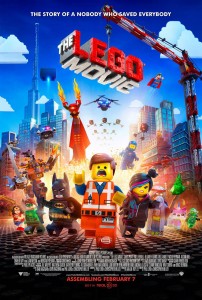 The rise of LEGO from brick-building toy to multimedia empire has been fascinating to watch. For almost 50 years LEGO was a staple in every boy’s toy box, but that’s where it ended. In the 1990s, though, LEGO started to branch out with video games, television specials, and more. As an adult Star Wars and Marvel LEGO collector I’ve watched with great interest as the toy company produced several amusing TV episodes and the video games, though some of their productions clicked with me more than others (the recent Marvel Superheroes: Maximum Overload was a rare misstep). Still, I always saw LEGO as leveraging their licensed titles for multimedia projects rather than creating their own characters and situations.
The rise of LEGO from brick-building toy to multimedia empire has been fascinating to watch. For almost 50 years LEGO was a staple in every boy’s toy box, but that’s where it ended. In the 1990s, though, LEGO started to branch out with video games, television specials, and more. As an adult Star Wars and Marvel LEGO collector I’ve watched with great interest as the toy company produced several amusing TV episodes and the video games, though some of their productions clicked with me more than others (the recent Marvel Superheroes: Maximum Overload was a rare misstep). Still, I always saw LEGO as leveraging their licensed titles for multimedia projects rather than creating their own characters and situations.
As such, I wondered what plot could propel The LEGO Movie. LEGO has no characters, their sets exist to stimulate the imagination of the builder. Despite having a strong voice cast, including Morgan Freeman, Will Ferrell, Elizabeth Banks, Will Arnett, Liam Neeson, and Guardians of the Galaxy‘s Chris Pratt, this is a movie I would likely have skipped were it not for the strong word of mouth. On Twitter, Facebook, and elsewhere I read great praise for The LEGO Movie and so I decided to give it a chance.
Thirty minutes into the film I was regretting that choice.
As I’ve heard nothing but praise sung from the heavens since The LEGO Movie opened I do realize mine may be a minority opinion. That said, I cannot get past the film’s rote storyline. The movie follows Emmet Brickowski (Pratt), a LEGO minifigure who’s only remarkable quality is how average he is. Early in the film the character’s desire to build friendships comes off desperate and pathetic. The film quickly introduces other stock characters including the love interest, the bad guy, and the henchman, and even an eight-year-old could see where this story was going.
But only a child who skipped his Ritilin would want to see it through. The loud, garish editing of the film’s opening could appeal only to the most ADHD-addled minds. Worse, the opening montage is a musical number set to the irritating Disney Radio-esque earworm “Everything is Awesome.” One-third of the way into the film I strongly considered turning it off and forfeiting my $5 iTunes rental fee. LEGO had finally created their own characters, but failed to create a single one I wanted to watch on screen.
Then Batman showed up.
I have seen Batman save thousands of lives in television and film, but no rescue is more impressive than the way The Dark Knight (voiced by Will Arnett) salvages The LEGO Movie. Soon after Batman appears more LEGO licensed properties arrive, from Star Wars to the LEGO NBA All-Stars to “Middle Zealand” (did Weta not want to share in the fun by letting LEGO use the name Middle Earth). While the story of The LEGO Movie was beyond repair, the inclusion of these licensed LEGO characters brought to the film some of the winking, good-natured fun I had seen in the licensed LEGO games and TV specials. Finally some of the jokes really started to hit (the one about Batman only using black or dark gray bricks was one of the laugh-out-loud moments in the film).
Anyone who has seen Toy Story could figure out where this movie was going, especially when real-world, non-LEGO items like Band-Aids, golf balls, and Krazy Glue start to appear. Yet despite figuring out the world these LEGO builders had crafted, even I was shocked by the schmaltzy, live action ending the film had in store.
The true irony is that the film seems to be mocking commercialism while, at the same time, being a giant commercial. The song “Everything is Awesome” epitomizes this theory–it’s mocked in the film for its banality, while the movie plays it endlessly and sells it as the title track on the movie soundtrack. More, a LEGO movie exists to sell kids LEGO toys–there are LEGO Movie licensed building sets. As such, the hypocrisy on display with the film’s demonization of commercial culture is astounding.
In the end, LEGO is a pretty average film. It has a strong “believe in yourself” message that I’m sure is great for those of single-digit ages, but unlike some of the Pixar or recent Disney animated films I felt LEGO lacked in broad appeal. Perhaps this is because I was never deep into LEGO (though I did own the red and blue spacemen in the 80s). The only thing that saved this movie for me was the humor. Superman’s loathing of Green Lantern was a high point (especially given how Warner Bros. has seemingly disavowed the Ryan Reynolds film) as was the mispronunciation of everyday items.
Because I did laugh out loud several times during this film I give it a RECOMMEND, but this film, like its main character, is nothing special.
As for that ending, I have a personal story to share
SPOILER ALERT
The most shocking thing about the film is that, in the end, it is a corporate statement against those who want to glue their LEGO sets together. Unlike many toy companies who are happy to have customers buy and collect their toys for whatever reason, The LEGO Movie states clearly there is a right way and a wrong way to play with LEGO.
As stated earlier I am an adult LEGO collector. I spent a week building a LEGO Star Wars AT-TE and had it on display for quite some time, though I’d sometimes return to find bricks had fallen off. After moving to a new house I unpacked my AT-TE to find it as a pile of bricks not too unlike what had originally come in the box.
Frustrated by this, in 2009 while covering a toy event I asked a LEGO Master Builder which glue they recommended to keep LEGO sets whole. The LEGO builder refused to recommend a glue and said the intent of LEGO is to build them again and again. I pressed on the issue, though, pointing out the impressive display LEGO had. I asked, honestly curious, if that was built on-site. He admitted that the set was built and transported. Though he wouldn’t admit the displays were glued, it was strongly implied. Eventually he relented and told us that most forms of super-glue will keep the sets together.
But now I see that corporate anti-glue attitude on display in a full film. I wonder if I was the only one audacious enough to ask a Master Builder how to glue my sets together or of the question may be common. Now, rather than have to answer us one-by-one LEGO has answered as a company with this movie.
July 5, 2014 Posted by Arnie C | Movies, Now Playing Podcast, Podcasts, Reviews | Animation, Batman, Kids, LEGO, LEGO Movie, Movie, Review, Star Wars | 1 Comment
Transformers: Age of Extinction
Podcastbots, prepare to roll out! The Transformers are back in Age of Extinction, the fourth live-action robot fight-fest from high-octane director Michael Bay. With the biggest movie opening in 2014 audiences obviously turned out in droves for the carnage, but did Now Playing hosts Jerry, Stuart, and Arnie go along for the ride? Listen to find out!
Arnie C: http://traffic.libsyn.com/nowplayingpodcast/NPPTF05.mp3
June 30, 2014 Posted by arniec | Movies, Now Playing Podcast, Podcasts, Reviews | Enertainment, Film, Movies, Now Playing Podcast, Podcasts, Reviews | Comments Off on Transformers: Age of Extinction
-
Archives
- February 2021 (1)
- January 2021 (1)
- December 2020 (1)
- November 2020 (3)
- October 2020 (2)
- September 2020 (1)
- August 2020 (2)
- July 2020 (1)
- June 2020 (1)
- May 2020 (1)
- April 2020 (3)
- March 2020 (2)
-
Categories
-
RSS
Entries RSS
Comments RSS
Site info
Venganza Media GazetteTheme: Andreas04 by Andreas Viklund. Get a free blog at WordPress.com.




